The many conflicts in the previous decades had seen the plebians grow poorer and their farms fall into disrepair. On the other hand, the landed aristocracy was having a field day, buying up bankrupt farms. The result was that masses of unemployed plebeians soon began to flood into Rome, and with them support for the candidate which offered them the most.
The Gracchi brothers were two of the most radical reformers, and while they initially had great success they were both eventually defeated and their reforms repealed. This would later result in the devestating war known as the Social War.
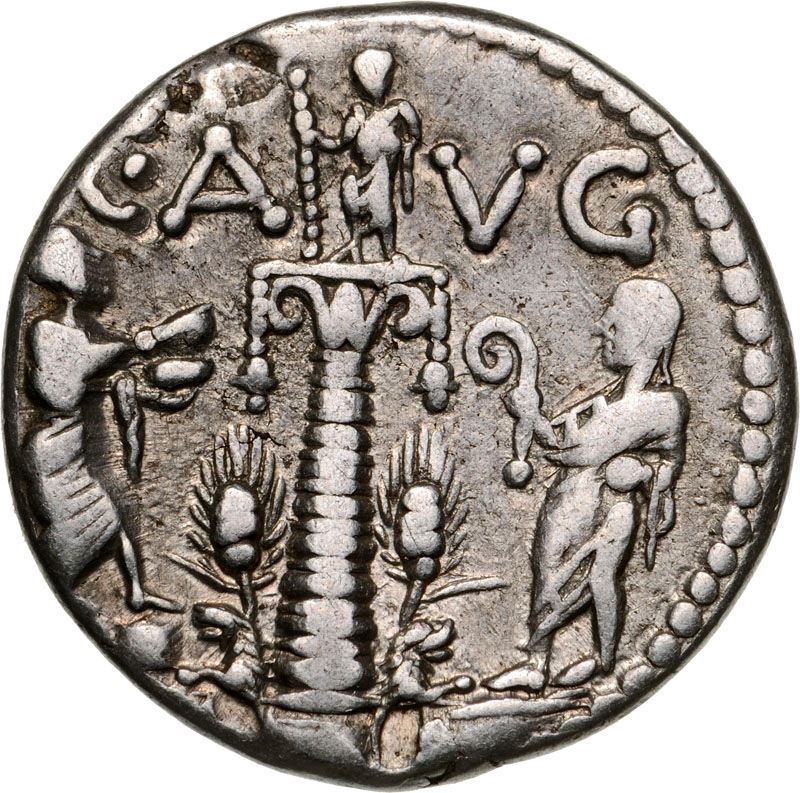
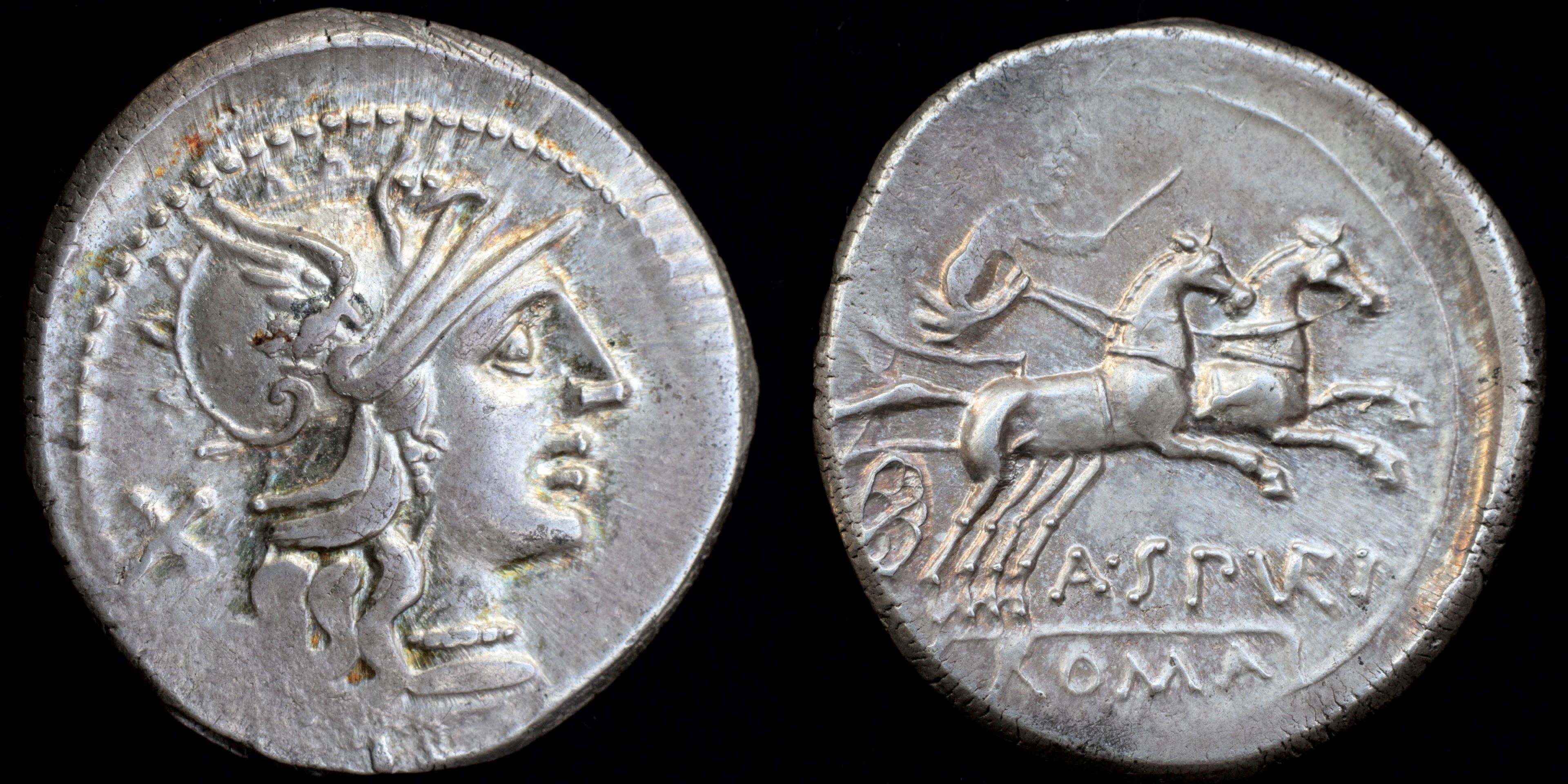
Reverse: Luna in biga right holding goad and reins A·SP(VR)I ROMA
Die Orientation: -
Weight: 3.4 g
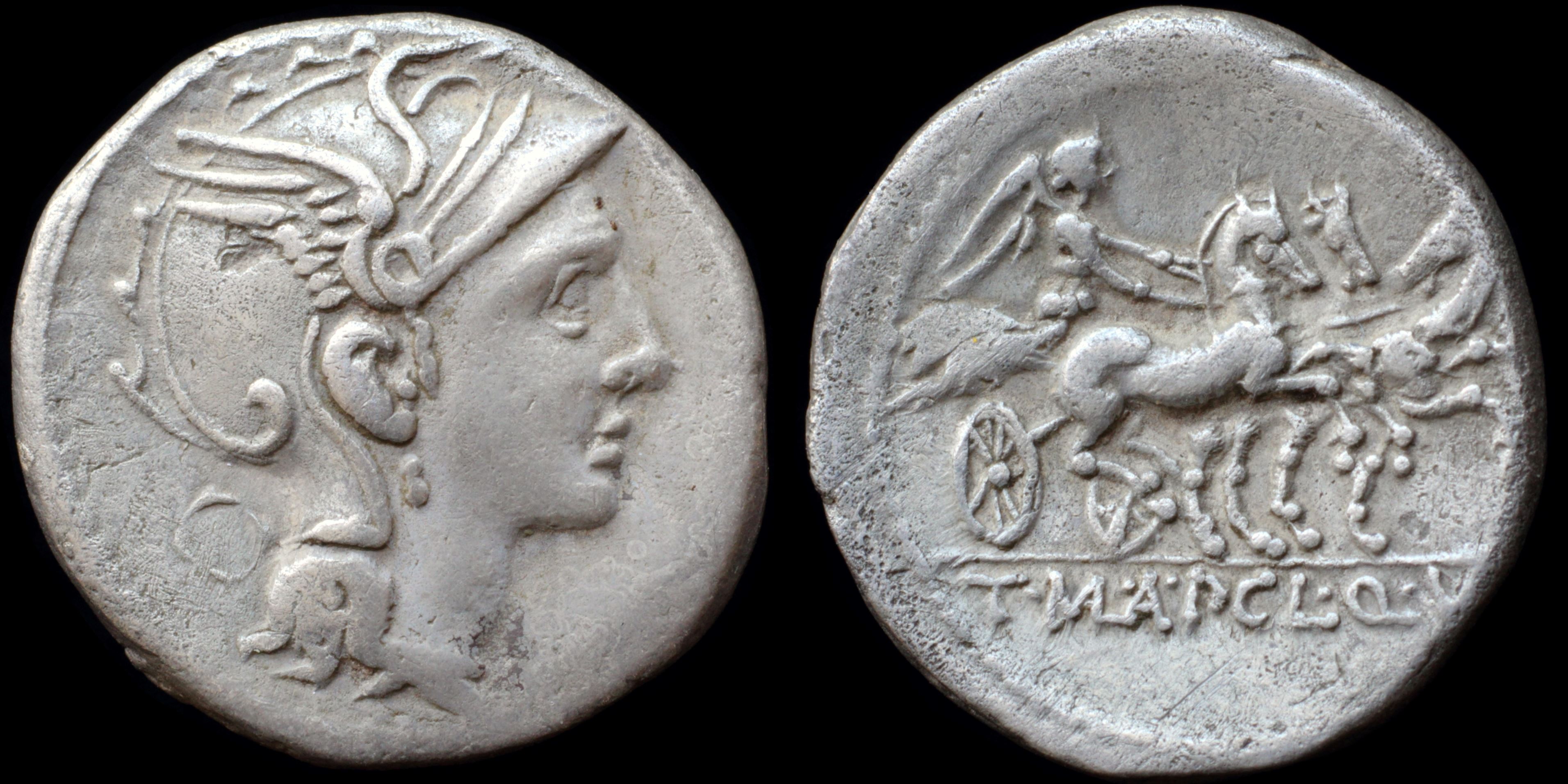
Reverse: victory in triga right holding reins T·(MAL)·A·P CL·Q·(VR)
Die Orientation: -
Weight: 3.8 g
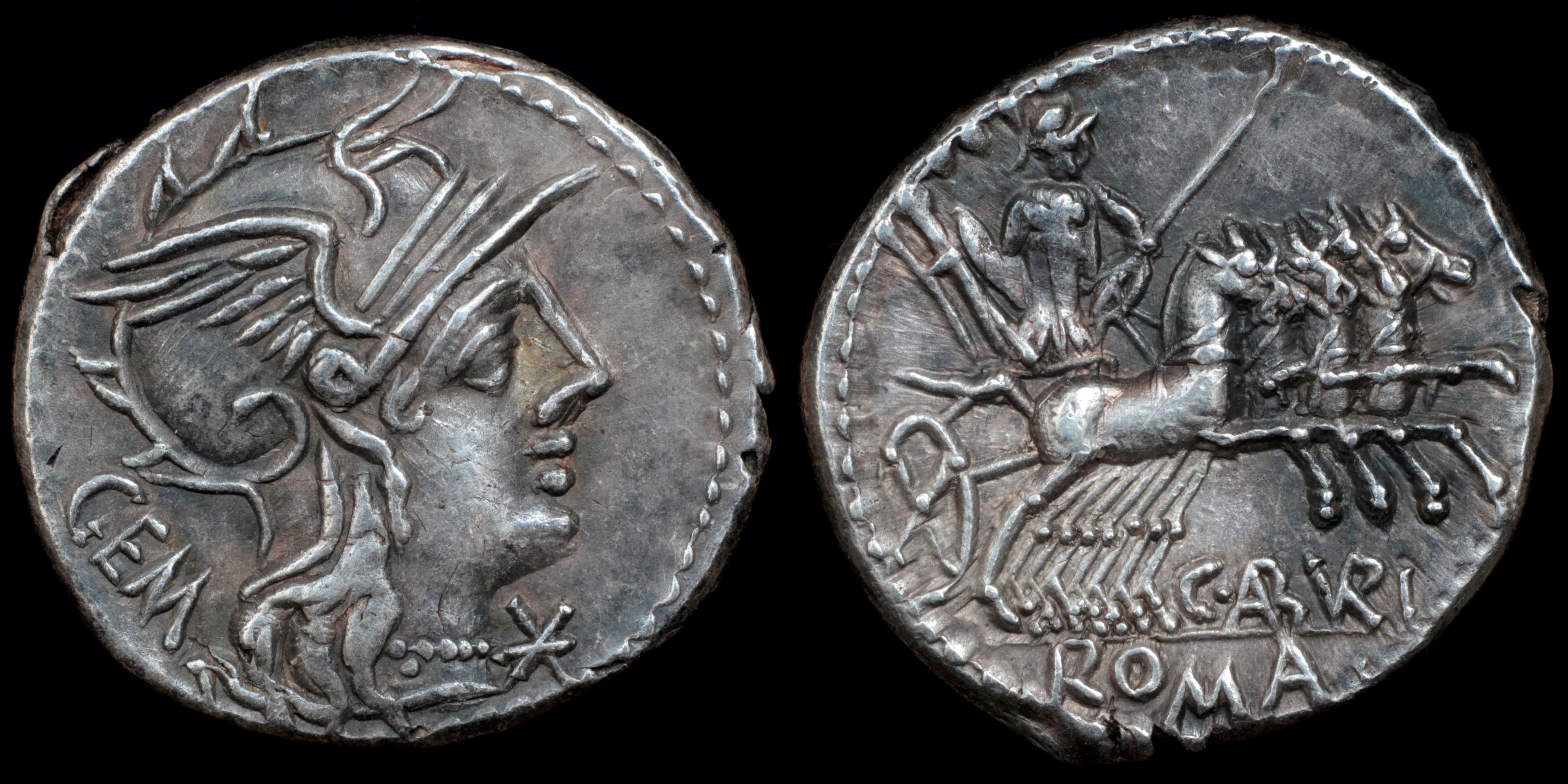
Reverse: Mars in quadriga right holding trophy and reins, shield, spear C·(AB)(VR)I ROMA
Die Orientation: -
Weight: 3.92 g
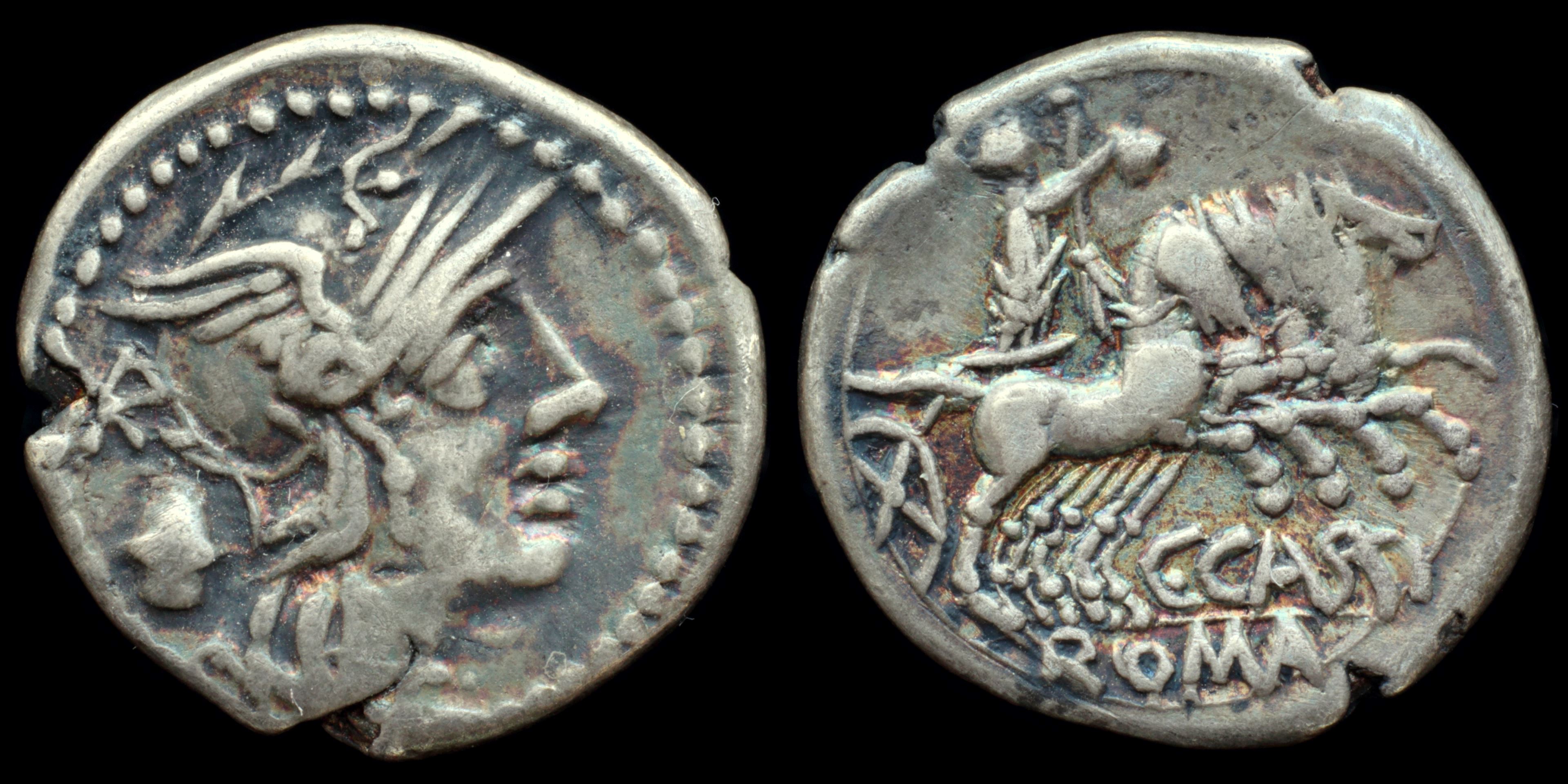
Reverse: Libertas in quadriga right holding pileus, scepter and reins; C·CASSI / ROMA
Die Orientation: -
Weight: 3.85 g
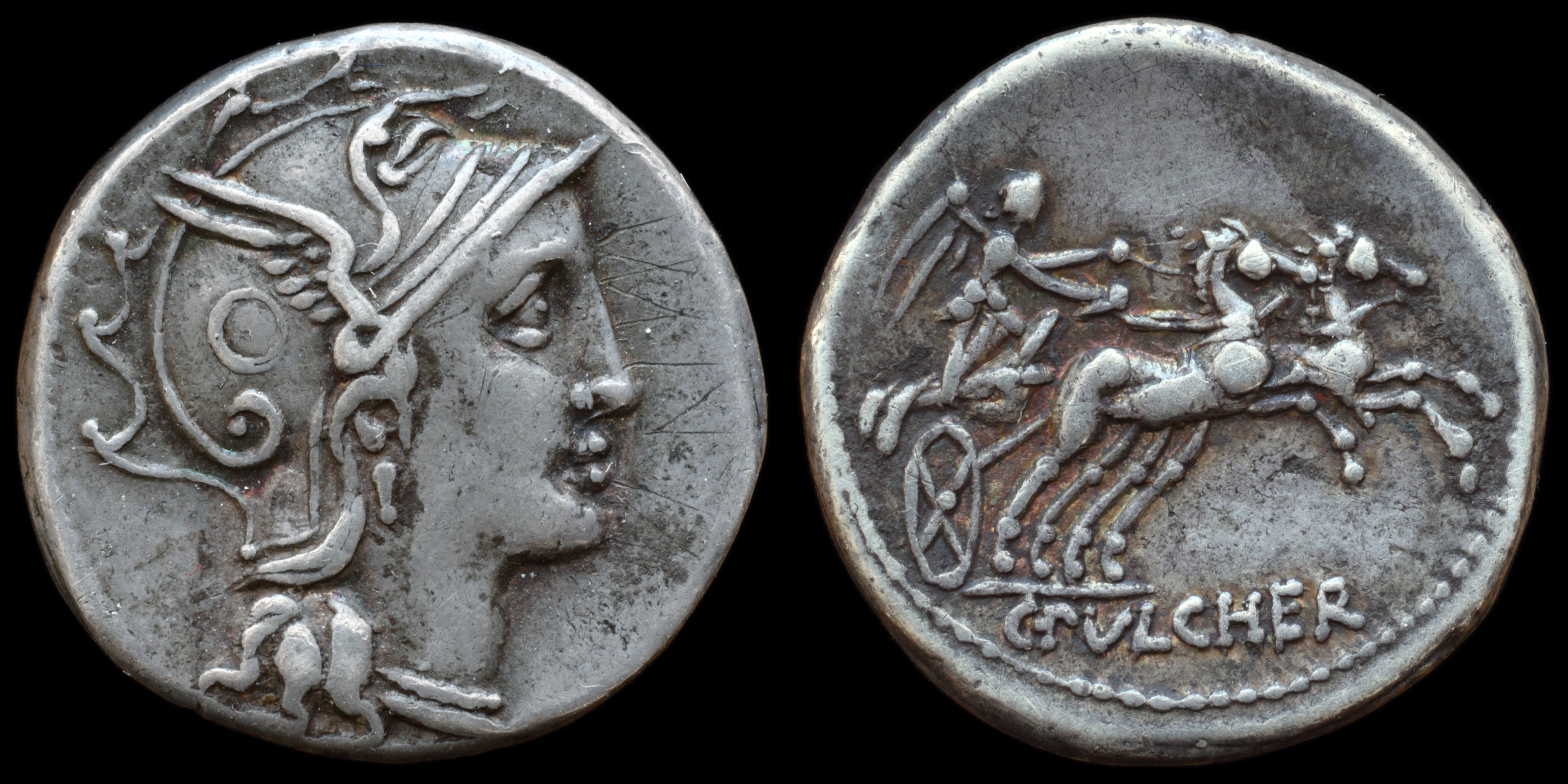
Reverse: Victory in biga right holding reins in both hands; C·PVLCHER
Die Orientation: -
Weight: 4.1 g
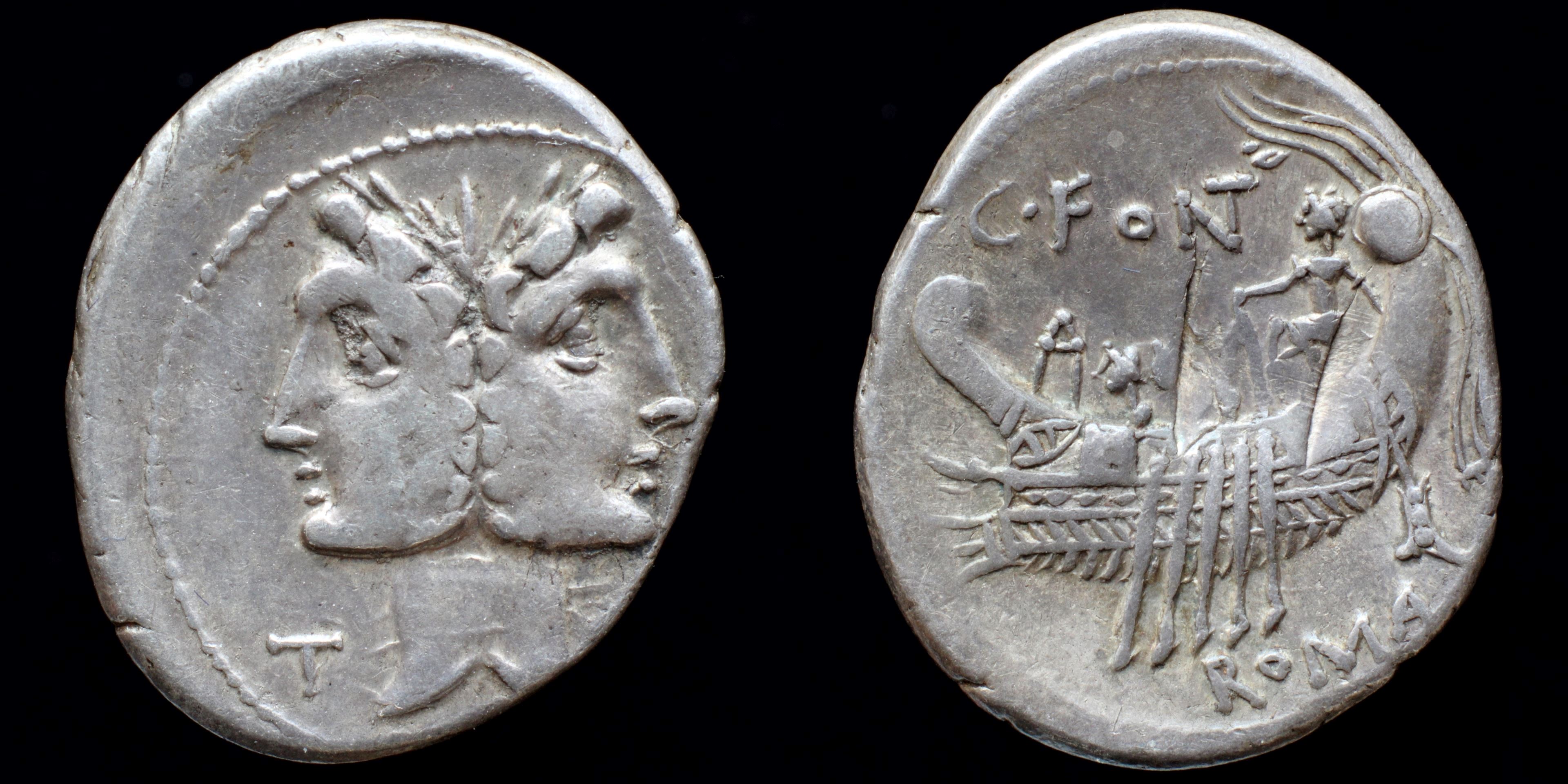
Reverse: war galley left, acrostolium, ram and deck house at prow, three sailors and five oars amidships; deck house, gubernator, rudder, and apluster at stern; C·FO(NT) / ROMA
Die Orientation: -
Weight: 3.9 g
(9).JPG)
Reverse: Galley left with three rowers, gubernator at stern; C•FONT above, ROMA below
Die Orientation: 7 H
Weight: 3.7 g

Reverse: Galley left with three rowers, gubernator at stern; C•FONT above, ROMA below.
Die Orientation: 7 H
Weight: 3.7 g
Ex Paul James Collection
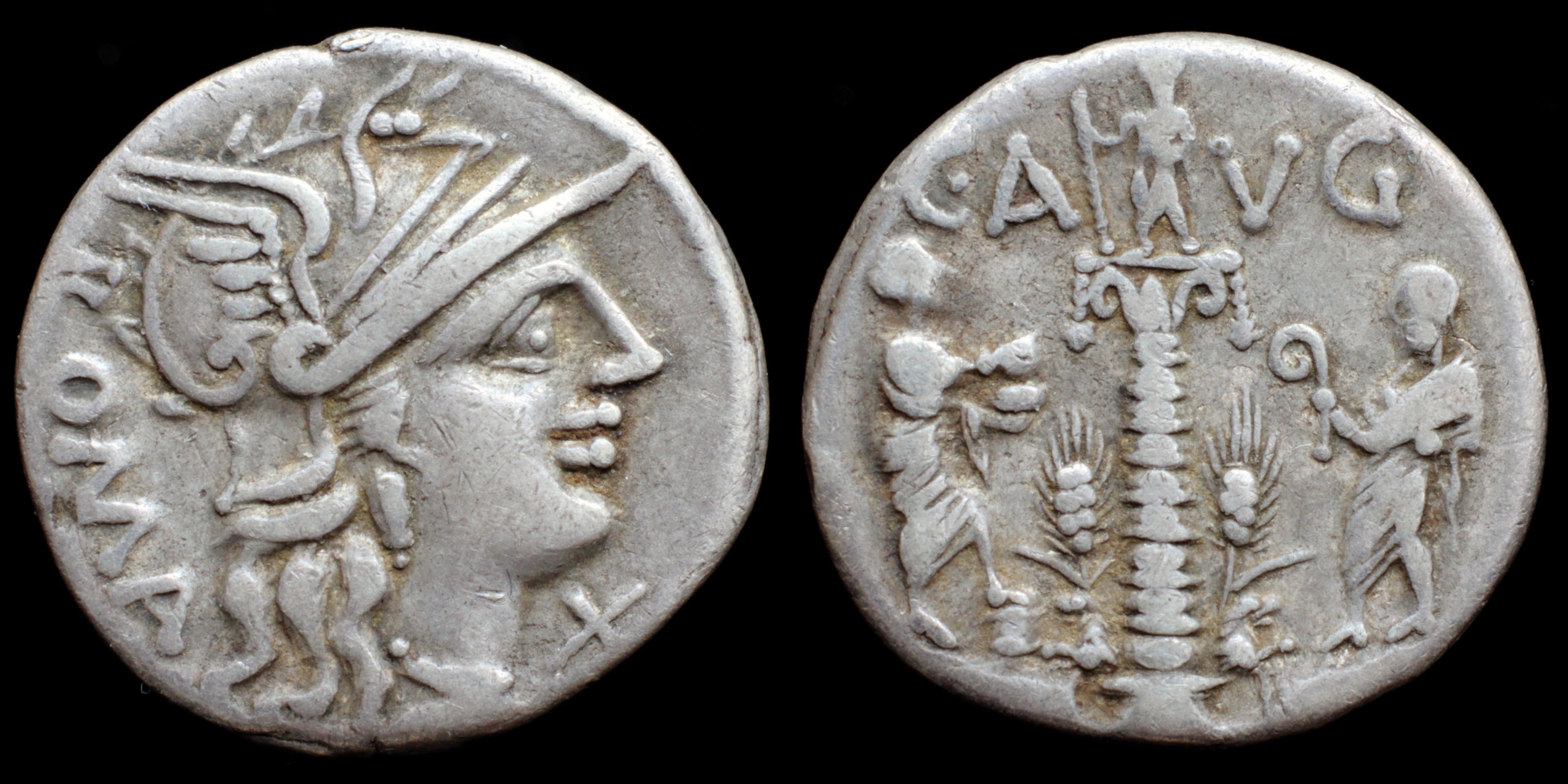
Reverse: Ionic column surmounted by statue; at base, two stalks of grain; on left, L. Minucius Augurinus standing right, holding patera, foot on modius; on right, M. Minucius Faesus standing left, holding lituus. C·A_VG
Die Orientation: -
Weight: 3.7 g
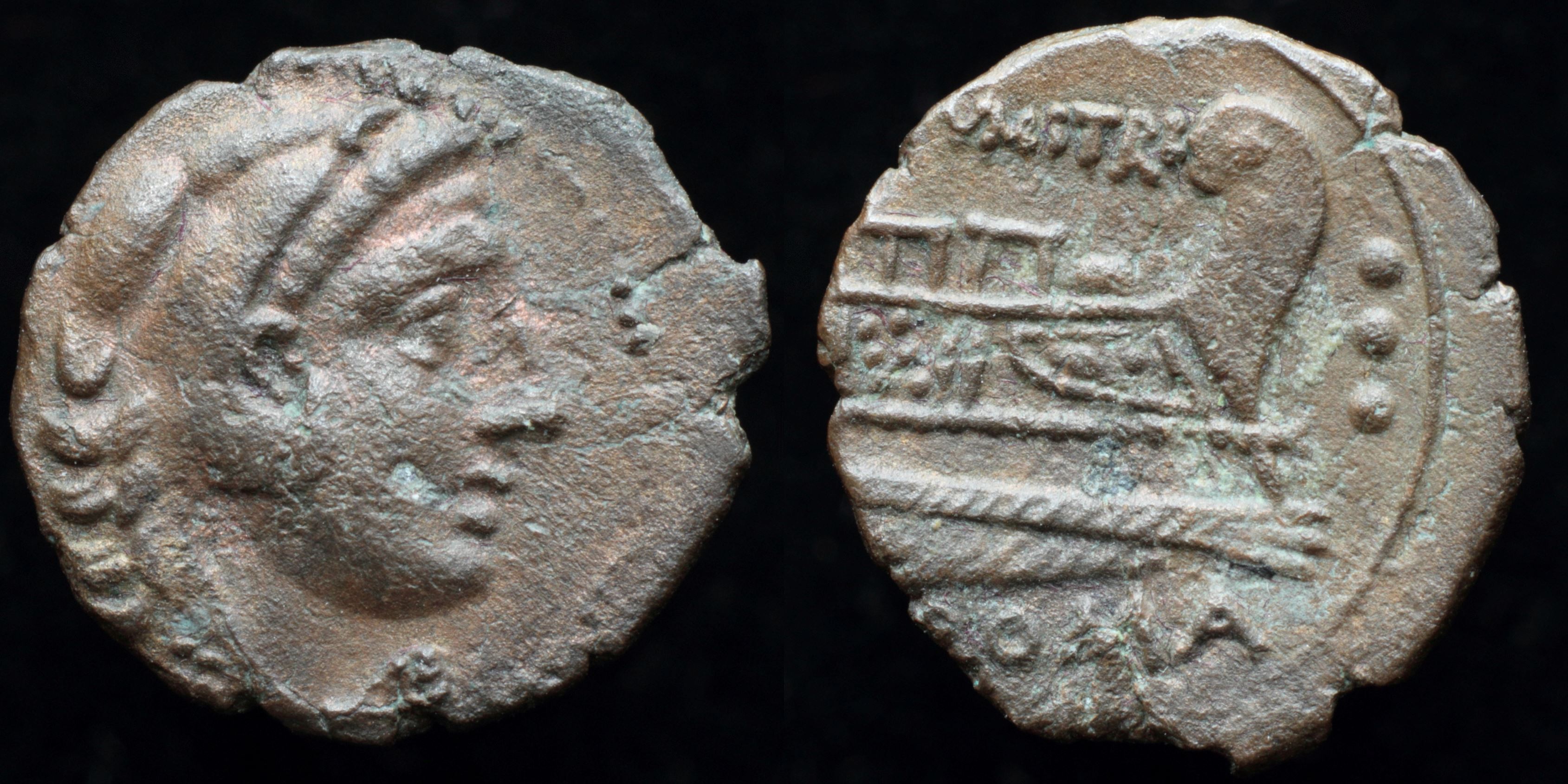
Reverse: prow of galley right ●●● C·NVMITRI ROMA
Die Orientation: -
Weight: 2.2 g
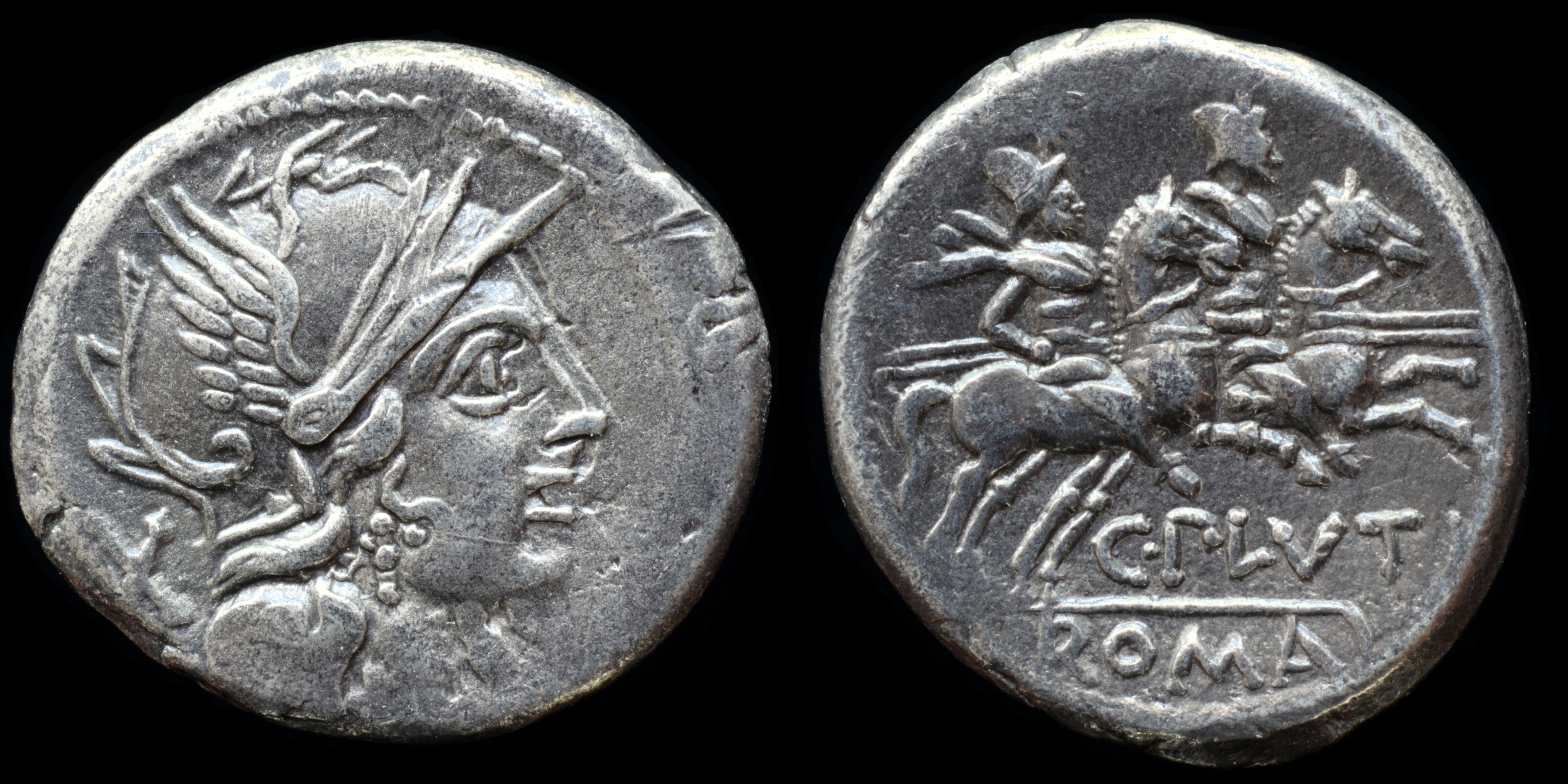
Reverse: Dioscuri riding on horses right, holding spear; C·PLVTI / ROMA
Die Orientation: -
Weight: 3.8 g
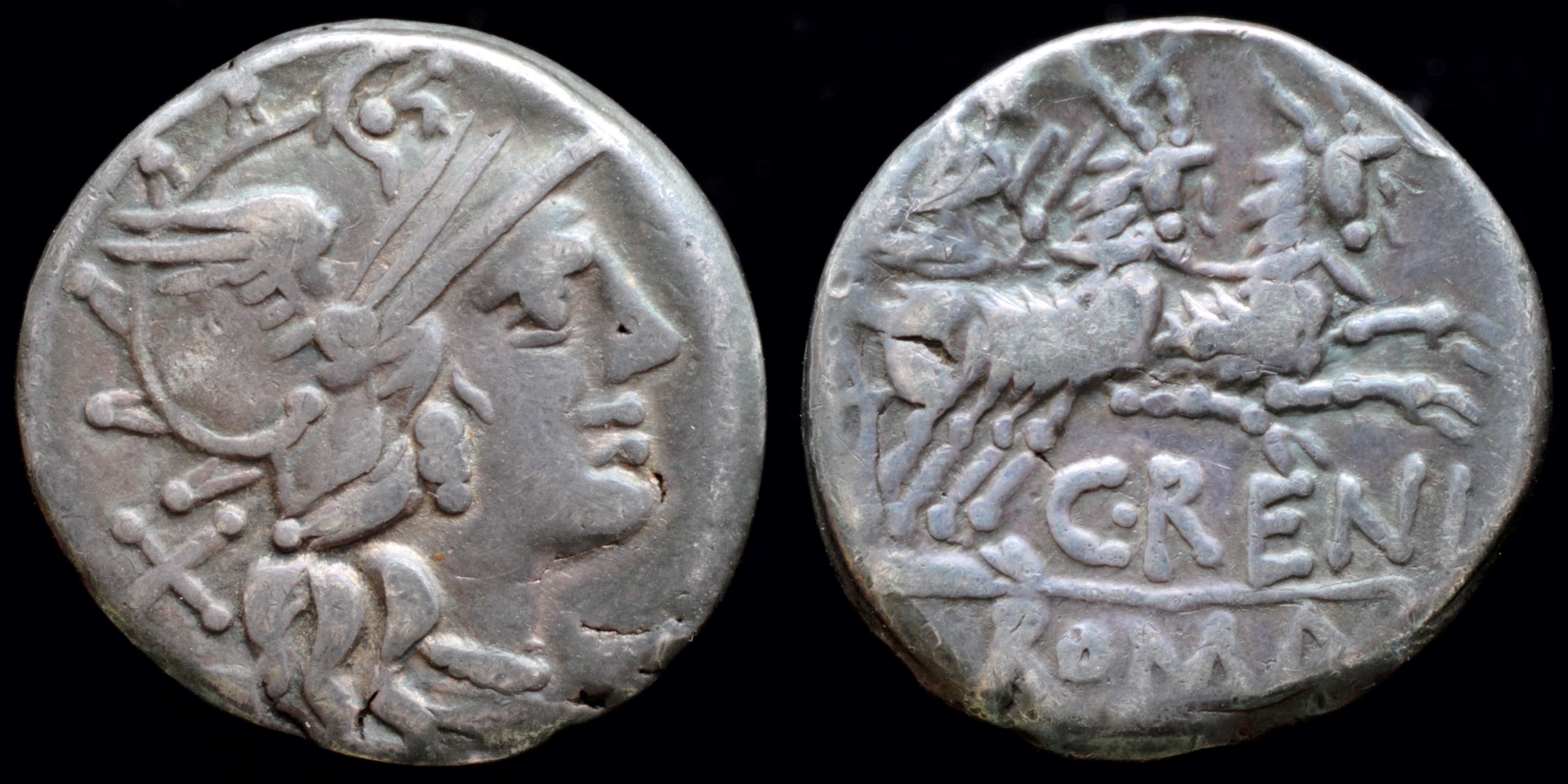
Reverse: Juno Caprotina in biga of goats right holding whip, scepter and reins C·RENI ROMA
Die Orientation: -
Weight: 3.8 g
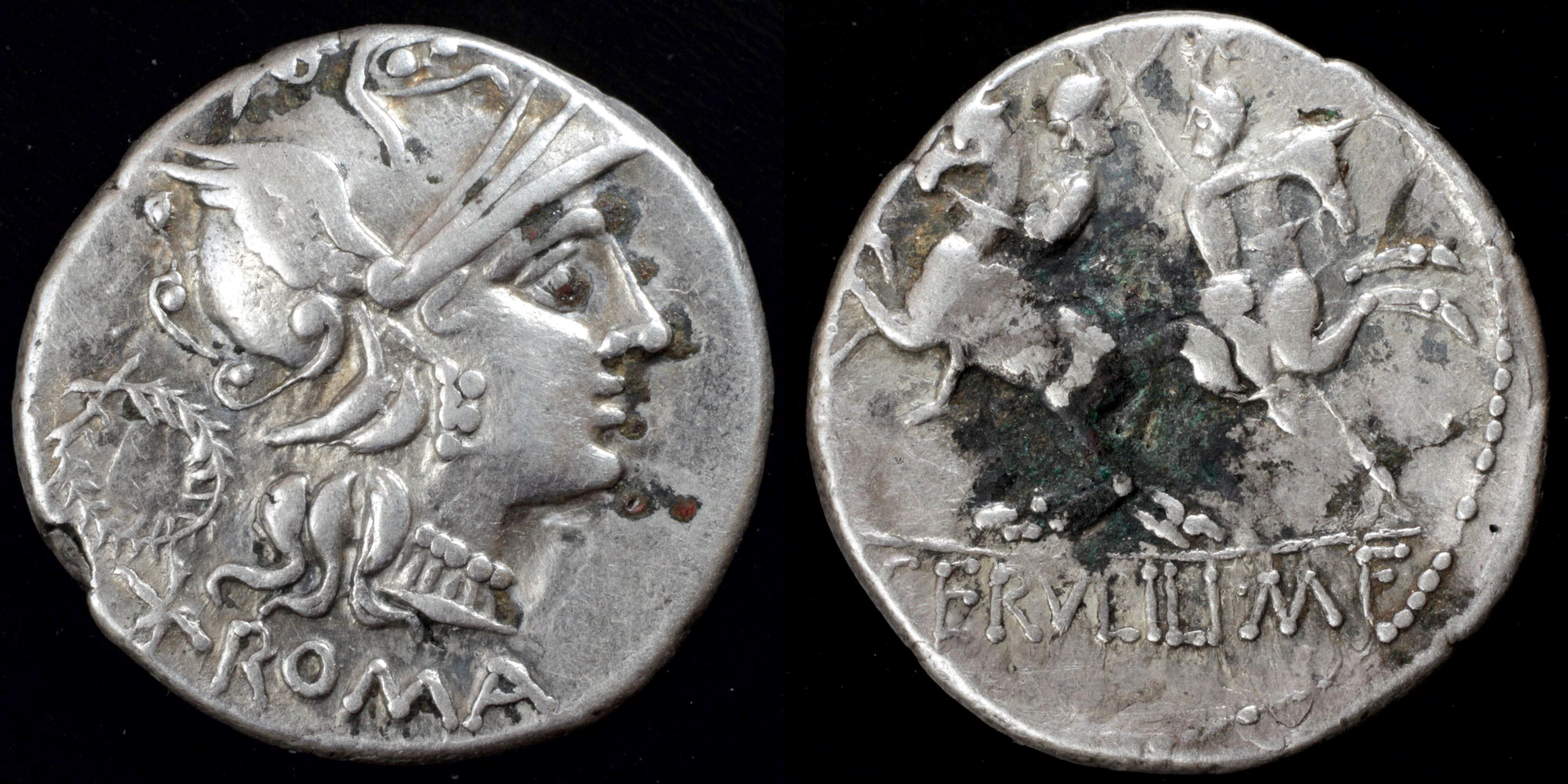
Reverse: the Dioscuri riding in opposite directions, heads turned confronting, each with star above his head and holding a spear C·SERVEILI·M·F
Die Orientation: -
Weight: 2.6 g
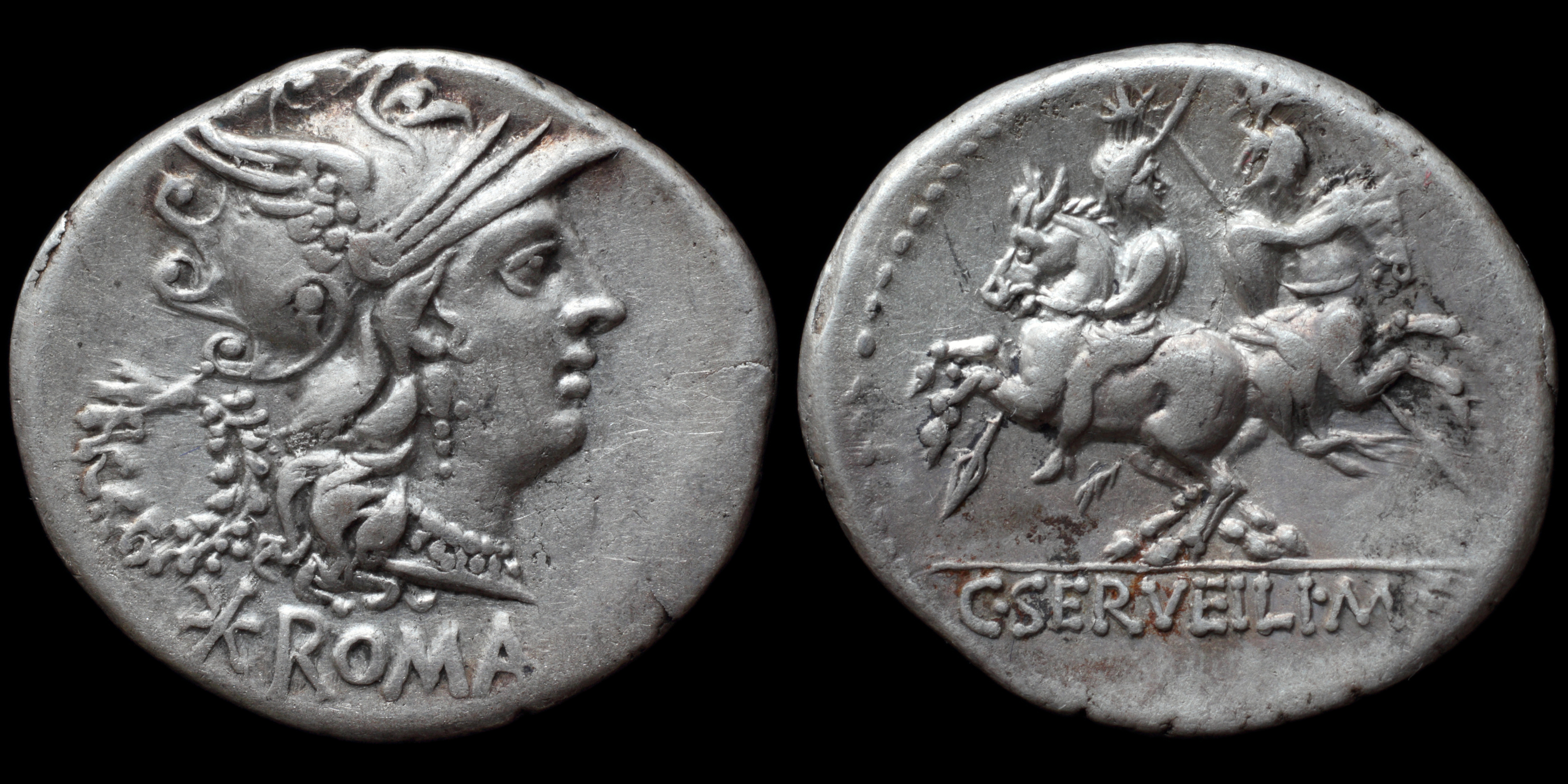
Reverse: the Dioscuri riding in opposite directions, heads turned confronting, each with star above his head and holding a spear; C·SERVEILI·M·F
Die Orientation: -
Weight: 3.9 g
(0).jpg)
Reverse: The Dioscuri on horseback rearing in opposing directions, heads facing one another, each holding couched spear; stars above, C•SERVEILI•M•F in exergue
Die Orientation: 6 H
Weight: 4.04 g
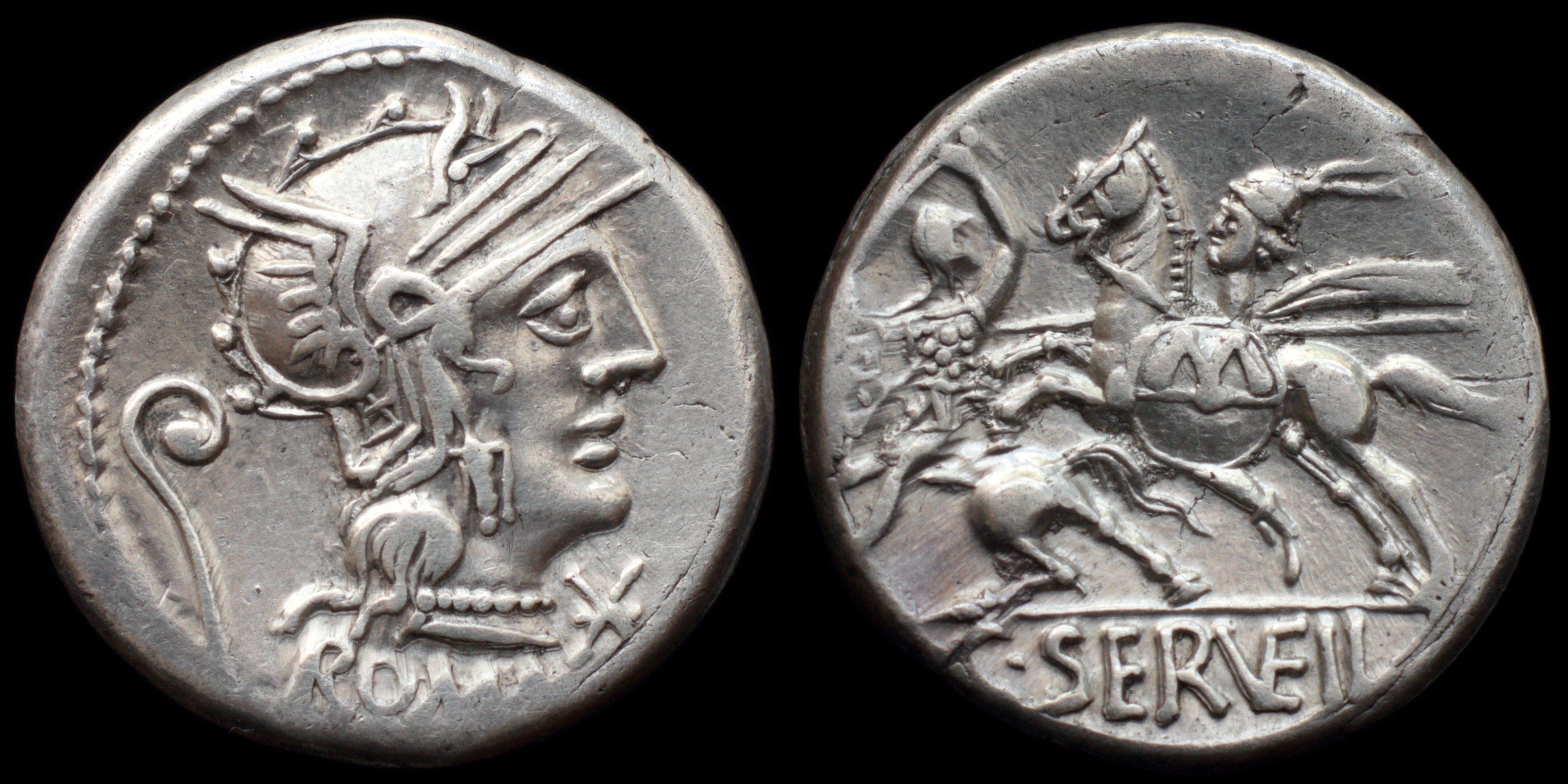
Reverse: Marcus Servilius Pulex Geminus, consul 202 BC, left fighting a duel on horse, holding spear and shield inscribed with M. Other horseman riding left holding sword and shield; C·SER(VE)IL
Die Orientation: -
Weight: 3.9 g
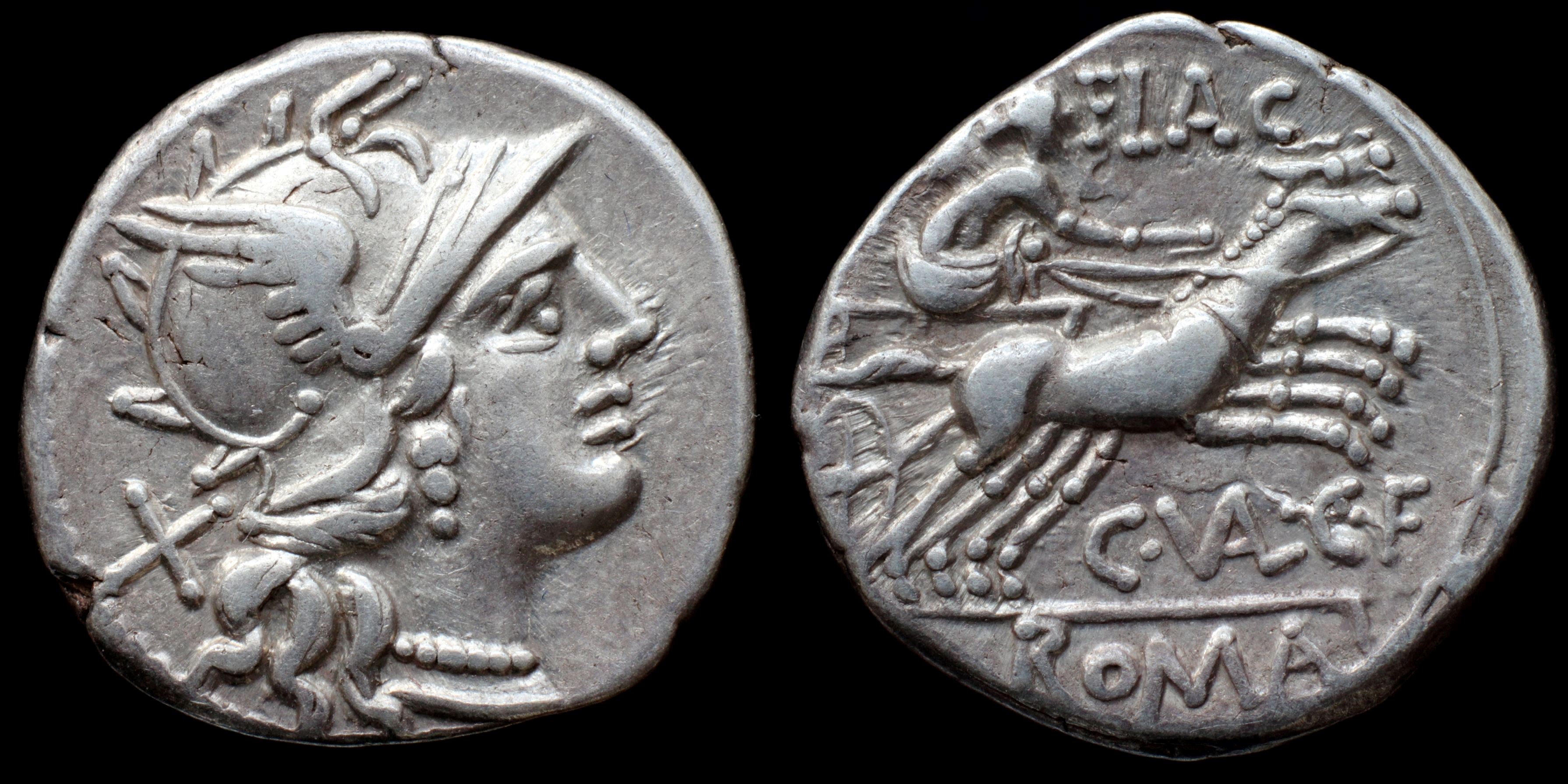
Reverse: Victory in biga right, holding whip and reins; FLAC / C·(VAL)·C·F / ROMA
Die Orientation: -
Weight: 4 g
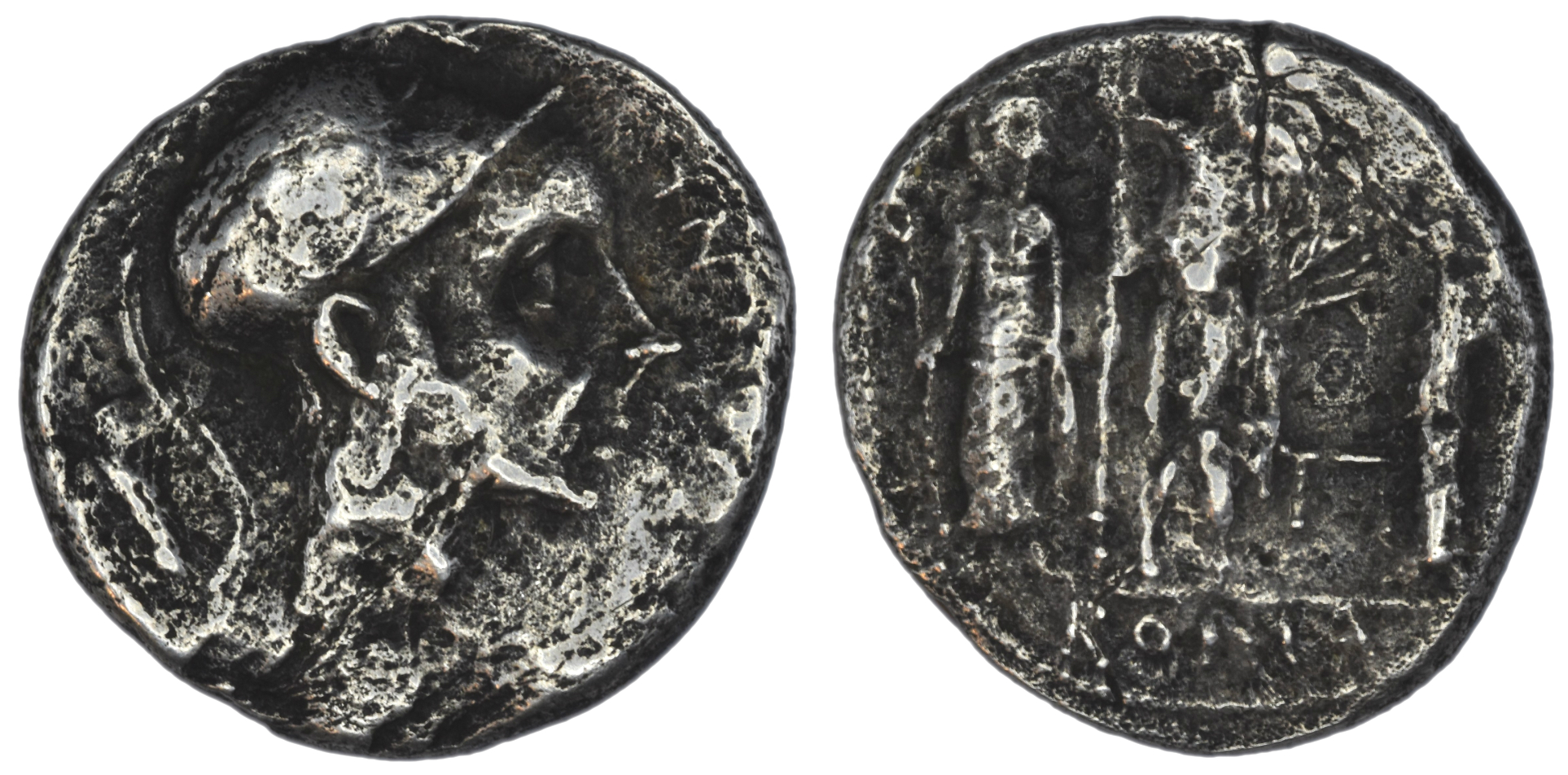
Reverse: The Capitoline Triad: Jupiter, holding sceptre and thunderbolt, standing facing between Juno and Minerva / Π in field, ROMA in exergue.
Die Orientation: -
Weight: 3.49 g
(25).jpg)
Reverse: Jupiter standing facing, holding sceptre and thunderbolt, between Juno and Minerva, the latter crowning Jupiter with wreath; palm branch in central field, dolphin in right field, ROMA (divided by eagle) in exergue
Die Orientation: 5 H
Weight: 4.03 g
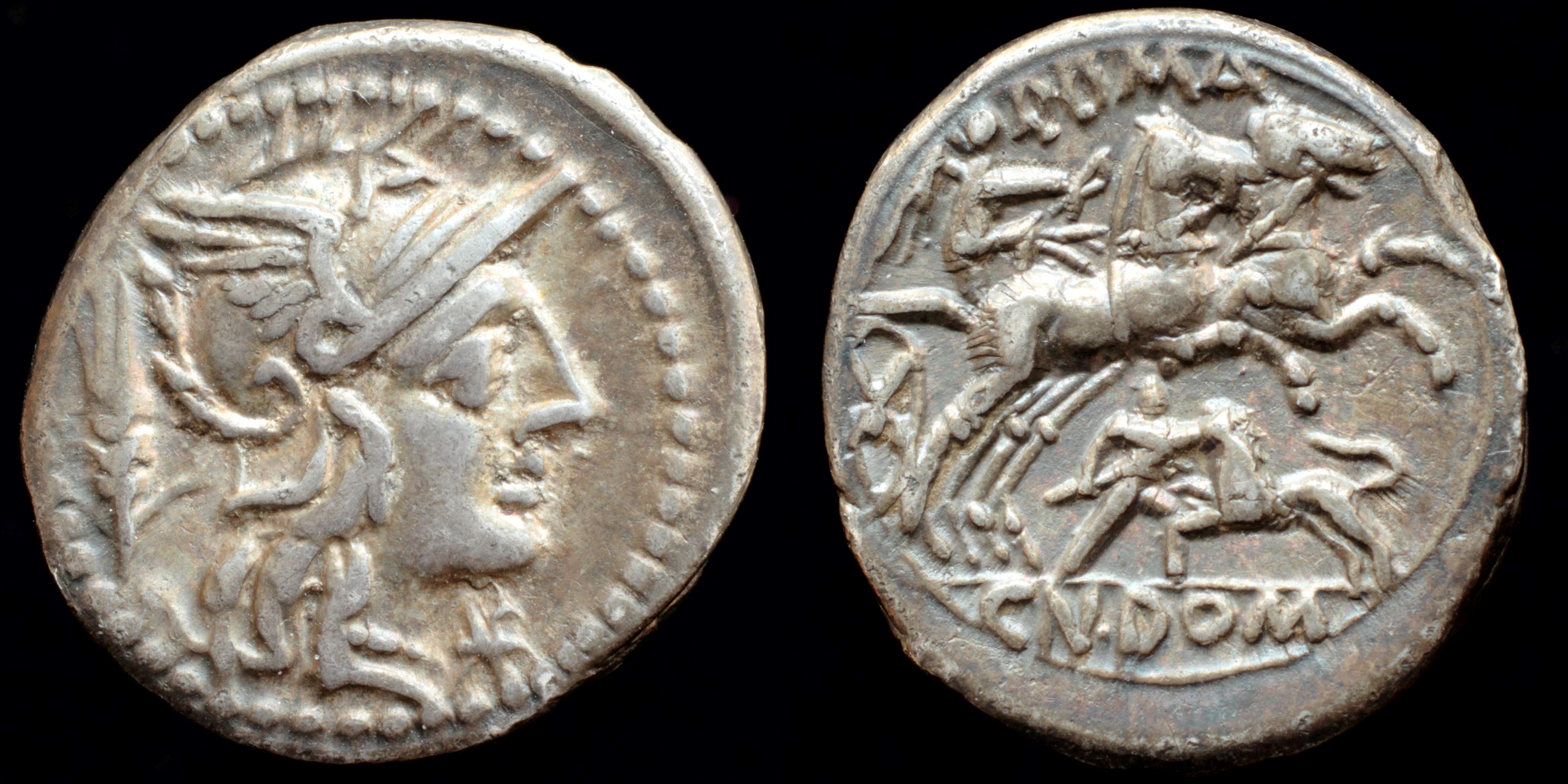
Reverse: Victory in biga right holding wreath and reins, man attacking lion with spear below ROMA CN·DOM
Die Orientation: -
Weight: 3.9 g
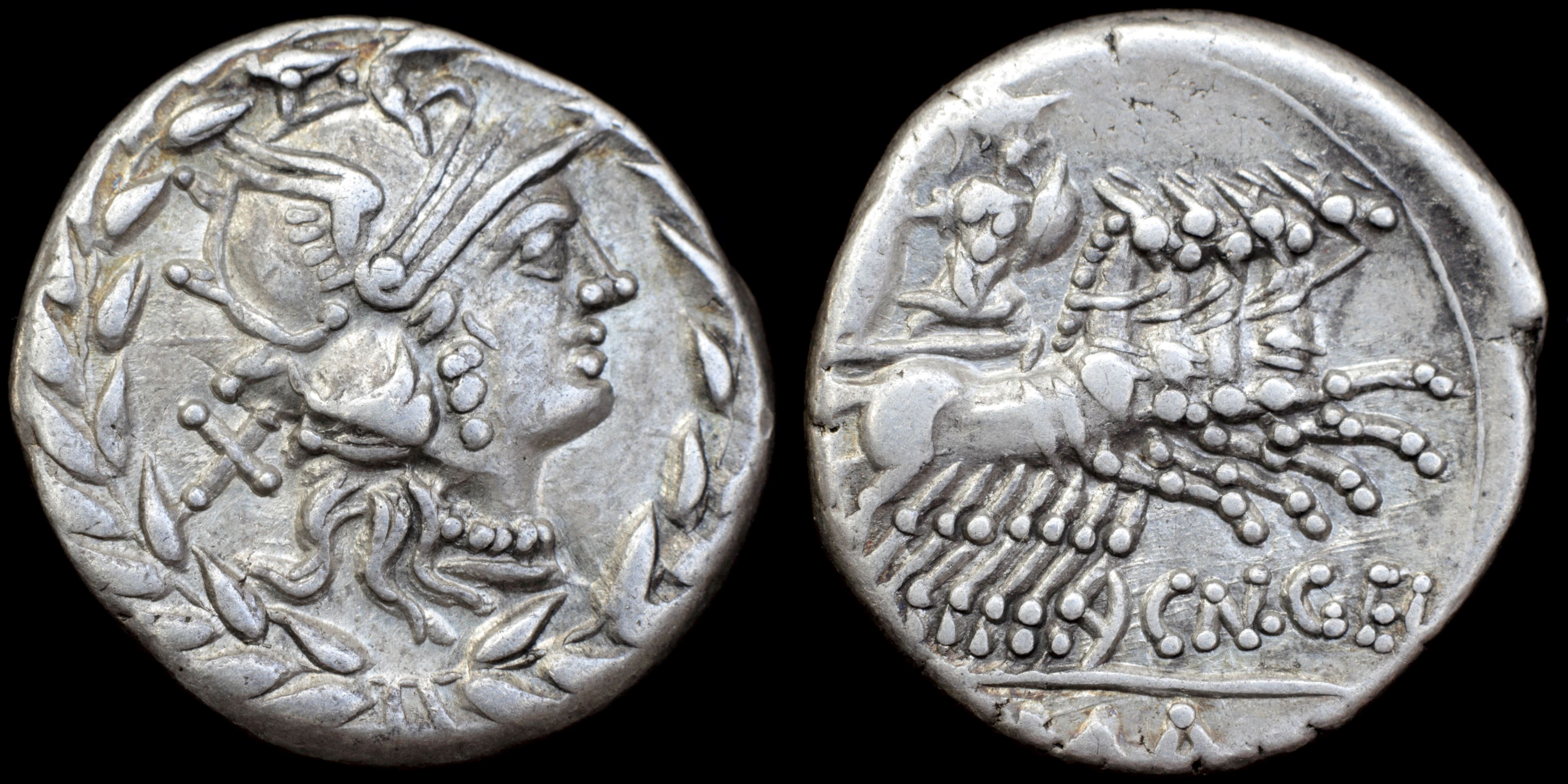
Reverse: Mars and Nerio in quadriga right; Mars holding Nerio and shield CN·GEL ROMA
Die Orientation: -
Weight: 3.9 g
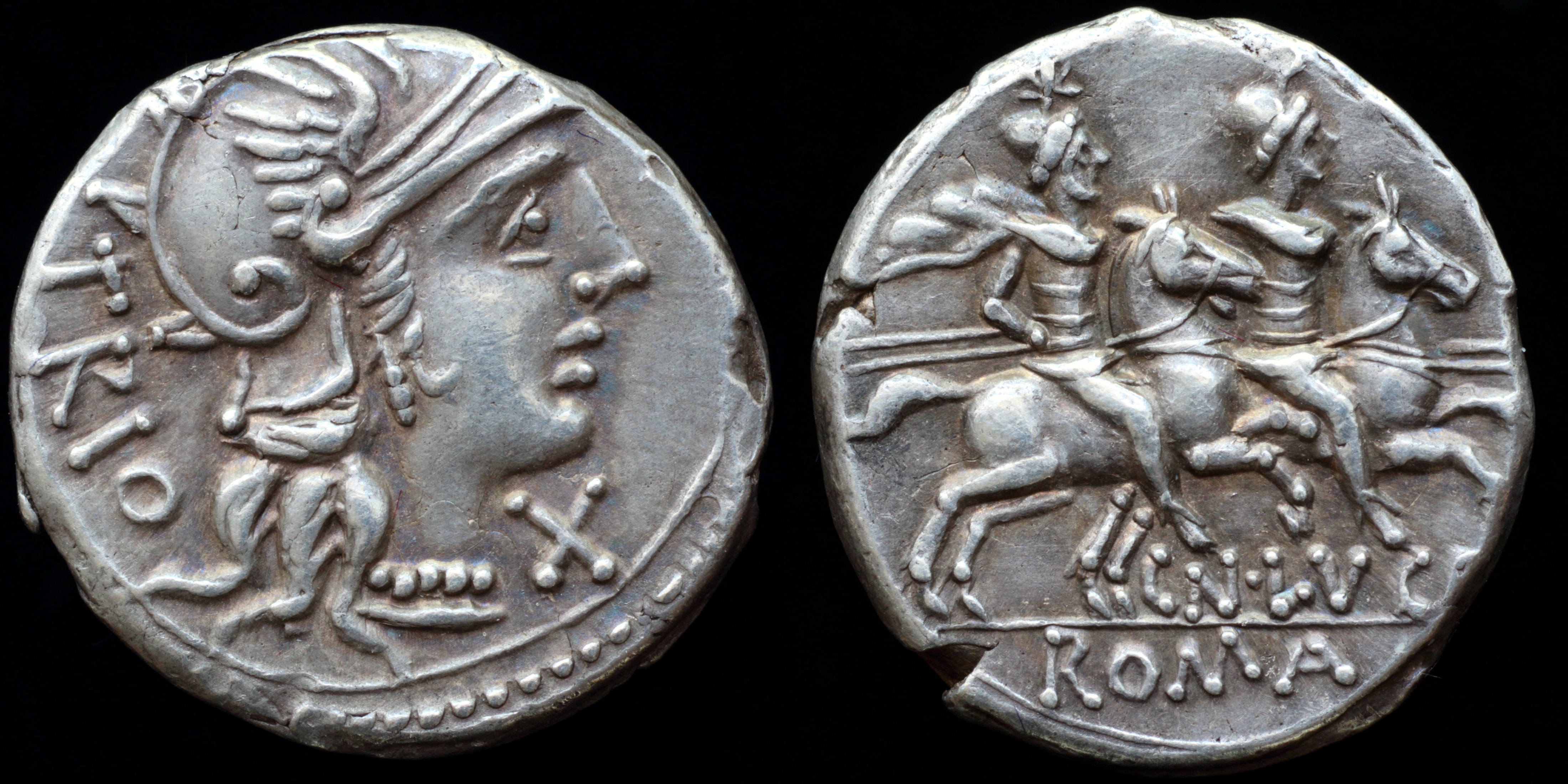
Reverse: Dioscuri riding on horses right, stars over pilei, holding spear and reins; CN·LVCR / ROMA
Die Orientation: -
Weight: 4 g
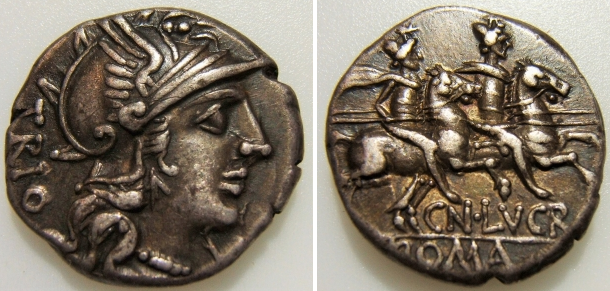
Reverse: CN•LVCR / ROMA - The Dioscuri riding right, each holding a couched lance, stars above, CN•LVCR below.
Die Orientation: 3 H
Weight: 3.94 g
(0).jpg)
Reverse: Jupiter in quadriga right, holding reins, thunderbolt and sceptre; L•ANTES below, ROMA in exergue
Die Orientation: 10 H
Weight: 3.93 g
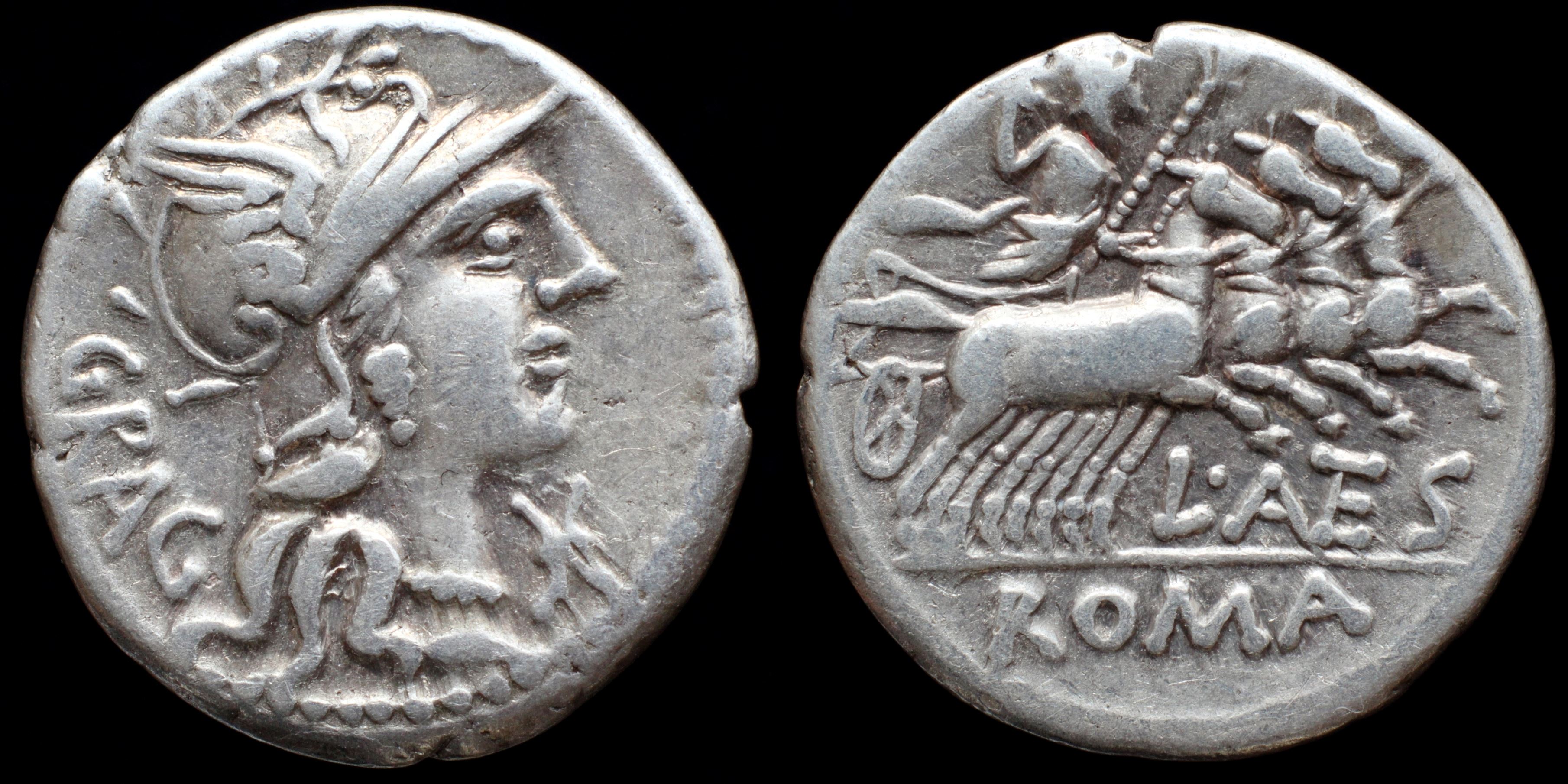
Reverse: Jupiter in quadriga right, horling thunderbolt and holding scepter and reins; L·A(NTE)S / ROMA
Die Orientation: -
Weight: 3.9 g
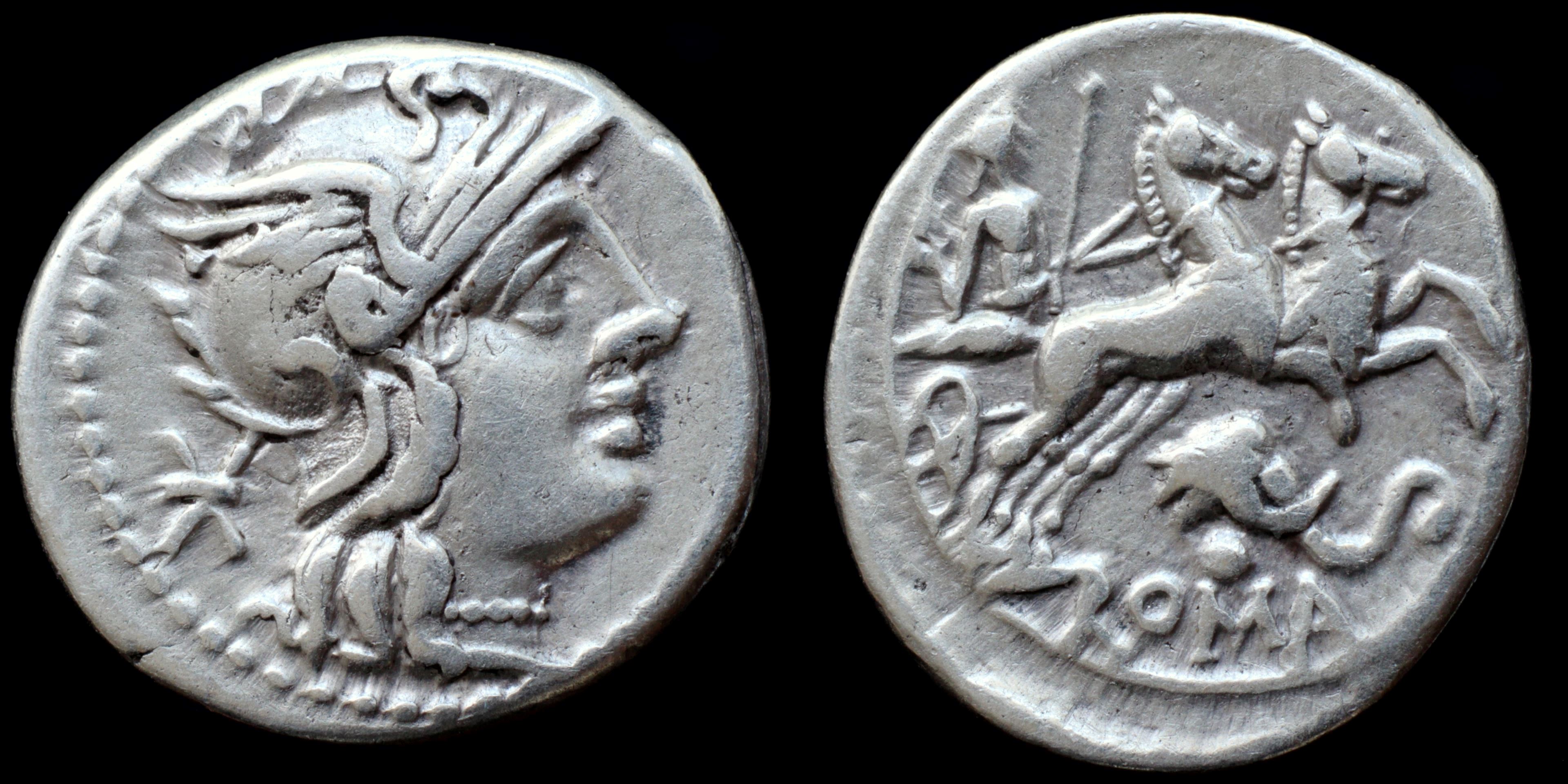
Reverse: Pax in biga right, holding branch, reins and scepter, elephant head below; ROMA
Die Orientation: -
Weight: 3.8 g
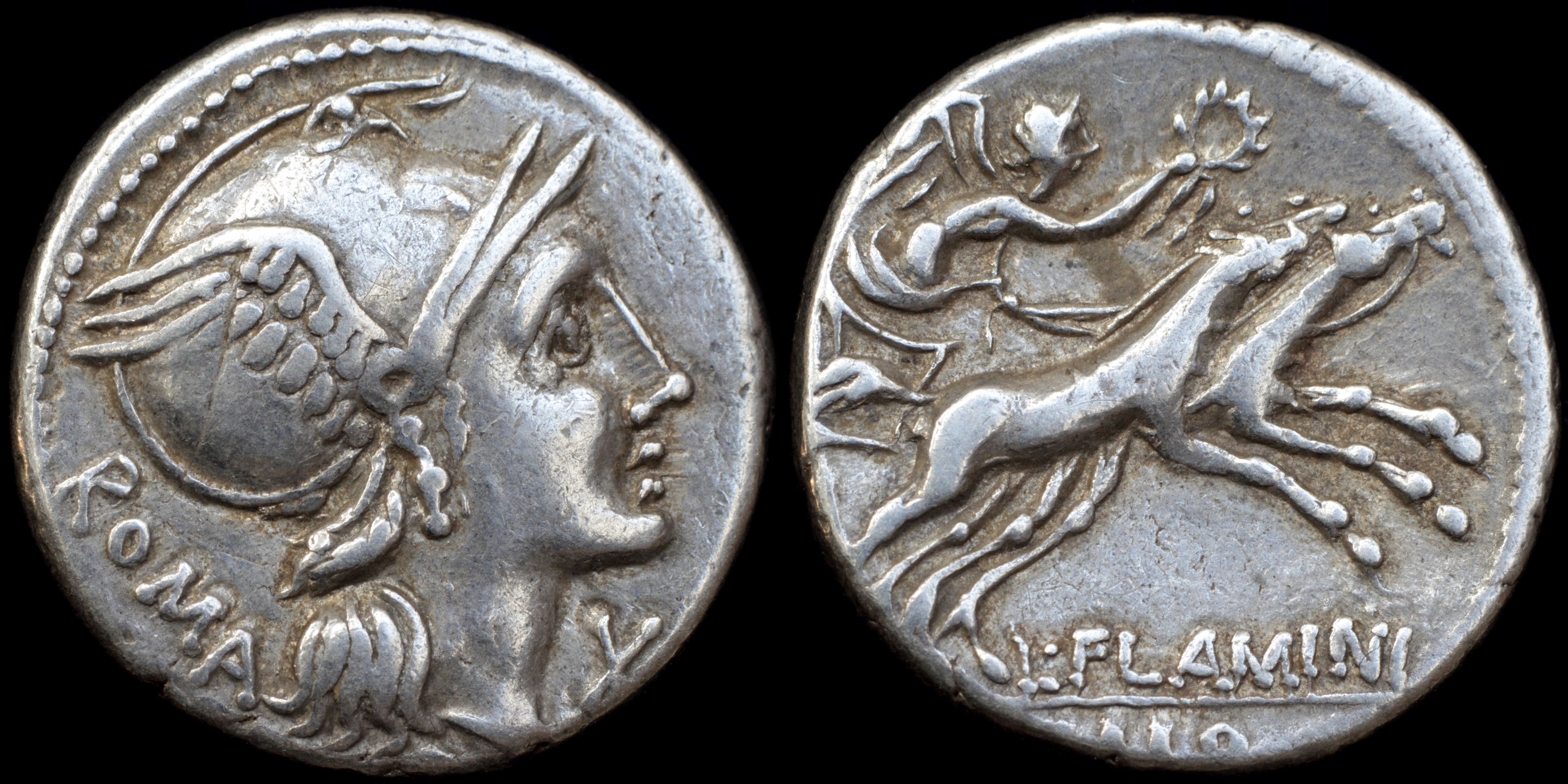
Reverse: Victory in biga right holding wreath and reins L·FLAMINI CILO
Die Orientation: -
Weight: 4 g
.jpg)
Reverse: Victory driving biga right, L FLAMINI below, CILO in exergue
Die Orientation: 4 H
Weight: 4.01 g
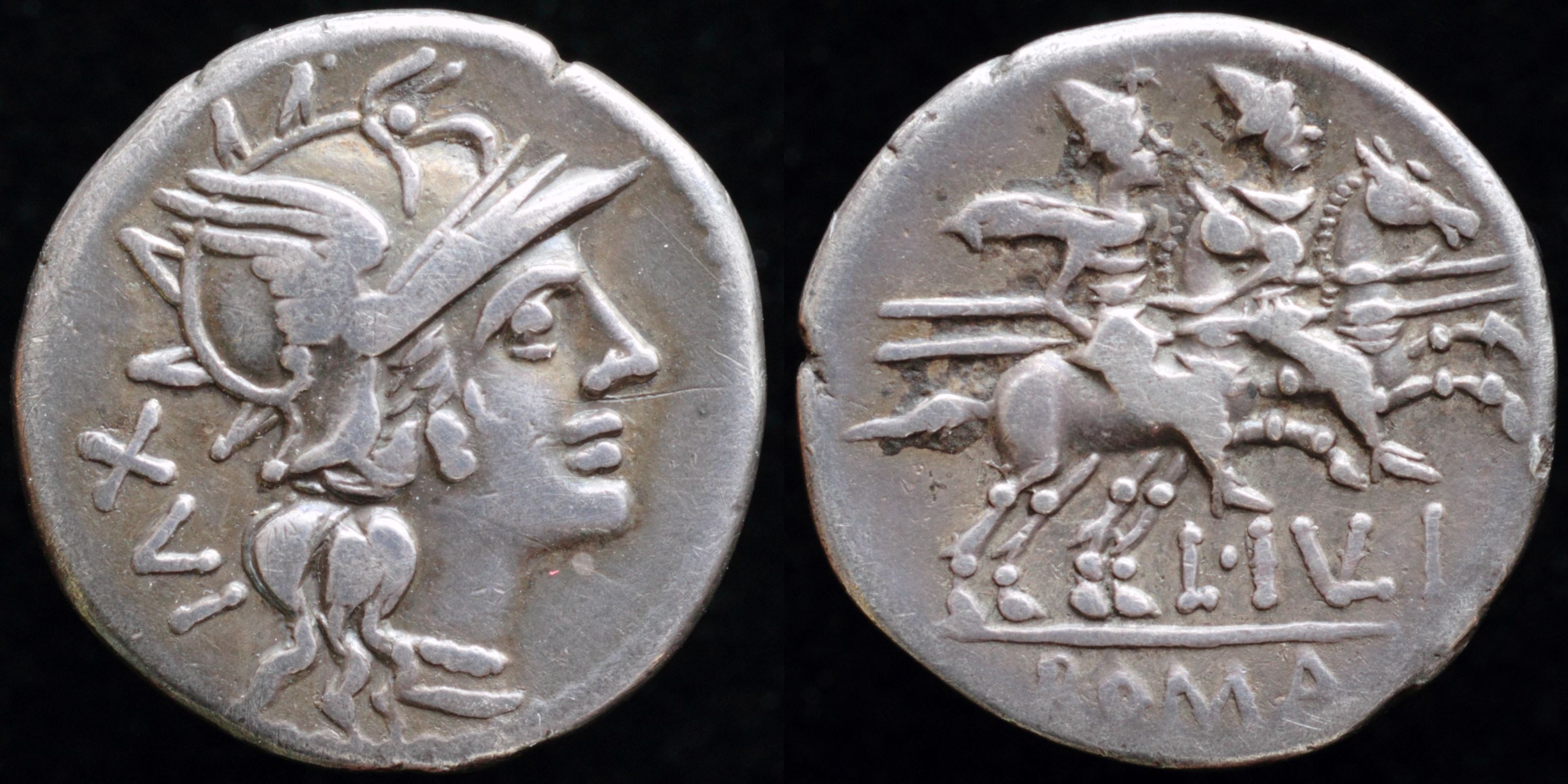
Reverse: Dioscuri riding on horses right holding spears and reins; stars over their heads L·I(VL)I ROMA
Die Orientation: -
Weight: 3.8 g
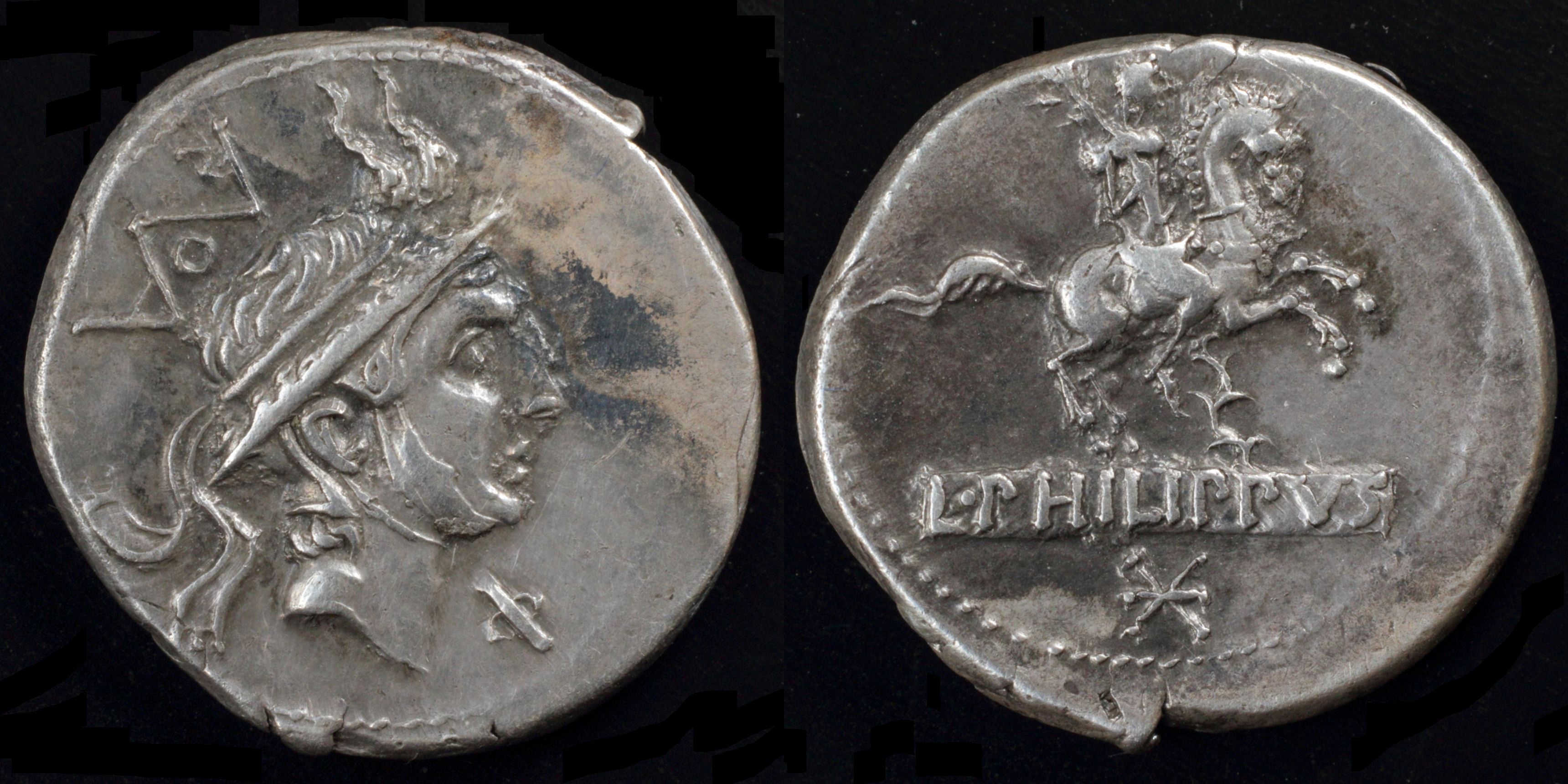
Reverse: equestrian statue right, holding laurel branch, flower below L·PHILIPPVS (XVI)
Die Orientation: -
Weight: 3.9 g
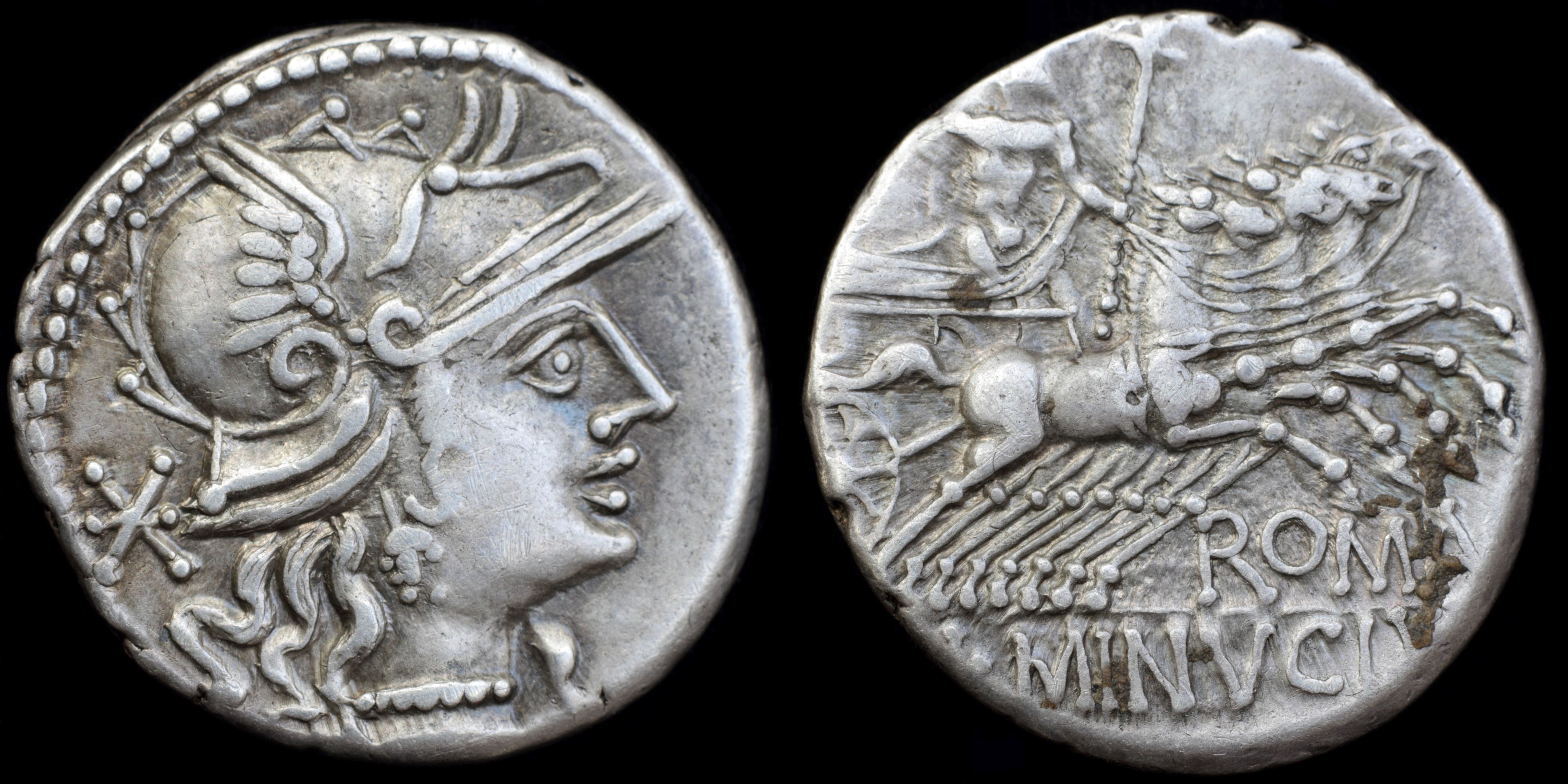
Reverse: Jupiter in quadriga right holding thunderbolt, reins and scepter ROMA L·MINVCIV
Die Orientation: -
Weight: 3.8 g
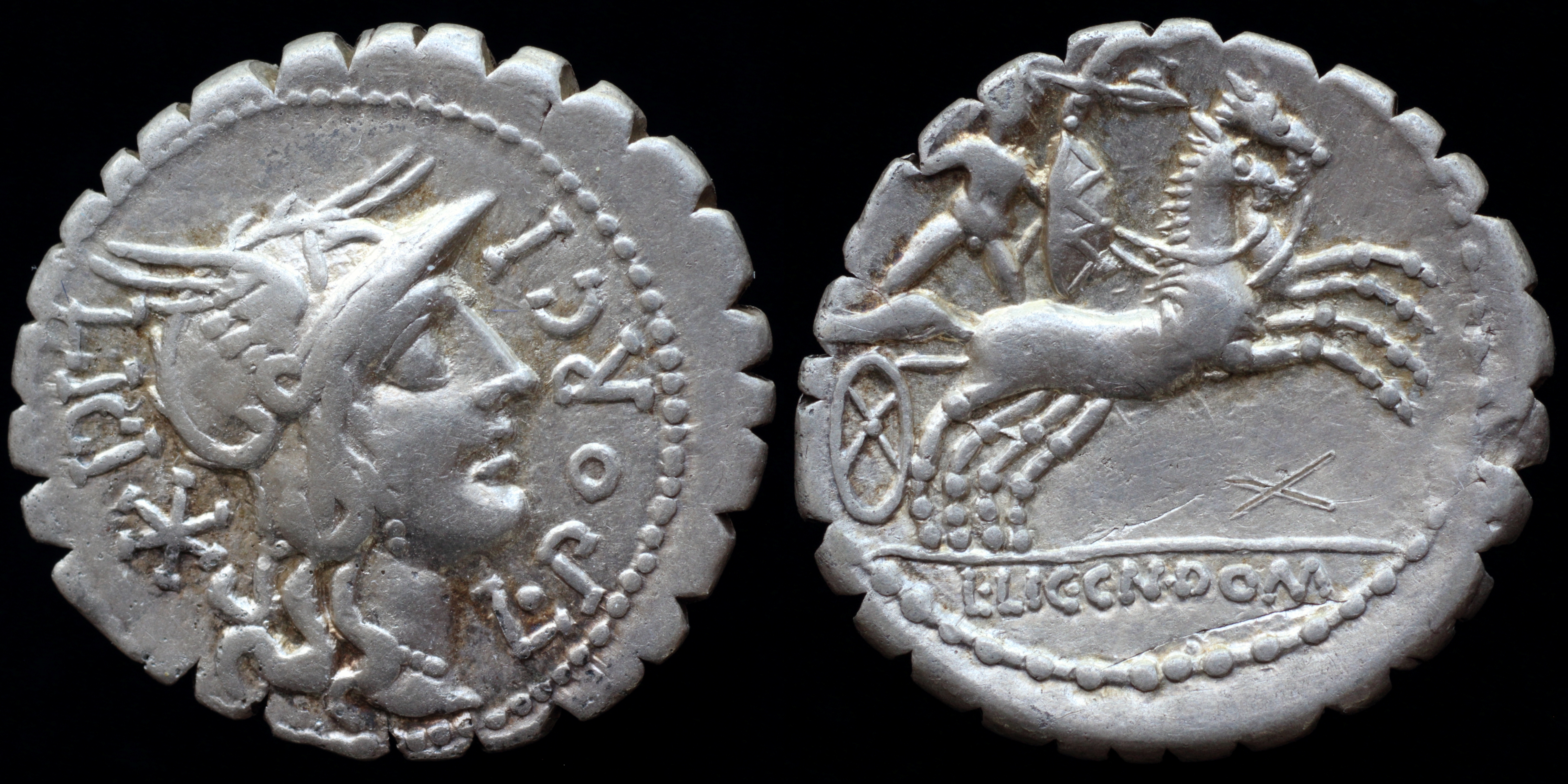
Reverse: naked Gallic warrior riding in biga right, holding spear, reins, shield and carnyx; L·LIC·CN·DOM
Die Orientation: -
Weight: 3.9 g
Narbo mint L. Licinius Crassus and Cn. Domitius Ahenobarbus Narbo, the first colony in Gaul, was founded 118-117 BC. L. Licinius Crassus and Cn. Domitius Ahenobarbus were officials charged with founding colony (duoviri coloniae deducendae). L. Porcius Licinus was one of 5 officials charged with production of denarii (curatorec denariorum flandorum). Reverse probably commemorates victory of Cn. Domitius Ahenobarbus (consul 122 BC) in southern Gaul. He and Q. Fabius Maximus attacked united Gallic tribes of Allobrogi and Averni led by Bituitus at the confluence of Rhone and Isere. Their triumph was celebrated in 120 BC.
.jpg)
Reverse: Mars walking left, holding spear and carrying trophy over left shoulder; L•VALERI FLACCI and apex before; corn-ear behind
Die Orientation: 2 H
Weight: 3.96 g
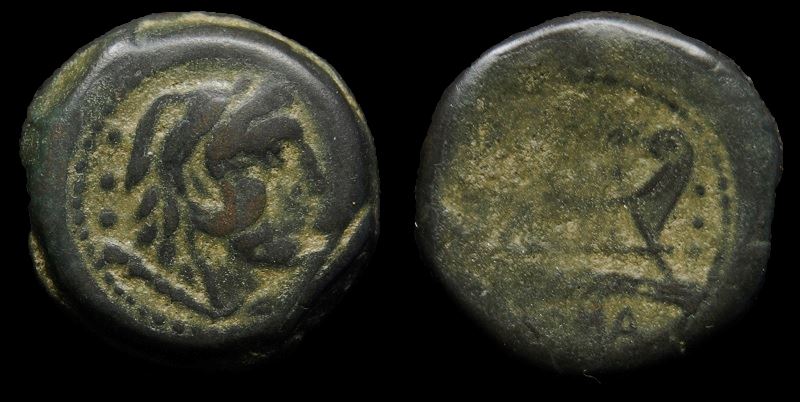
Reverse: Prow right; before, three pellets, above M·ABVRI MF / GEM, and below, ROMA.
Die Orientation: 0 H
Weight: 8.34 g
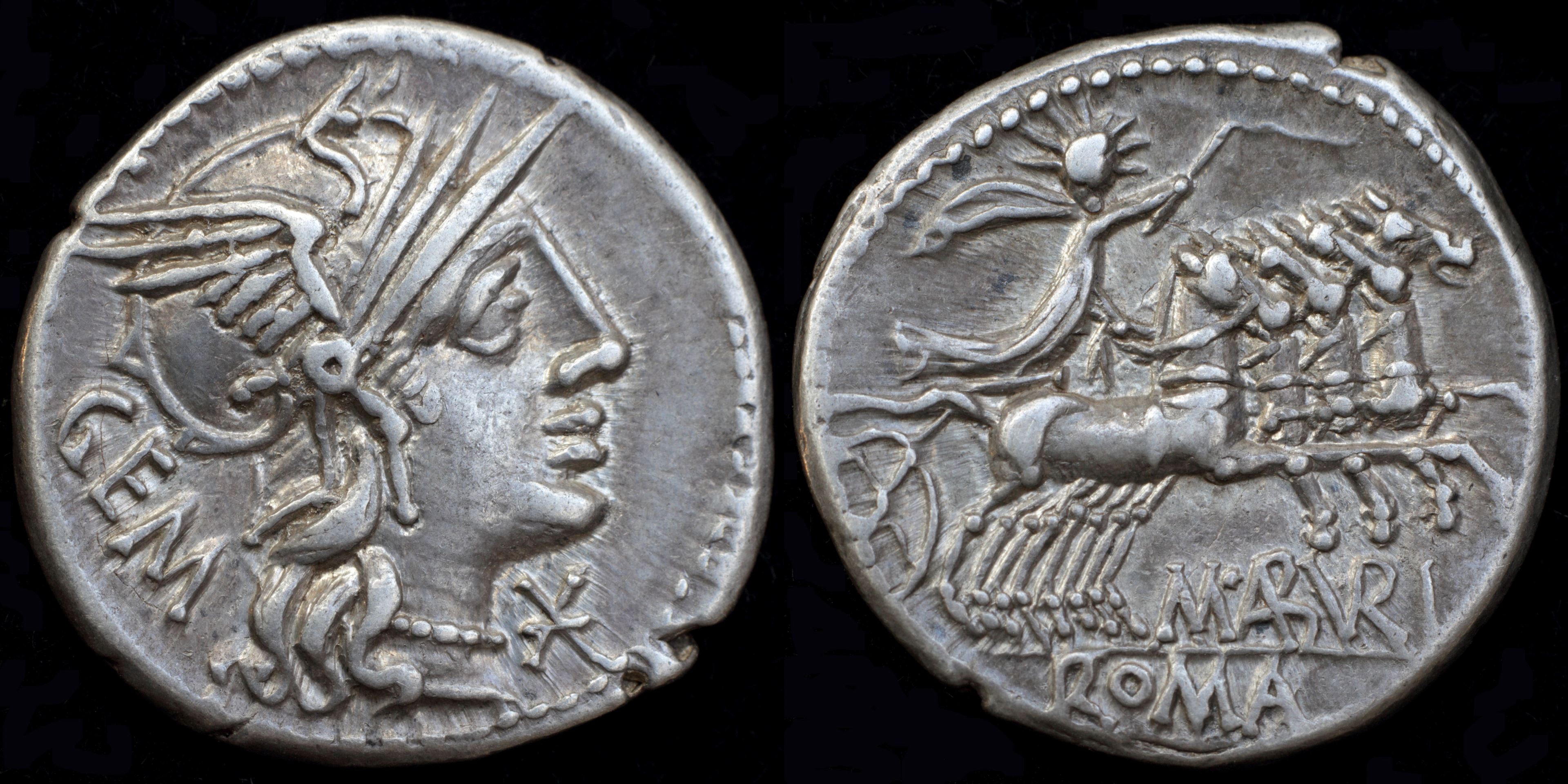
Reverse: Sol in quadriga right holding whip and reins M·(AB)(VR)I ROMA
Die Orientation: -
Weight: 3.9 g
(0).jpg)
Reverse: Sol in quadriga right, holding reins and whip; M•ABVRI below horses, ROMA in exergue
Die Orientation: 12 H
Weight: 3.85 g
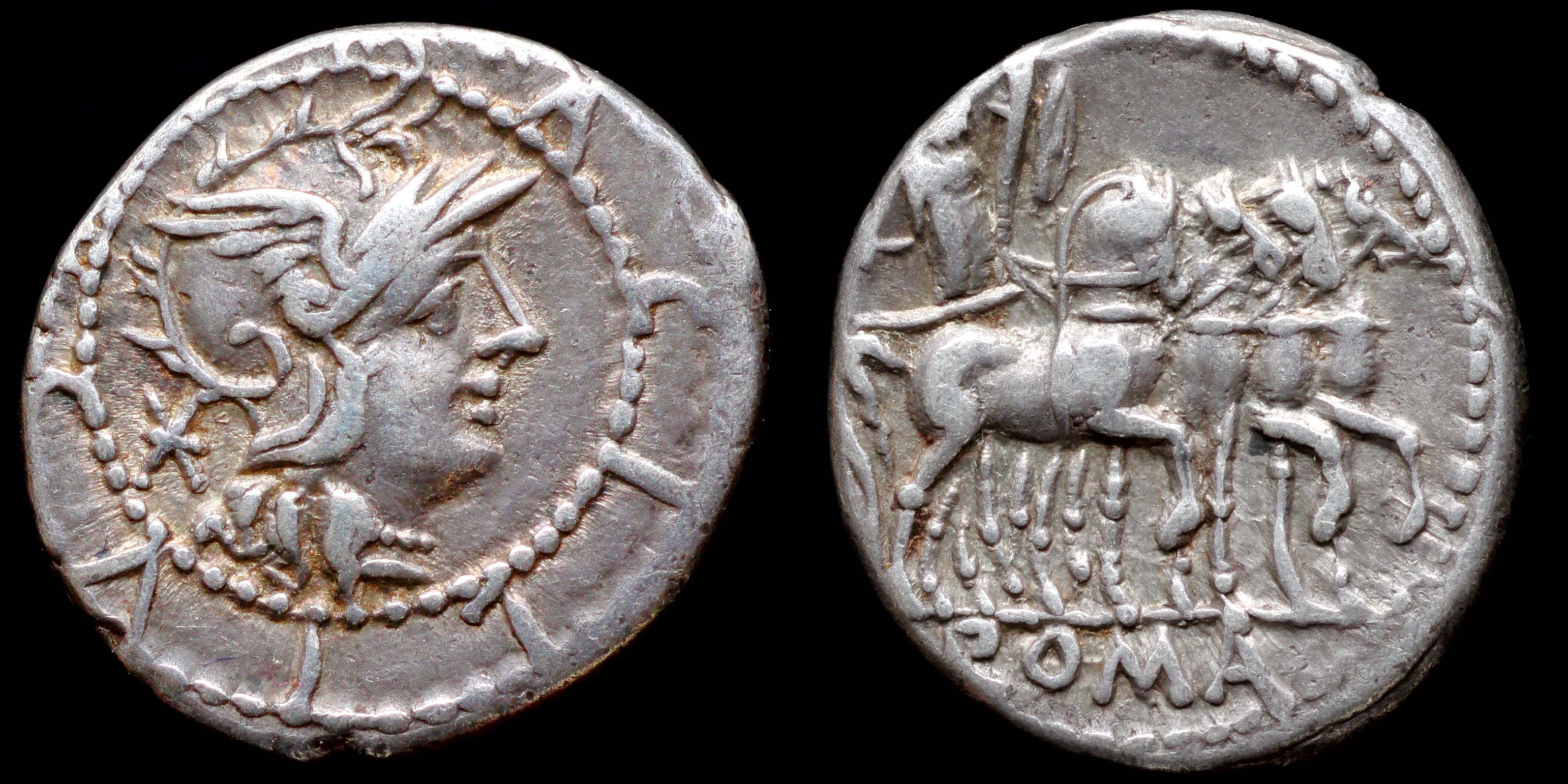
Reverse: Hercules in slow quadriga right holding club and trophy; ROMA
Die Orientation: -
Weight: 3.9 g
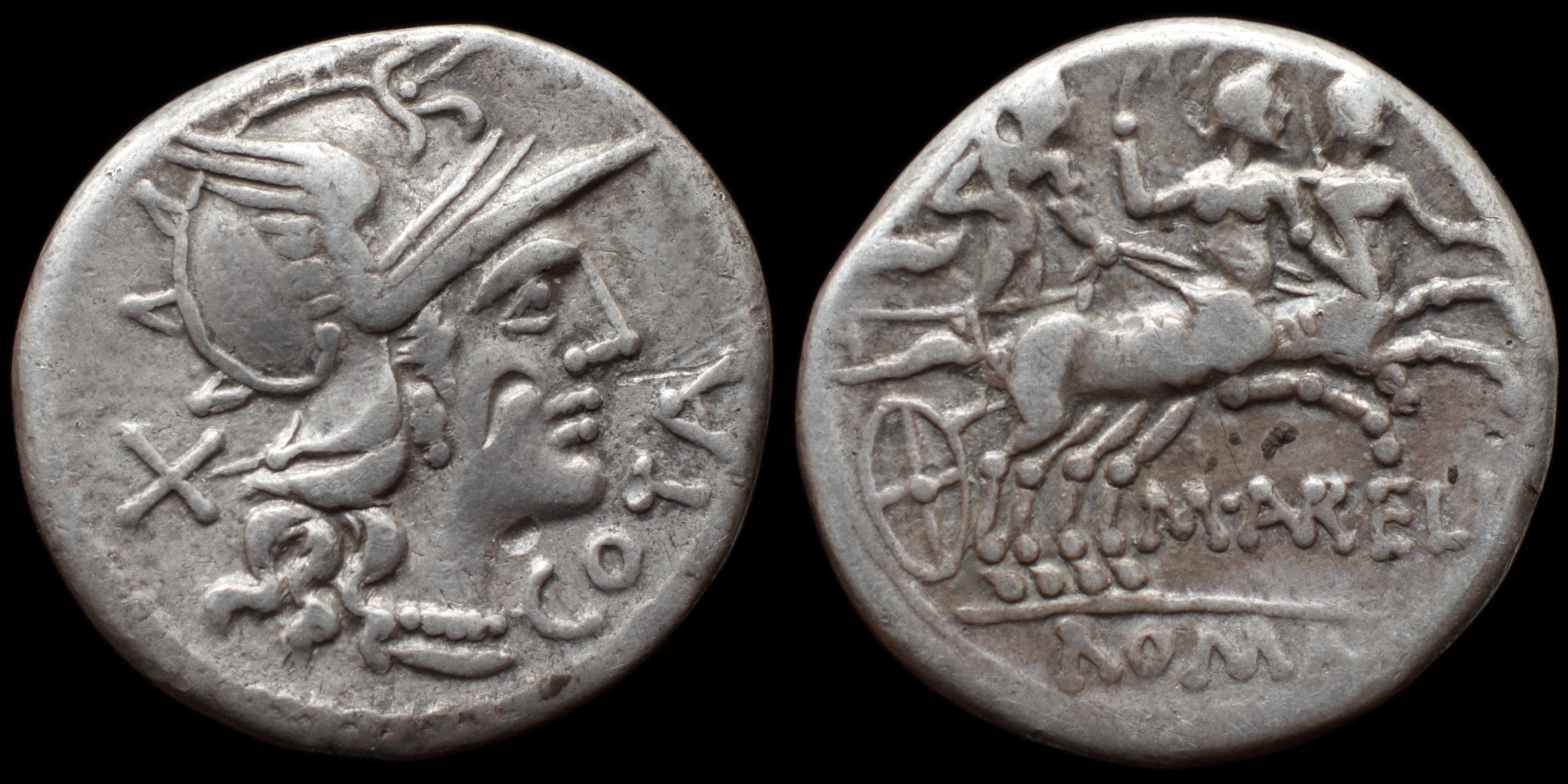
Reverse: Hercules in biga of Centaurs right, each of whom holding a branch, Hercules holding club and reins; M·(AVR)ELI / ROMA
Die Orientation: -
Weight: 3.9 g
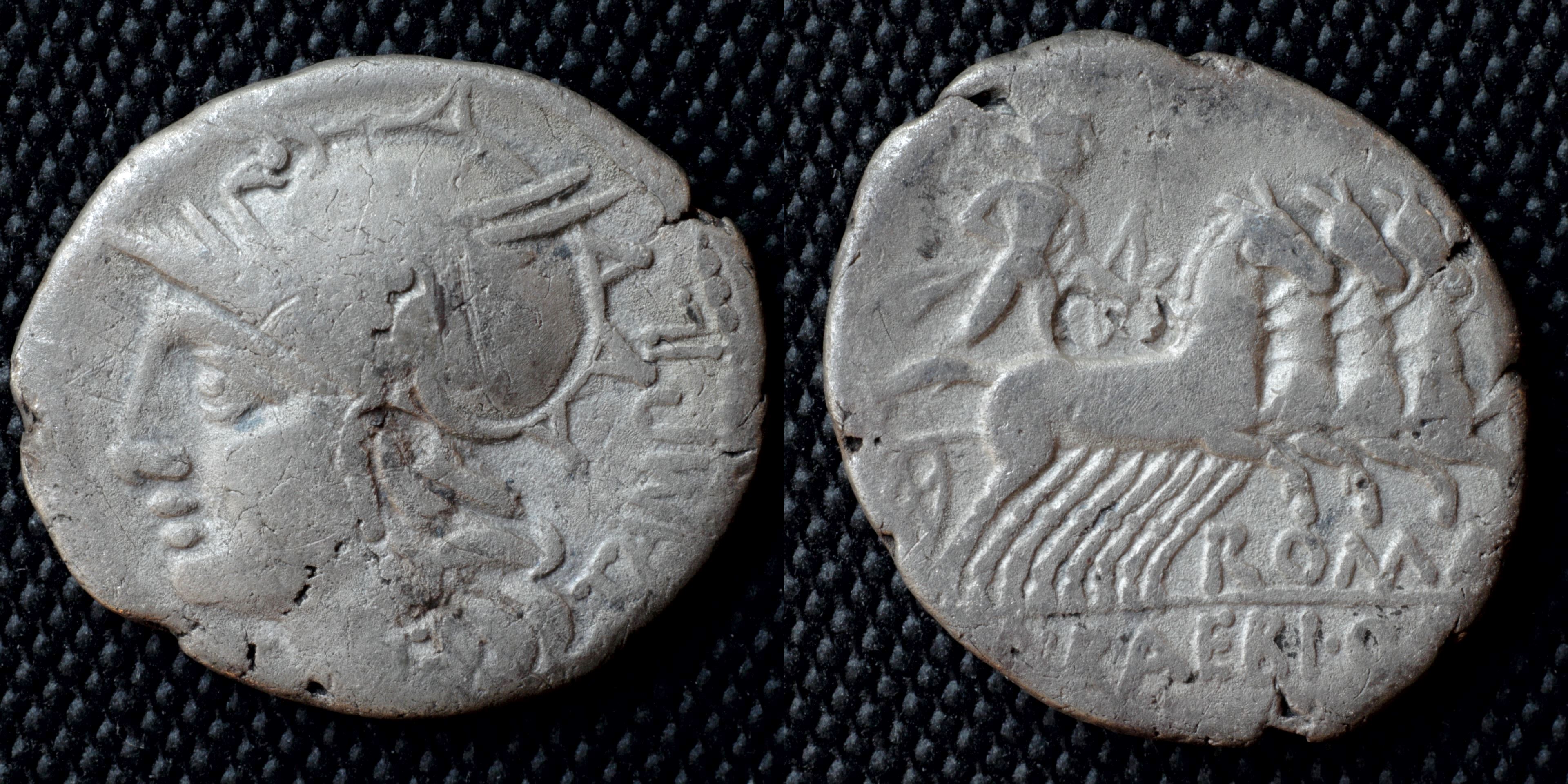
Reverse: Apollo in quadriga right holding branch and reins, bow and arrow ROMA M·BAEBI·Q·F
Die Orientation: -
Weight: 3.68 g
(8).JPG)
Reverse: M•METELLVS Q•F, Macedonian shield with elephant's head in central boss, surrounded by laurel wreath
Die Orientation: 6 H
Weight: 3.85 g
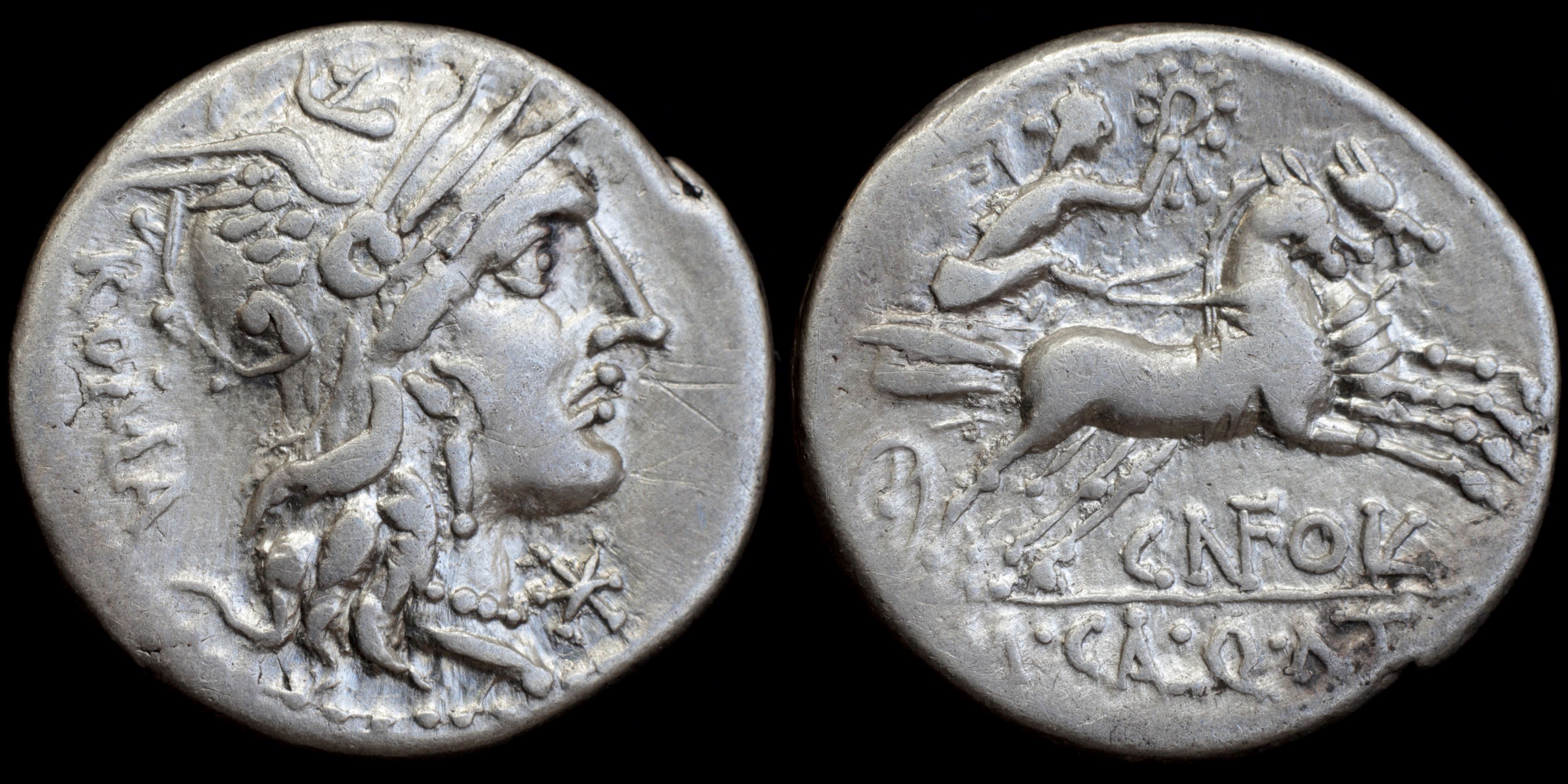
Reverse: Victory in biga right holding wreath and reins C(N F)O(VL) M·C(AL)·Q·(MET)
Die Orientation: -
Weight: 3.9 g
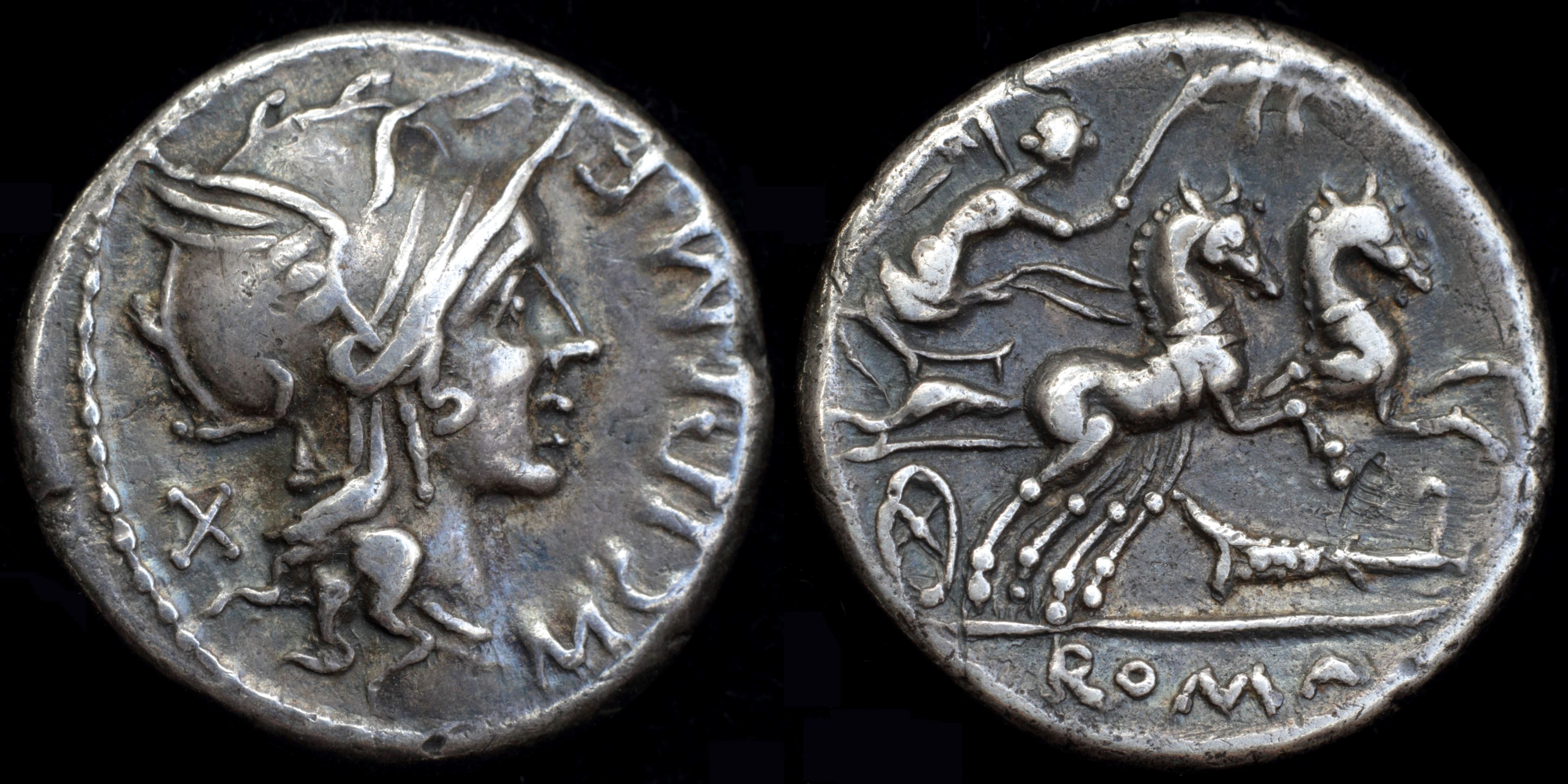
Reverse: Victory in biga right holding palm branch and reins; rudder below ROMA
Die Orientation: -
Weight: 3.9 g

Reverse: Victory driving galloping biga right, holding reins and palm frond; rudder below horses; ROMA in exergue.
Die Orientation: -
Weight: 3.88 g
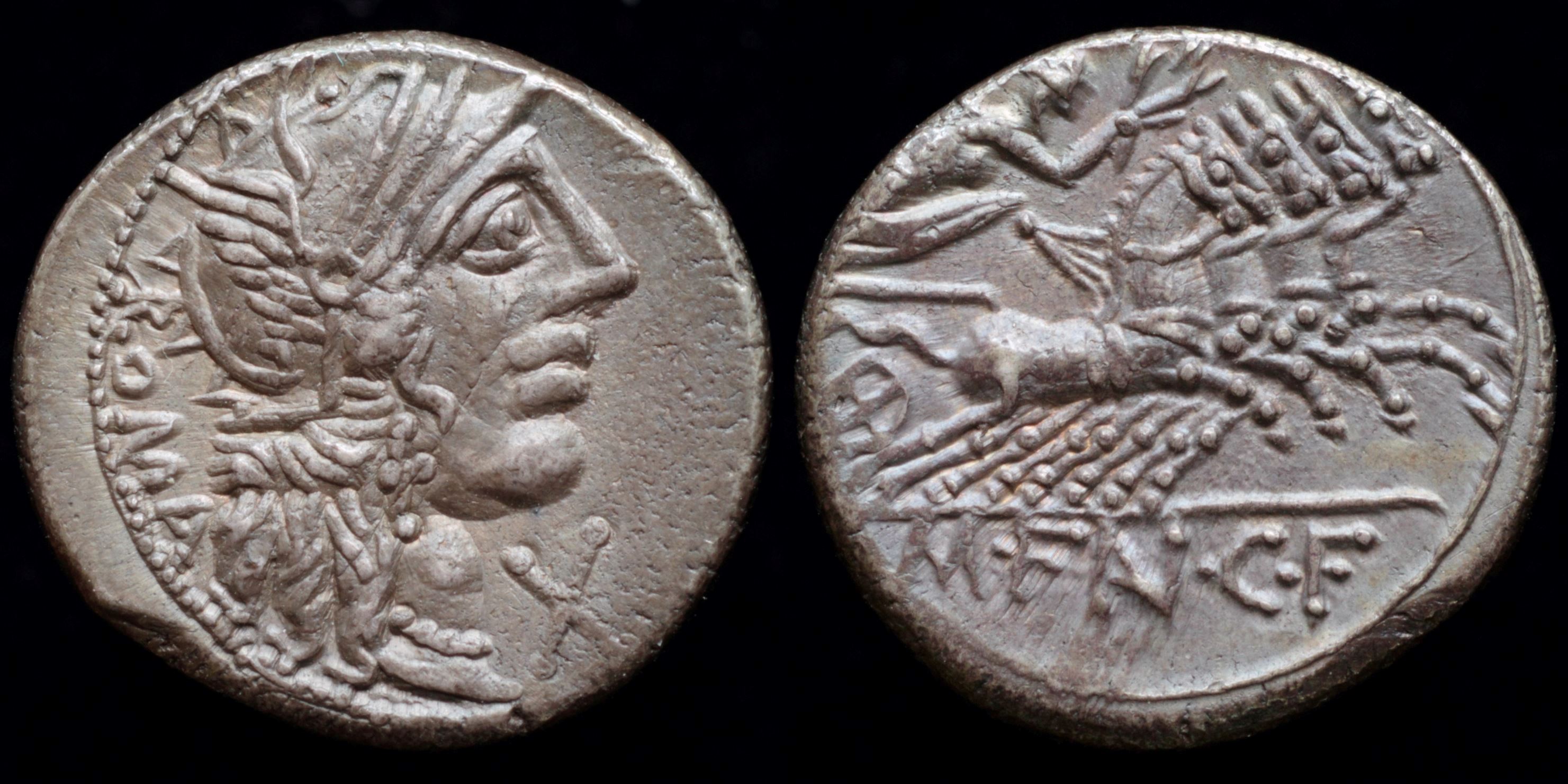
Reverse: Victory in quadriga right holding reins and palm branch M·F(AN)·C·F
Die Orientation: -
Weight: 4.1 g
.jpg)
Reverse: Roma standing left, transverse long scepter in left hand, with right hand placing wreath on trophy of captured Gallic arms with carnyx and shield on each side, star above ROMA (PHI)LI
Die Orientation: -
Weight: 3.8 g
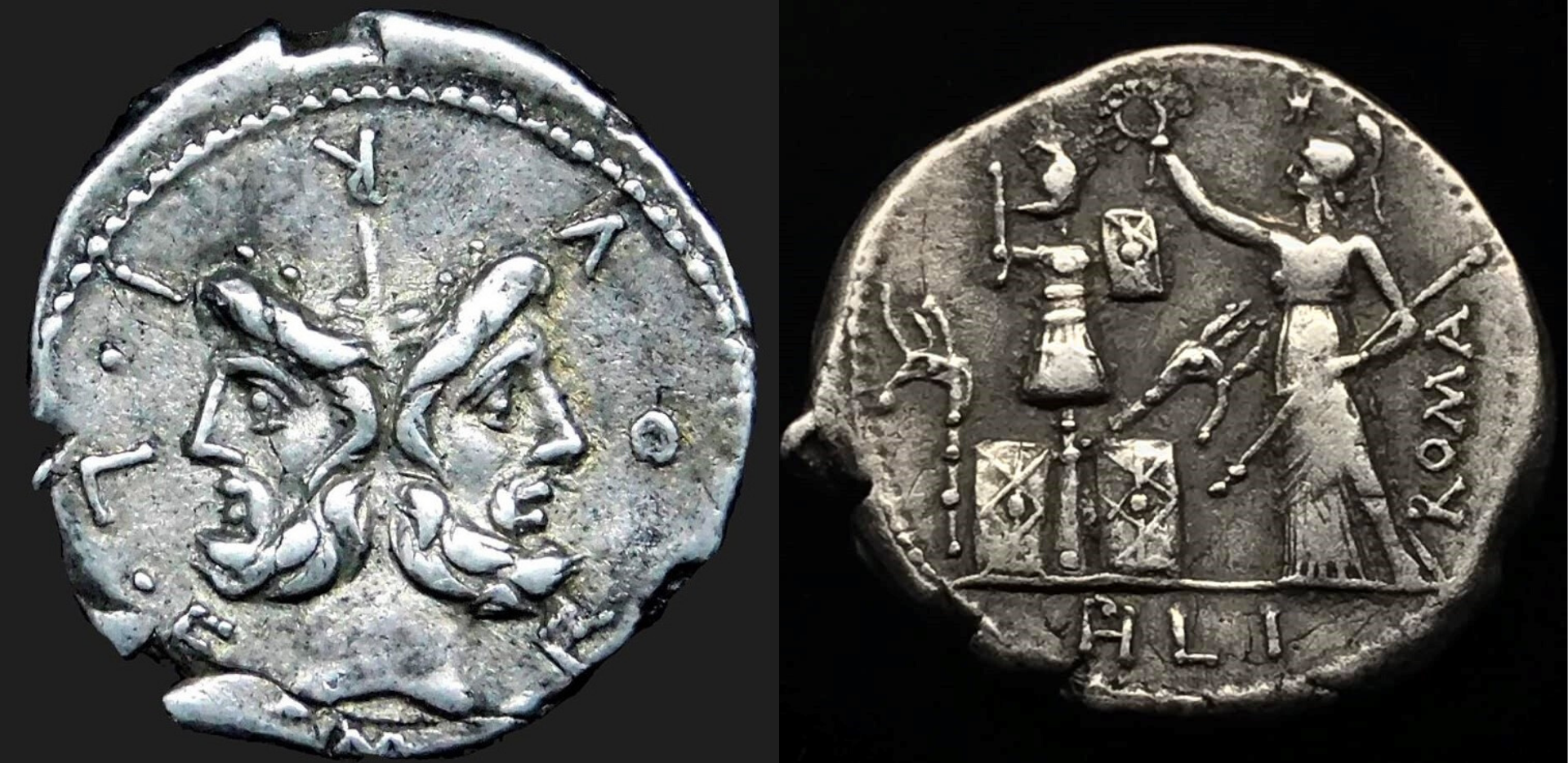
Reverse: PHLI (PH ligate) in exergue, ROMA on right, Roma standing left, holding spear and crowning Gallic trophy with wreath; above, star.
Die Orientation: -
Weight: 3.94 g
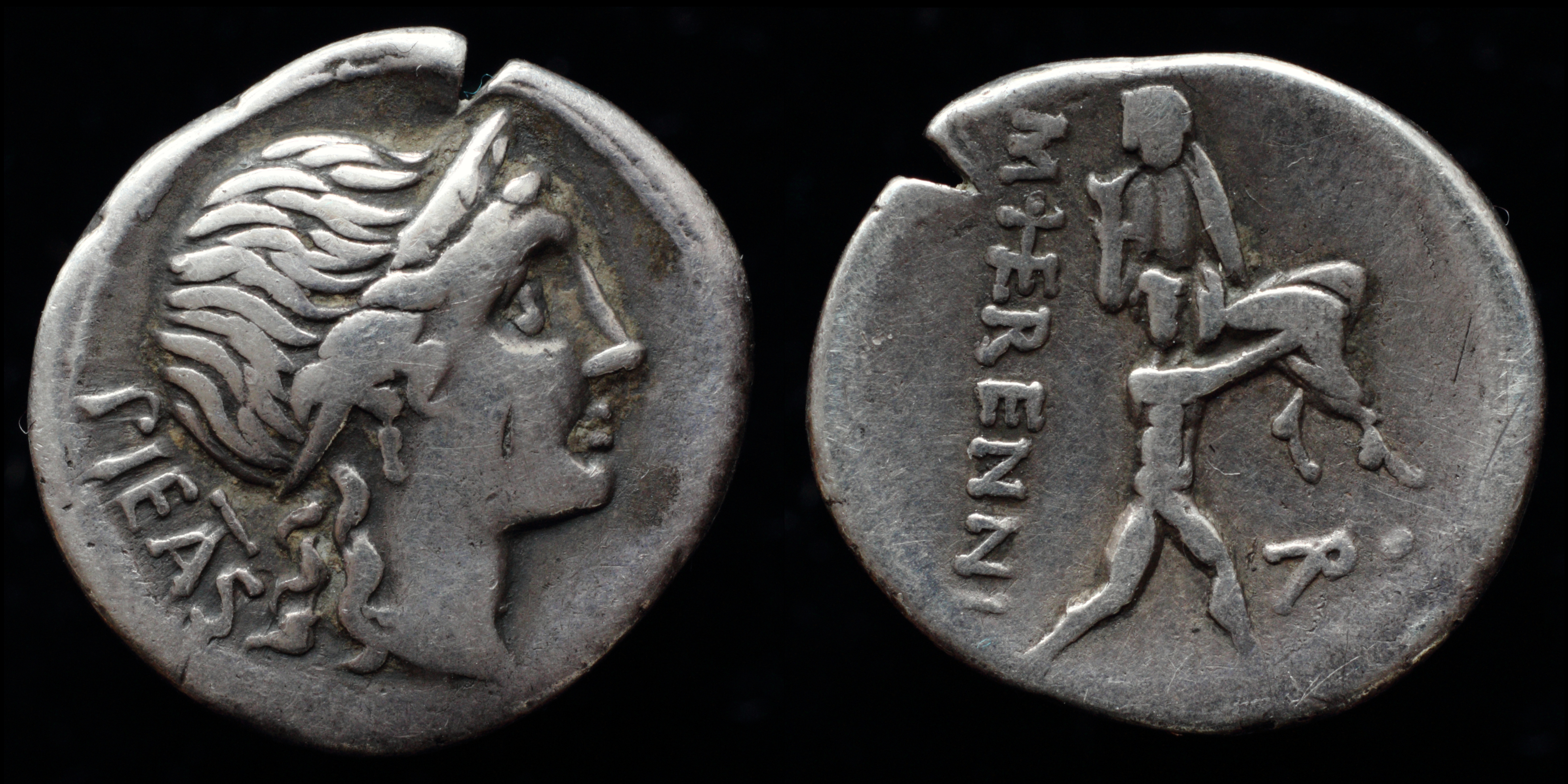
Reverse: Amphinomus right carrying his father; M·(HE)RENNI / Ṙ
Die Orientation: -
Weight: 3.8 g
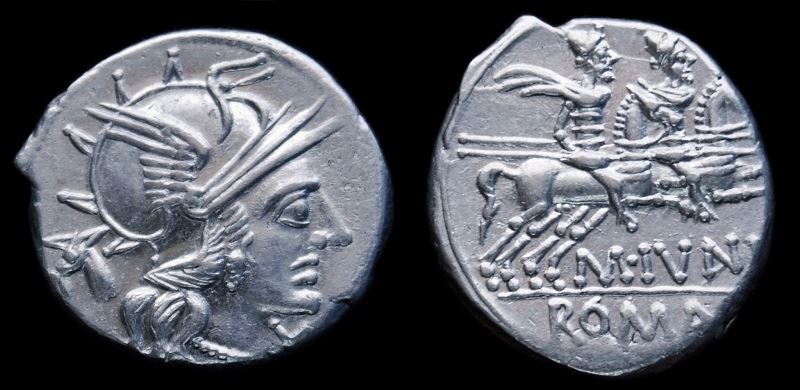
Reverse: The Dioscuri riding right; M•IVNI below, ROMA in exergue.
Die Orientation: 3 H
Weight: 4.12 g
In 109 BC Silanus achieved to become consul as the first member of his family, the Iunii Silani. He held this highest public office together with Quintus Caecilius Metellus Numidicus, who had to continue the war against Jugurtha, king of Numidia, whereas Silanus undertook to fight against the Cimbri. To increase the power of Rome Silanus abolished the exemptions from the military service. Probably before their battle with the consul the traveling Cimbri had asked to be given a domicile on Roman territory, but the Senate had declined their request. Silanus then rushed towards the Cimbri with his army but he was defeated at an unknown location in Gallia Transalpina.
In 104 BC the tribune of the people Gnaeus Domitius Ahenobarbus accused Silanus of his military failure, but the former consul was acquitted."
Provenance: Bertolami Fine Arts, E-Live Auction 49 (12 November 2017), lot 636.
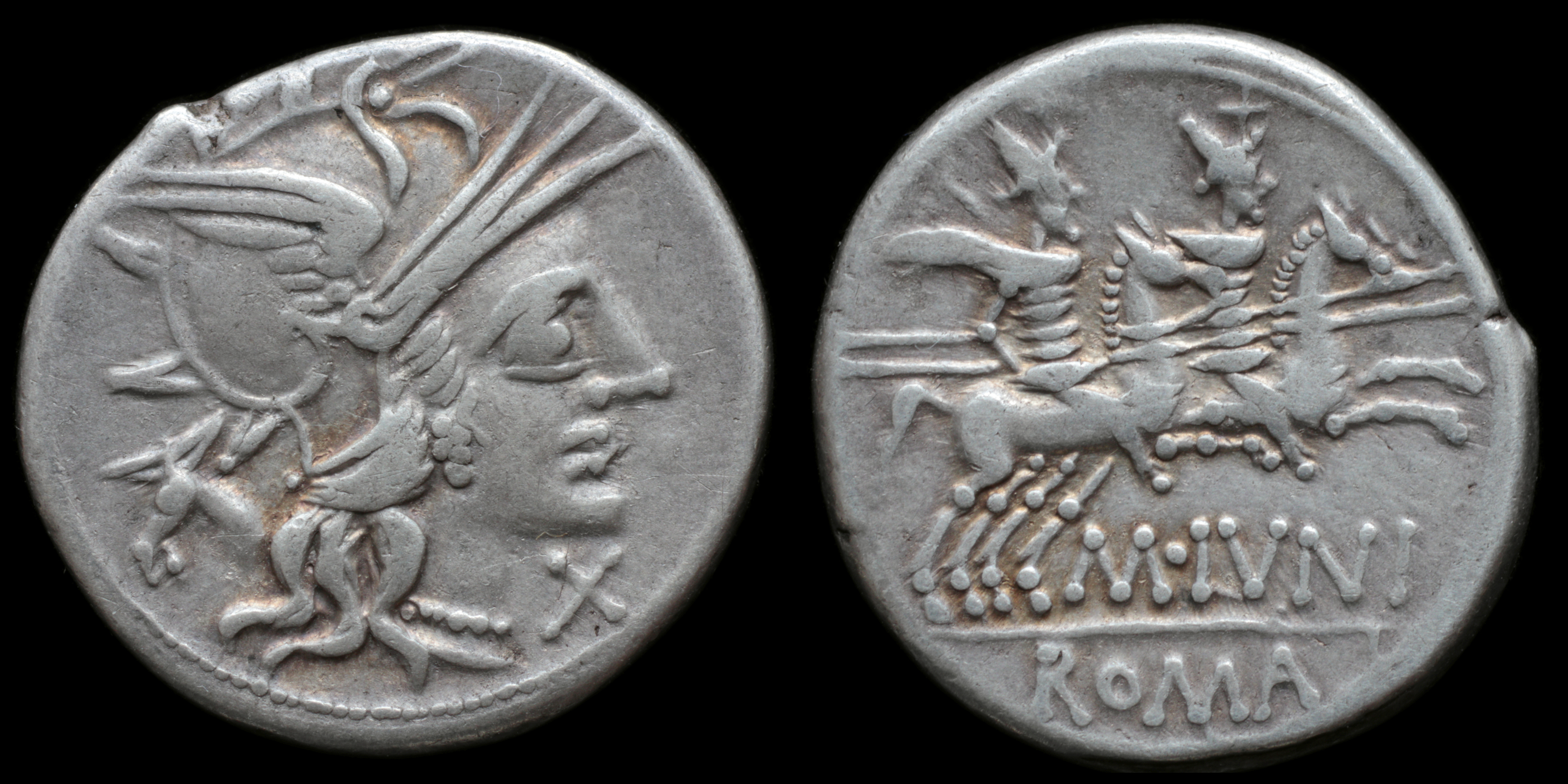
Reverse: Dioscuri on horses right holding spears and reins; M·IVNI / ROMA
Die Orientation: -
Weight: 3.6 g
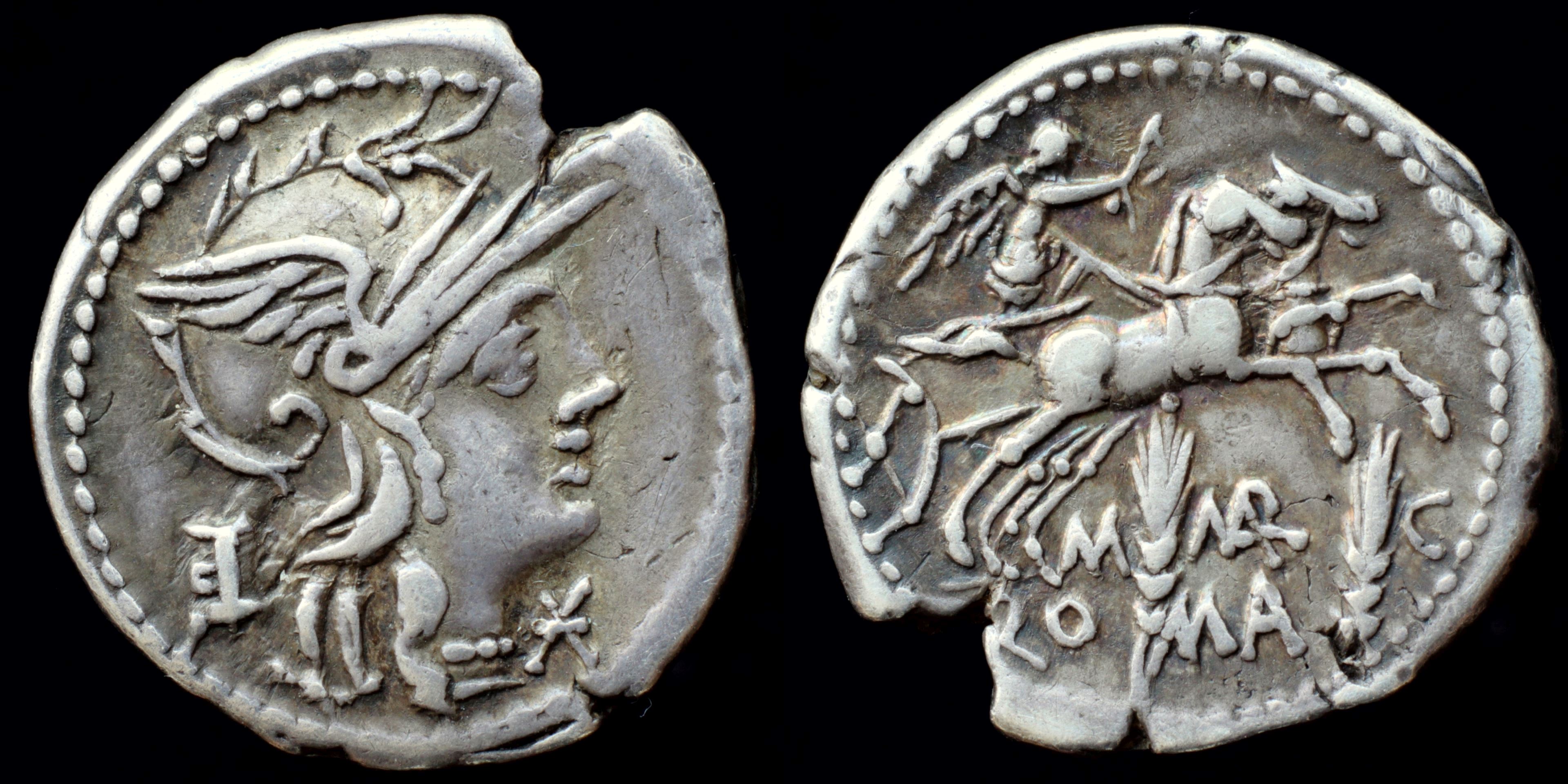
Reverse: Victory in biga right holding whip and reins; two heads of grain below; M__(MAR)_C / RO_MA
Die Orientation: -
Weight: 3.8 g
.jpg)
Reverse: Victory in biga right, M MAR C / RO MA below divided by two ears of corn
Die Orientation: -
Weight: 3.81 g
.jpg)
Reverse: Libertas driving quadriga right, holding pileus in right hand; Victory flying left above, crowning Libertas; M•PORC below, ROMA in exergue
Die Orientation: 5 H
Weight: 3.96 g
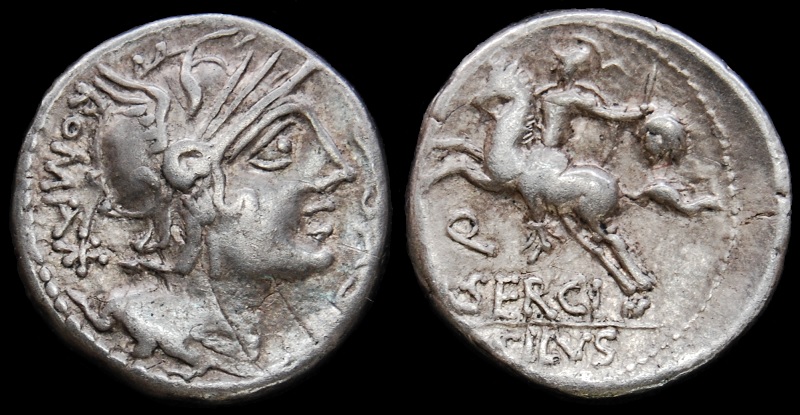
Reverse: Horseman galloping to the left; holding sword and severed head in hand; Q and M SERGI below; SILUS in exergue.
Die Orientation: 7 H
Weight: 3.85 g
Marcus Sergius was a Roman general during the Second Punic War (218 to 201 BC). He is famed in prosthetics circles as the first documented user of a prosthetic hand. The metal hand was constructed to allow him to hold his shield in battle.
A description of Marcus Sergius is found in the seventh book of Pliny's Natural History, published in AD 77:
Nobody - at least in my opinion - can rightly rank any man above Marcus Sergius, although his great-grandson Catiline shames his name. In his second campaign Sergius lost his right hand. In two campaigns he was wounded twenty-three times, with the result that he had no use in either hand or either foot: only his spirit remained intact. Although disabled, Sergius served in many subsequent campaigns. He was twice captured by Hannibal - no ordinary foe- from whom twice he escaped, although kept in chains and shackles every day for twenty months. He fought four times with only his left hand, while two horses he was riding were stabbed beneath him. He had a right hand made of iron for him and, going into battle with this bound to his arm, raised the siege of Cremona, saved Placentia and captured twelve enemy camps in Gaul - all of which exploits were confirmed by the speech he made as praetor when his colleagues tried to debar him as infirm from the sacrifices. What piles of wreaths he would have amassed in the face of a different enemy!
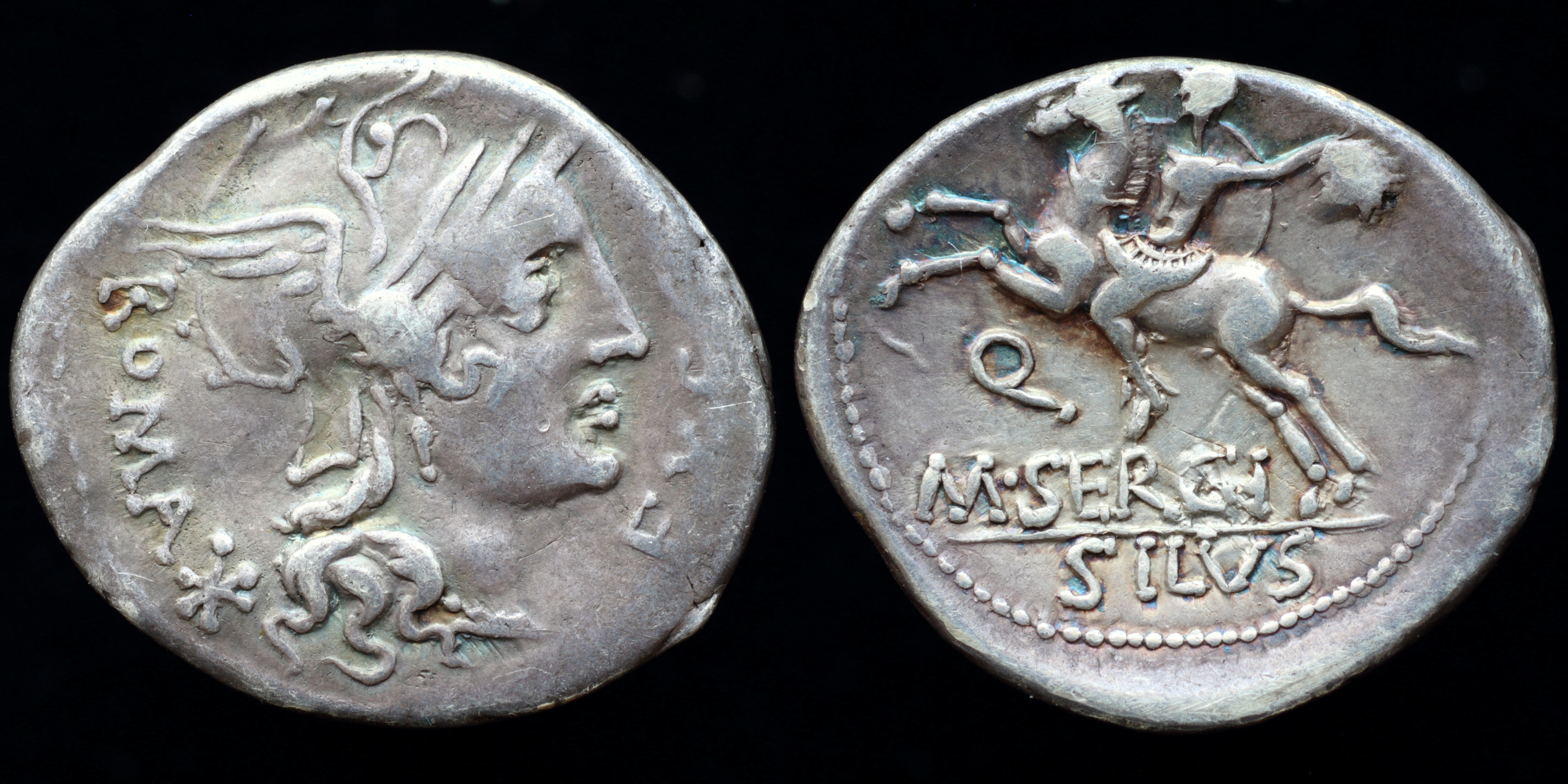
Reverse: moneyer's grandfather as horseman left wearing helmeted, holding sword and severed Gallic head; Q / M·SERGI / SILVS
Die Orientation: -
Weight: 3.9 g
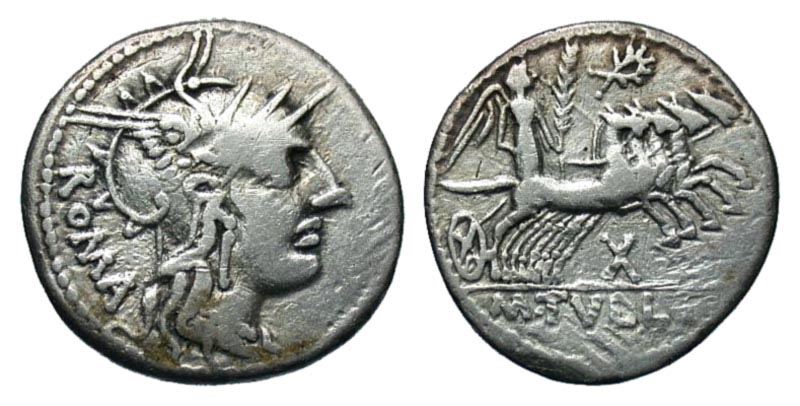
Reverse: M·TVLLI, Victory driving quadriga right, holding reigns and palm, wreath above, X below horses
Die Orientation: 2 H
Weight: 3.8 g
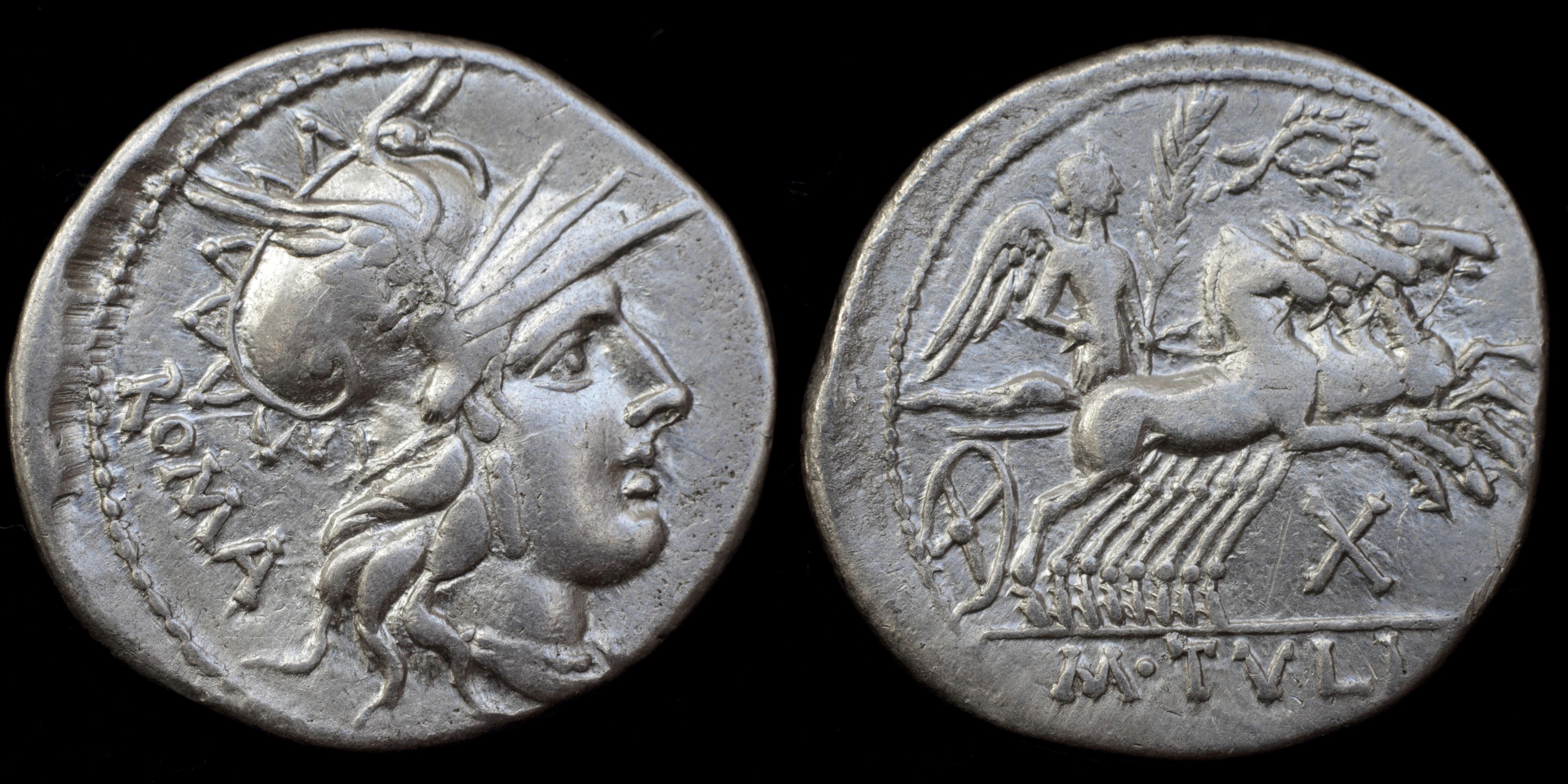
Reverse: Victory in quadriga right holding reins and palm branch; wreath above X M·TVLLI
Die Orientation: -
Weight: 4 g
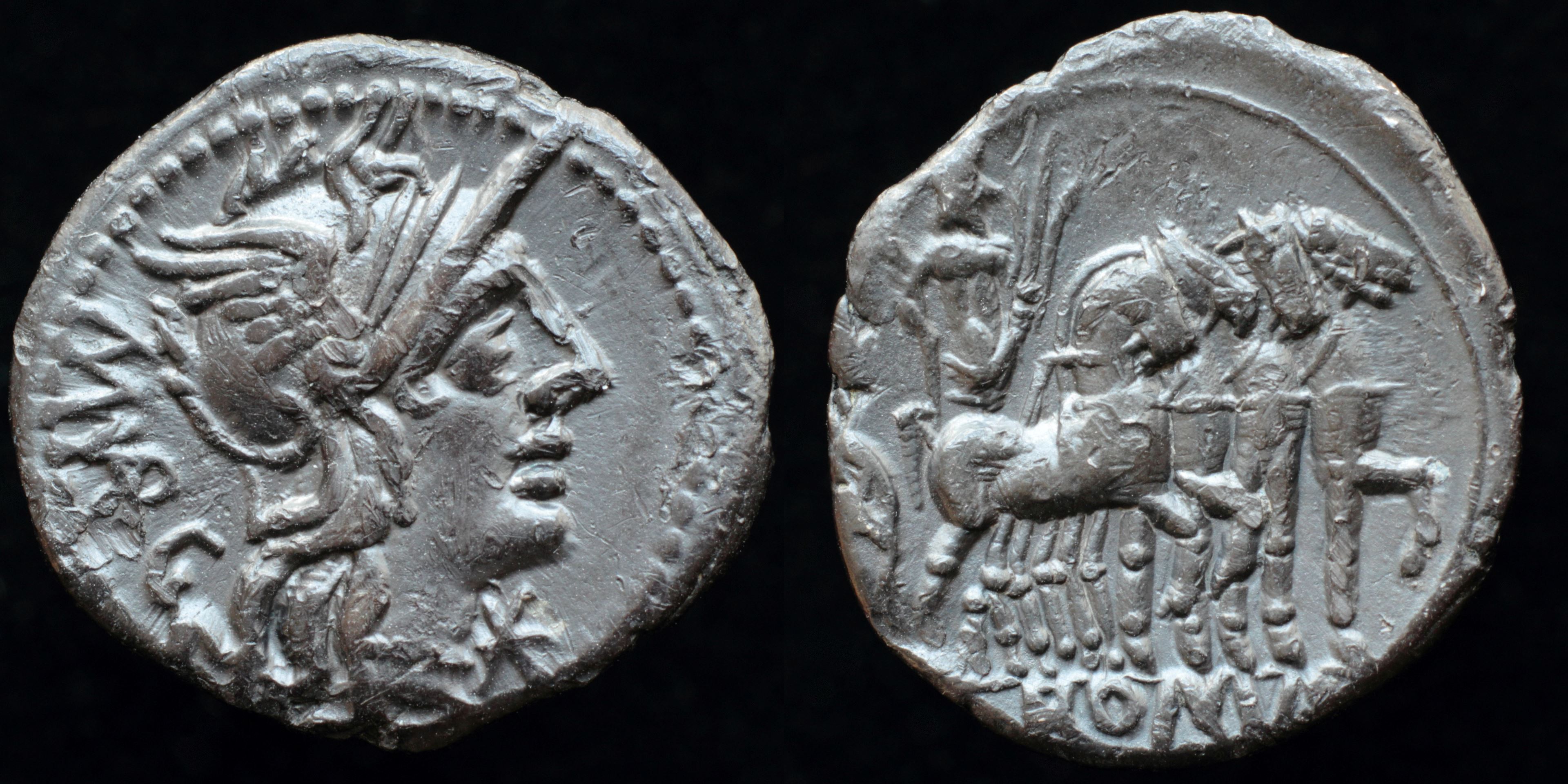
Reverse: Jupiter in quadriga right, holding branch and thunderbolt ROMA
Die Orientation: -
Weight: 3.8 g
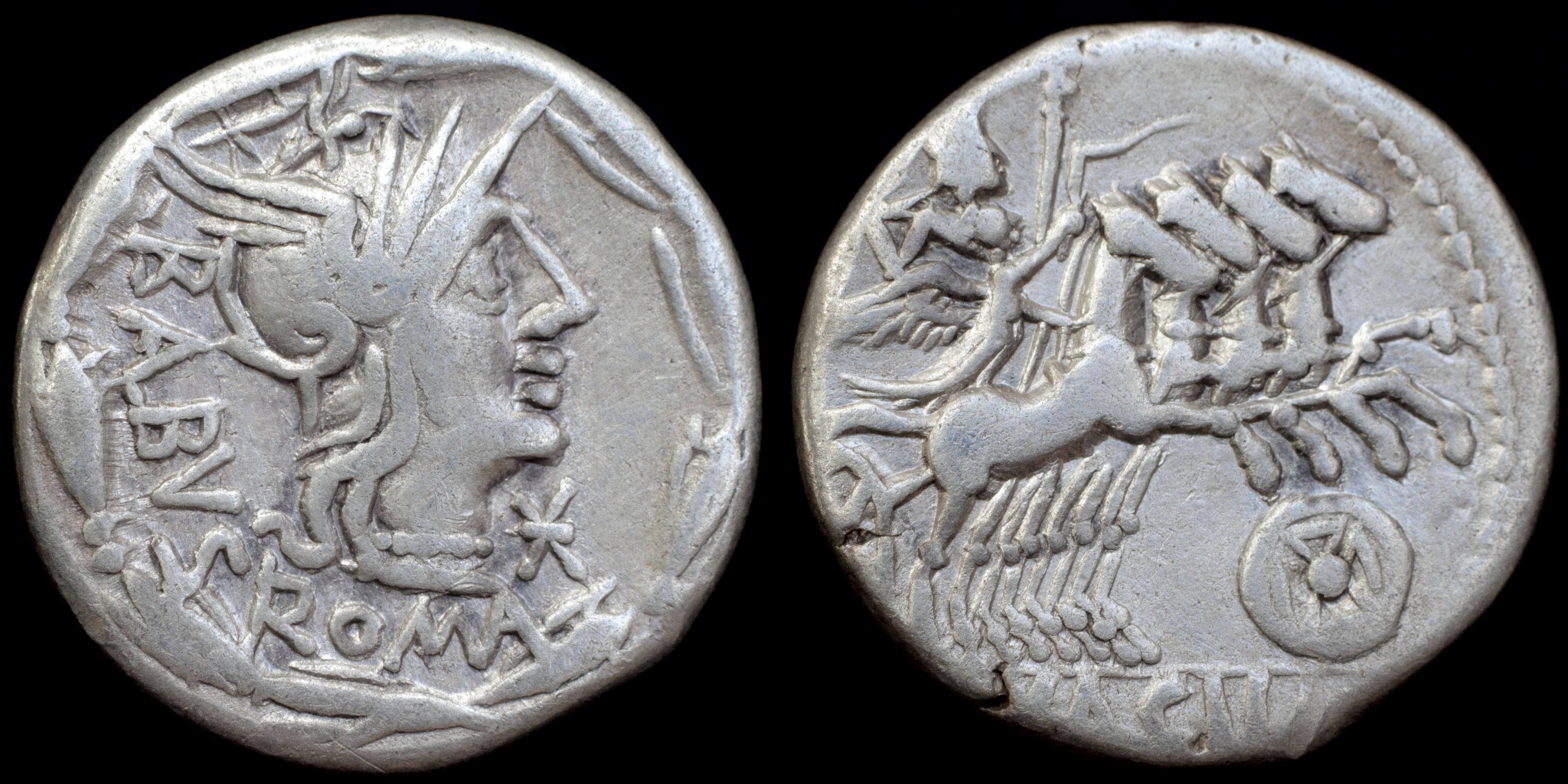
Reverse: Jupiter and Victory in quadriga right. Jupiter holding thunderbolt and scepter. Victory holding whip and reins. Macedonian shield below. (MN).ACILI
Die Orientation: -
Weight: 3.8 g
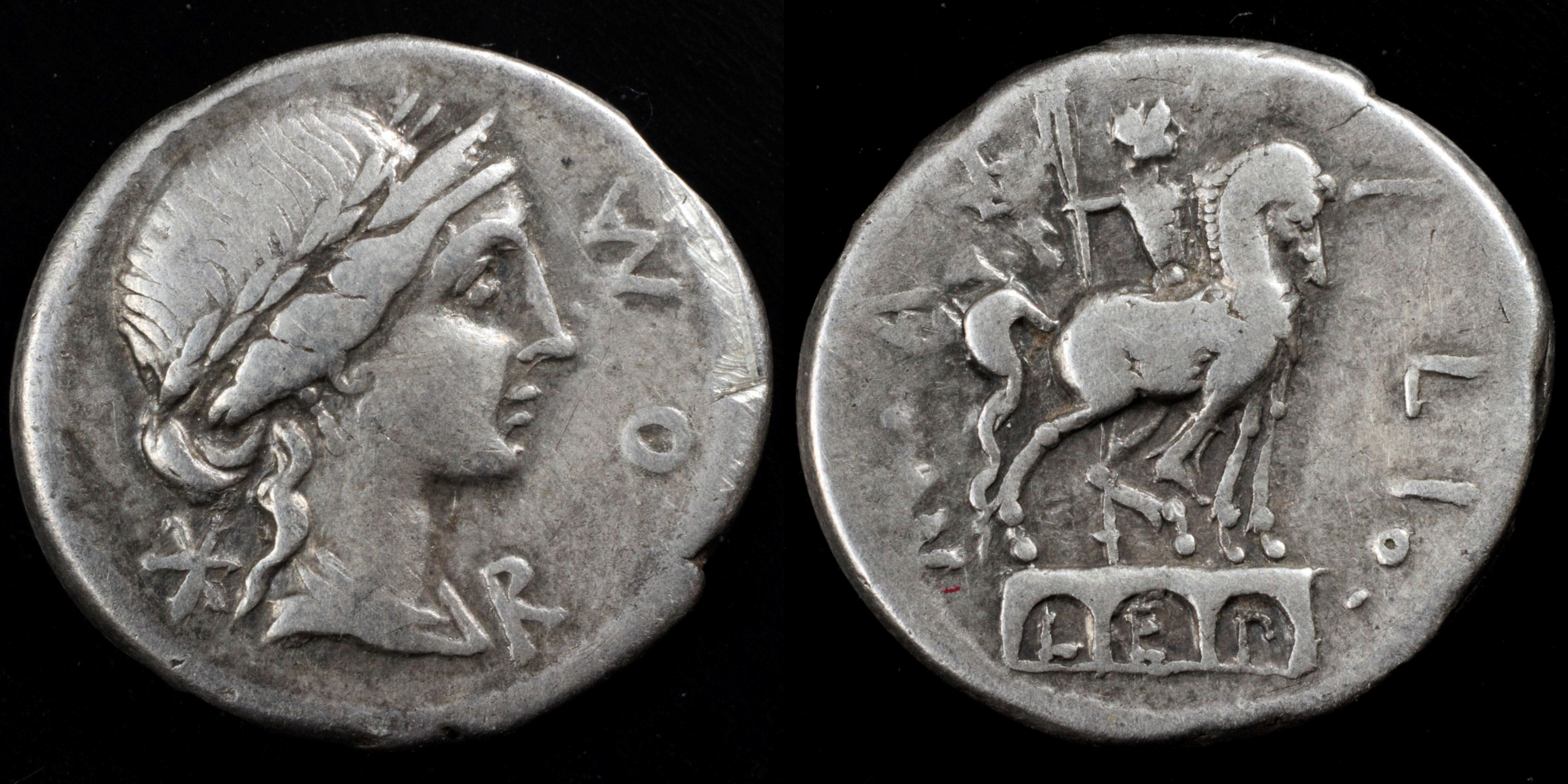
Reverse: equestrian statue on aquaduct right, holding vertical spear, standing on 3 archs of aquaduct (Aqua Marcia) (MN)·AEMILIO· L-E-P
Die Orientation: -
Weight: 3.8 g
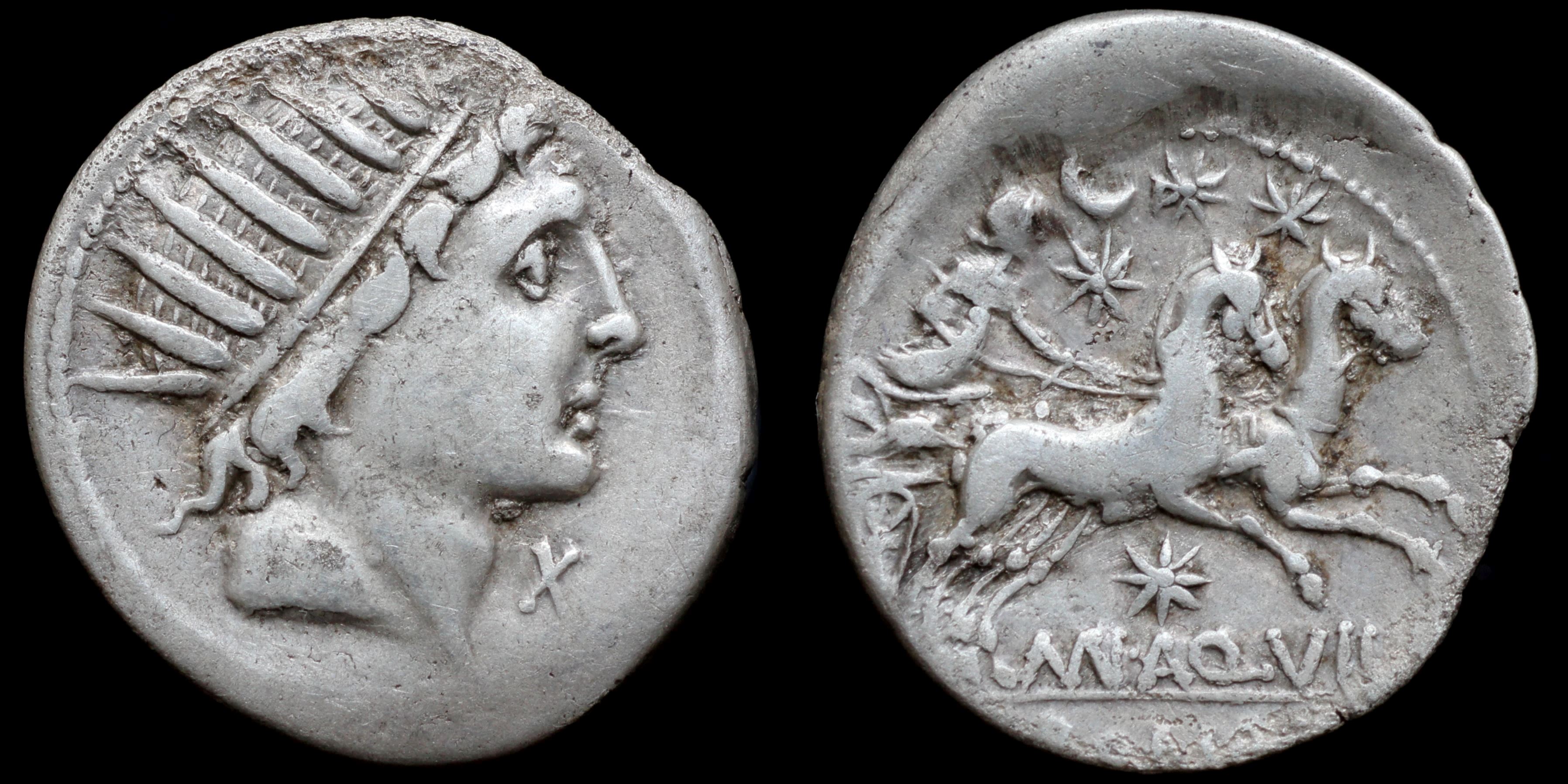
Reverse: Luna in biga right, crescent and three stars above, star below; (MN)·AQVIL / ROMA
Die Orientation: -
Weight: 3.9 g
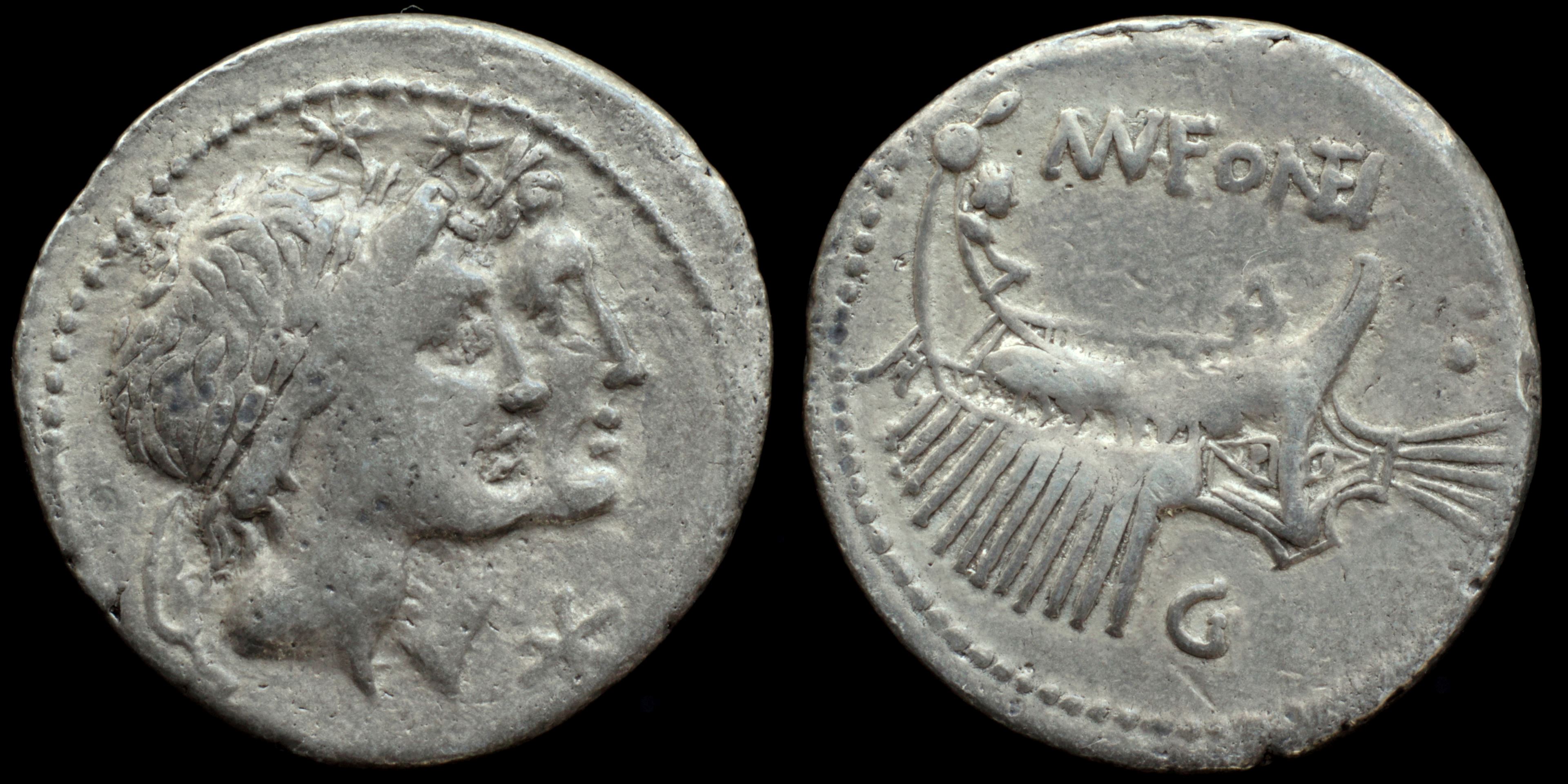
Reverse: war galley half right; MN·FO(NTE)I / : / G
Die Orientation: -
Weight: 3.9 g
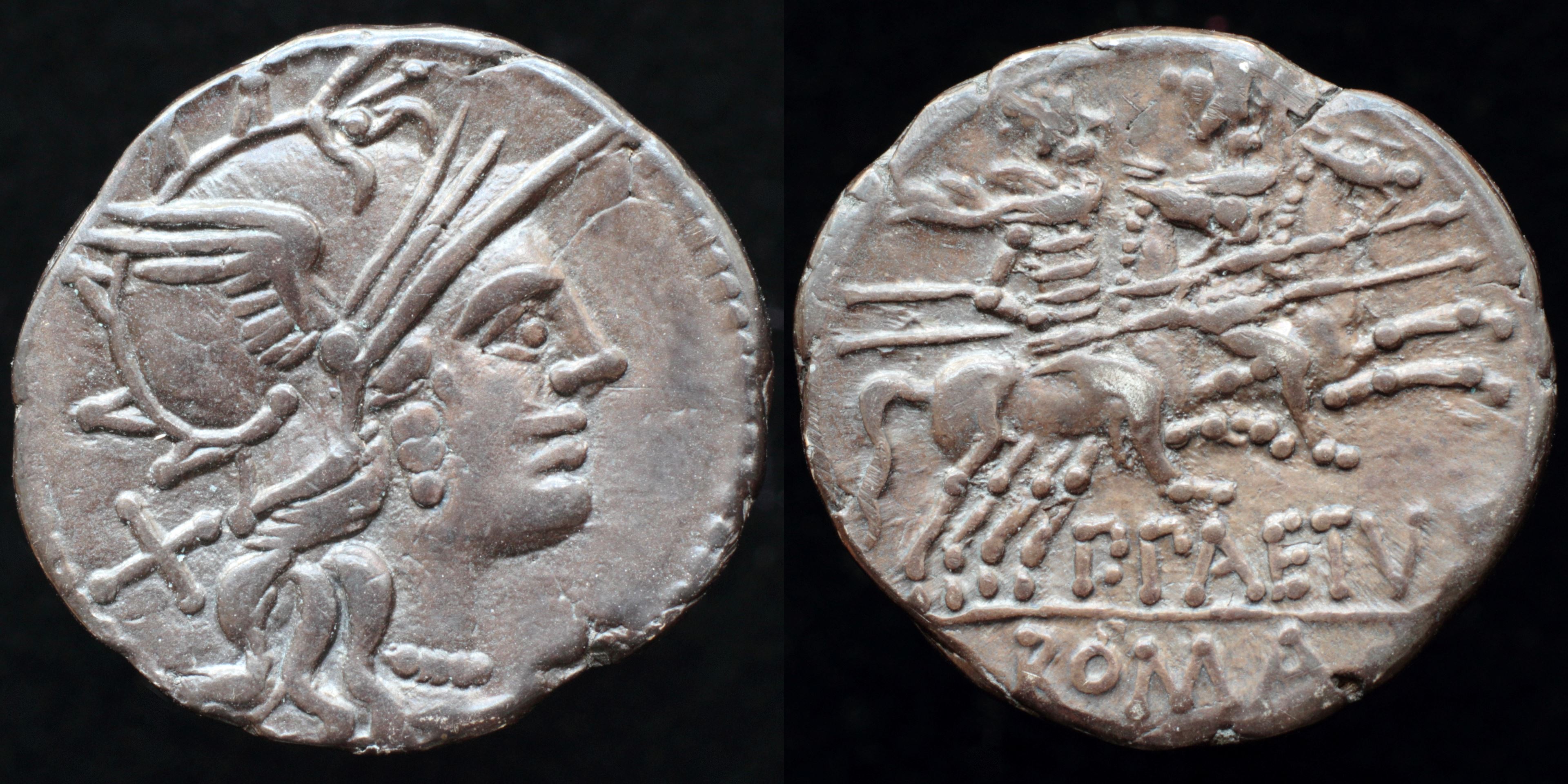
Reverse: Dioscuri riding on horses right holding spears and reins; stars over their heads P·PAETVS ROMA
Die Orientation: -
Weight: 4 g
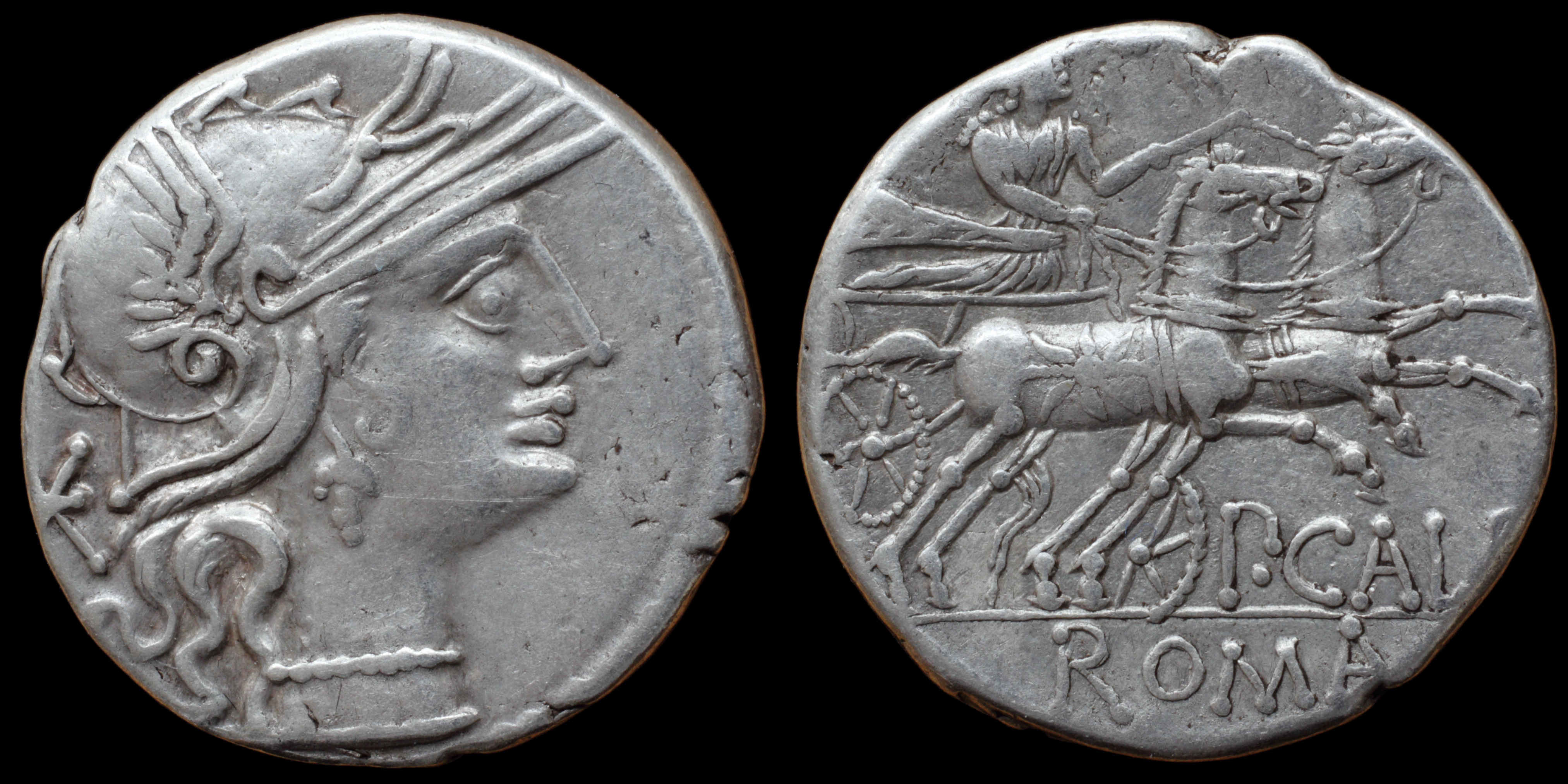
Reverse: Venus right in biga holding whip and reins, crowned by Victory flying left; P·CALP / ROMA
Die Orientation: -
Weight: 3.9 g
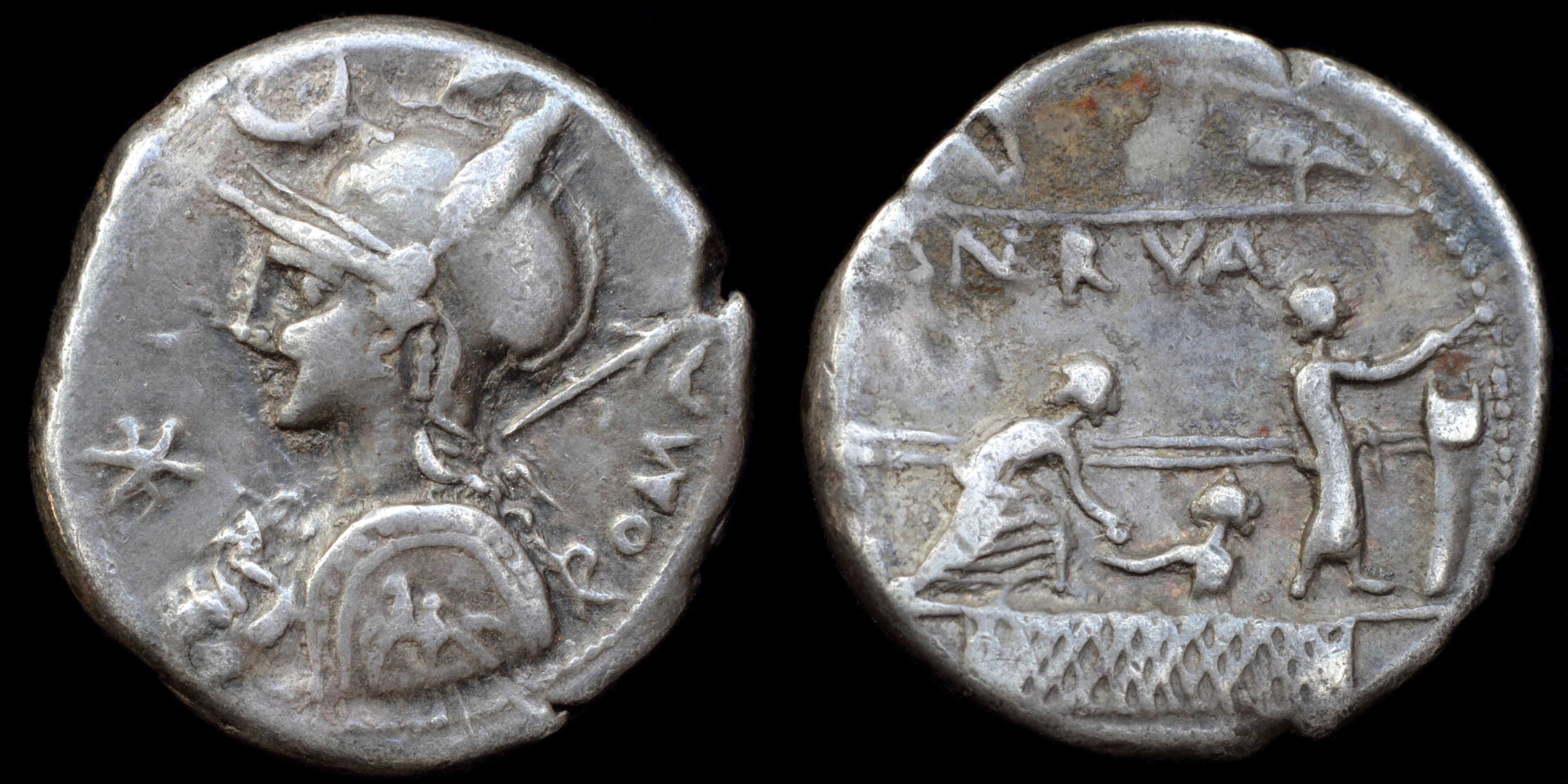
Reverse: two citizens casting ballots in the Comitium, attendant handing voting tablet to one citizen, screen behind surmounted by marker with initial "P" representing the voting tribe P·(NE)RVA
Die Orientation: -
Weight: 3.9 g
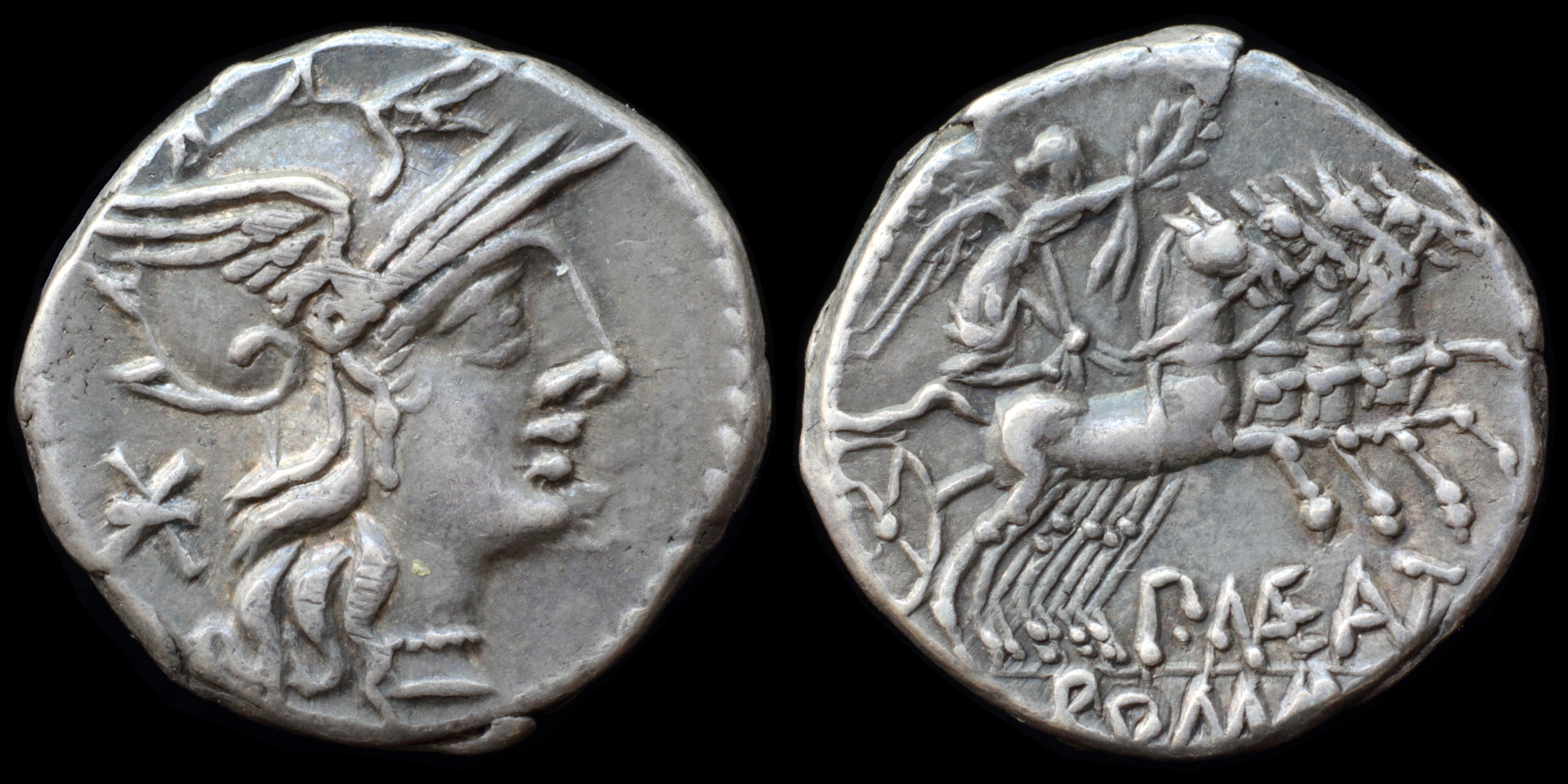
Reverse: Victory in quadriga right holding wreath and reins P·(MAE) (ANT) ROMA
Die Orientation: -
Weight: 3.9 g
_WHITE.jpg)
Reverse: Victory driving quadriga right, P•MAE ANT (ligate) below; ROMA in exergue
Die Orientation: 8 H
Weight: 3.91 g
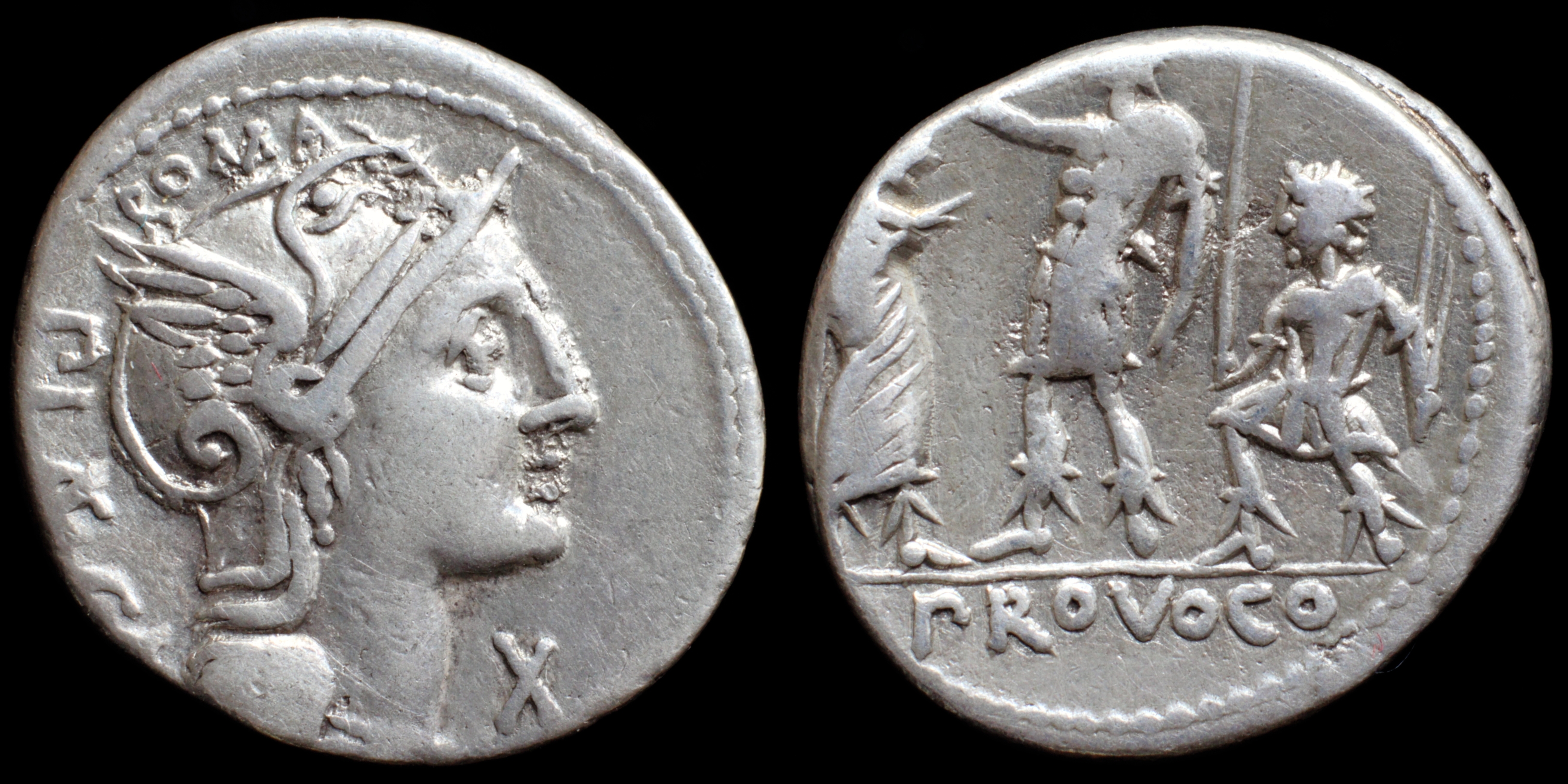
Reverse: magistrate standing left in military dress with hand raised, citizen in toga before him, attendant behind magistrate with rod in right and two rods in left PROVOCO
Die Orientation: -
Weight: 3.9 g
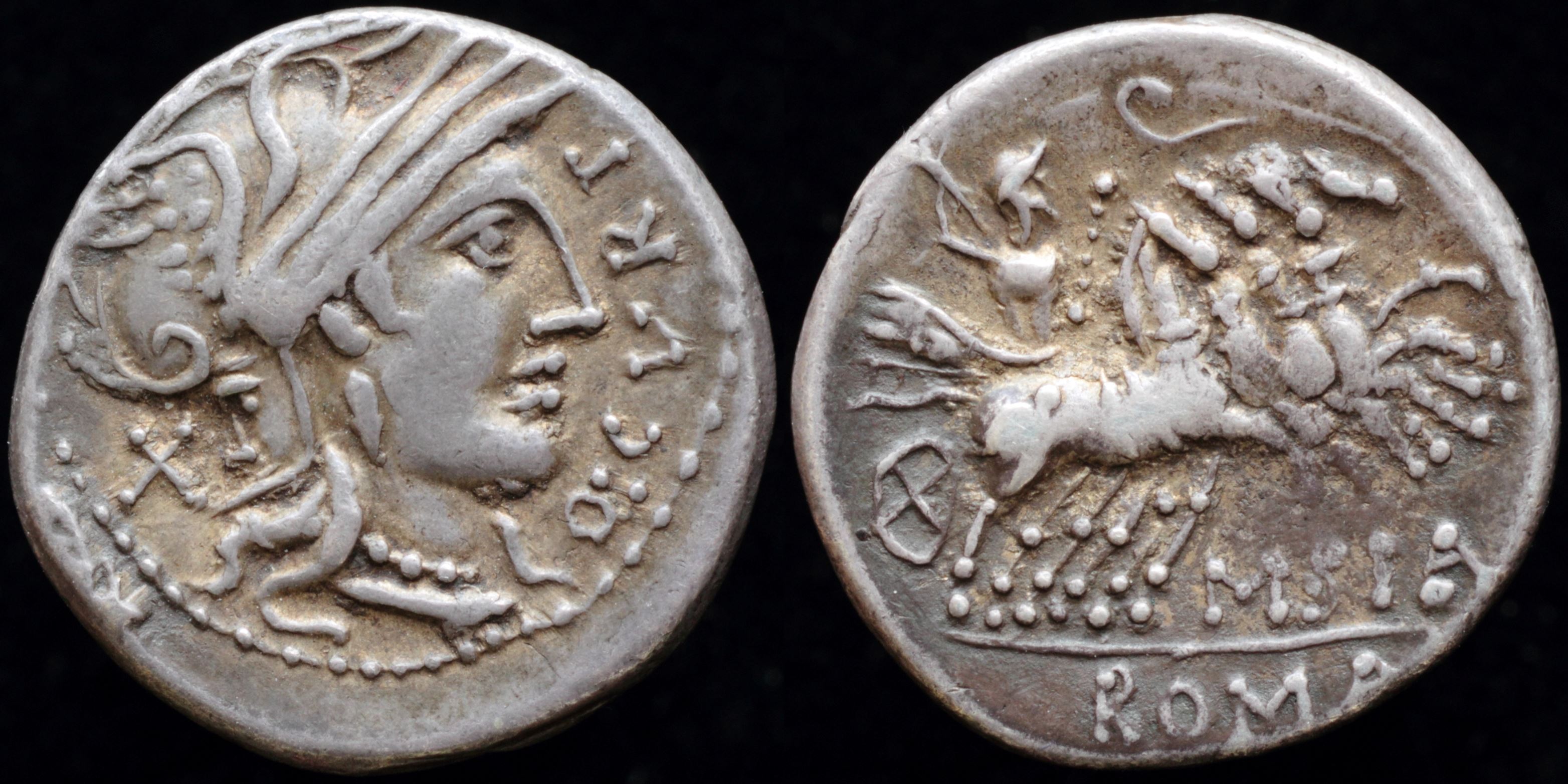
Reverse: Jupiter in quadriga right hurling thunderbolt and holding scepter, lituus above M SI(LA) ROMA
Die Orientation: -
Weight: 4 g
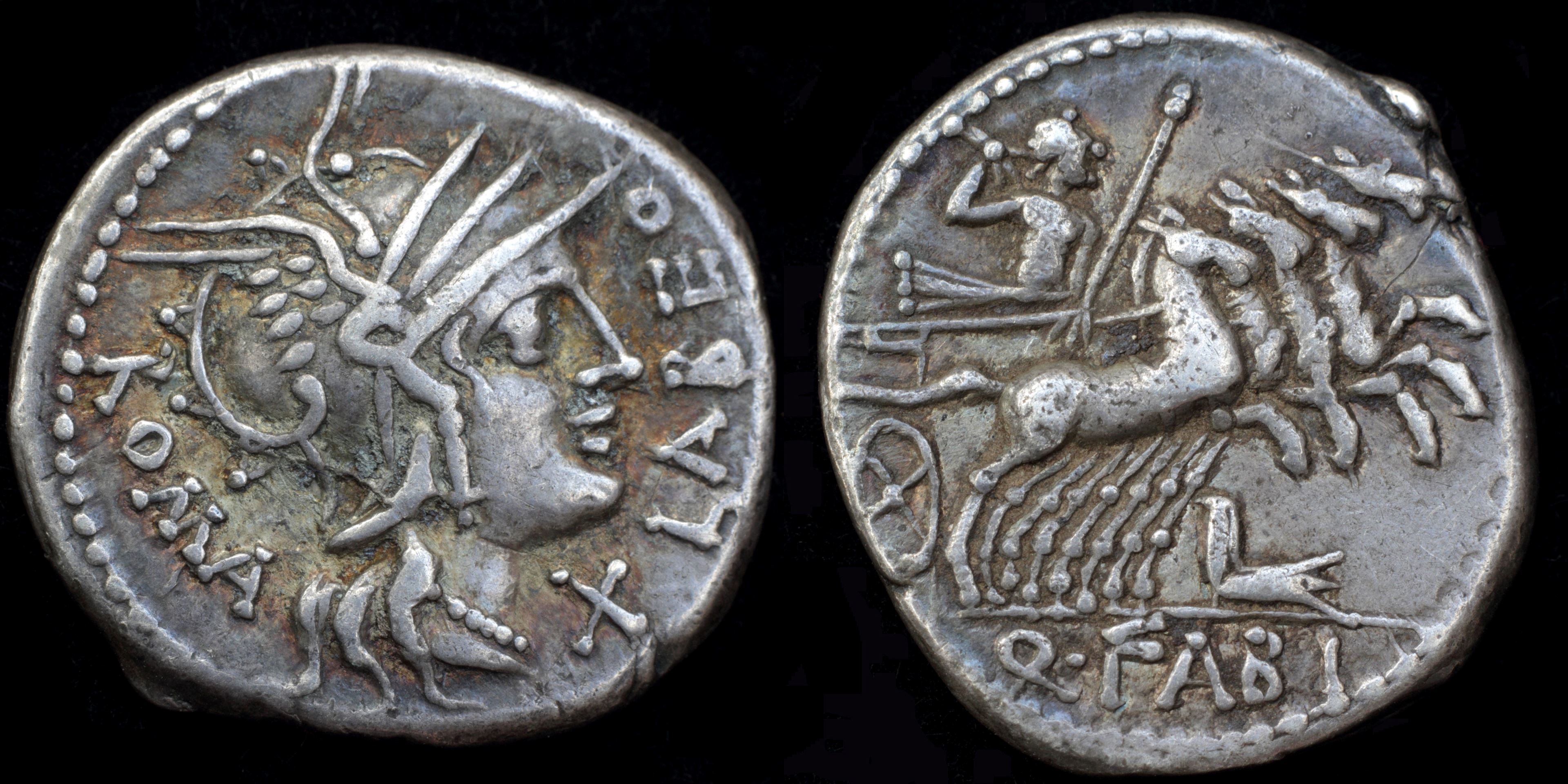
Reverse: Jupiter in quadriga right, holding reins and scepter, hurling thunderbolt, rostrum tridens below Q·FABI
Die Orientation: -
Weight: 3.9 g
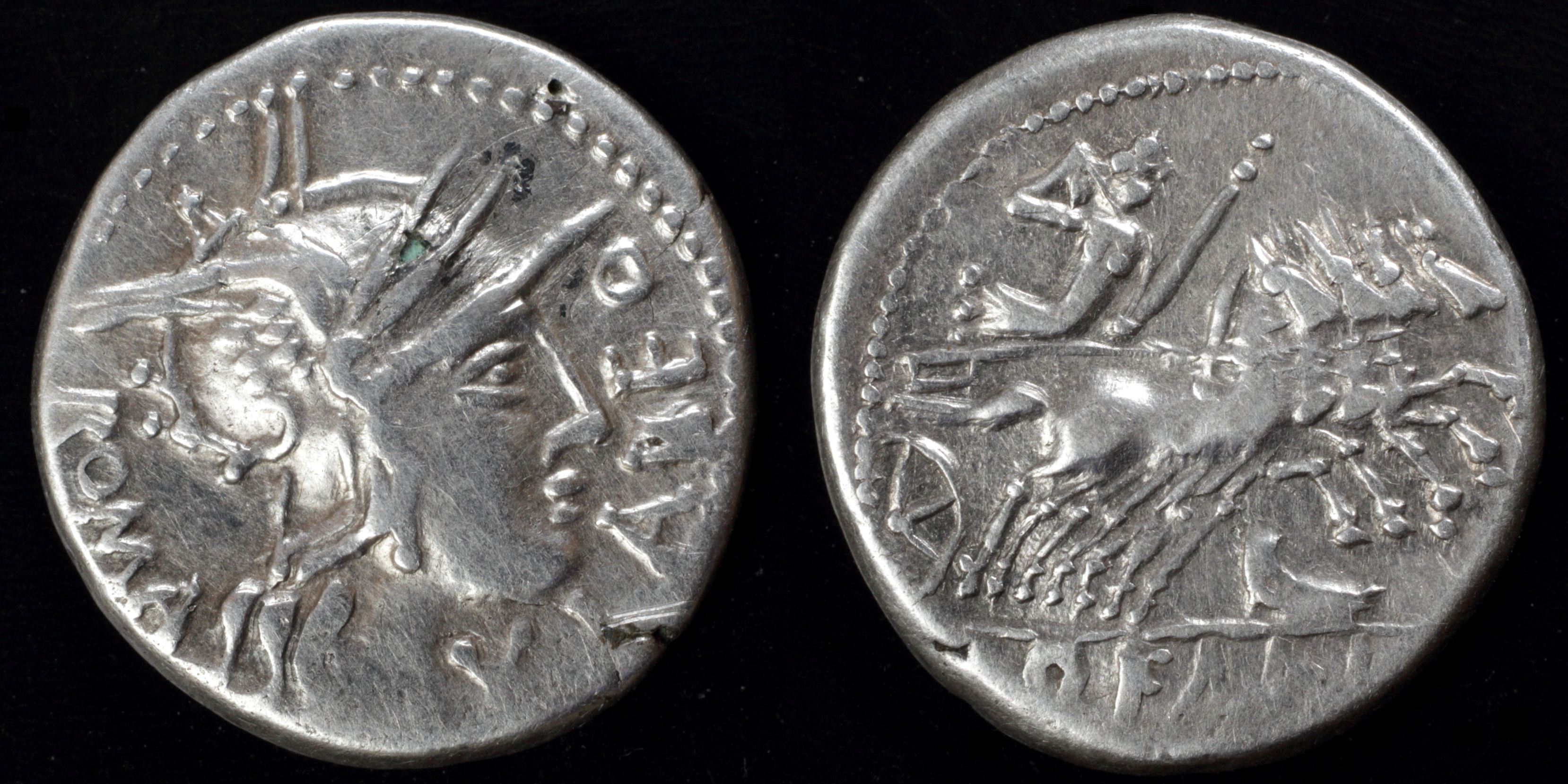
Reverse: Jupiter in quadriga right, holding reins and scepter, hurling thunderbolt, rostrum tridens below Q·FABI
Die Orientation: -
Weight: 3.1 g
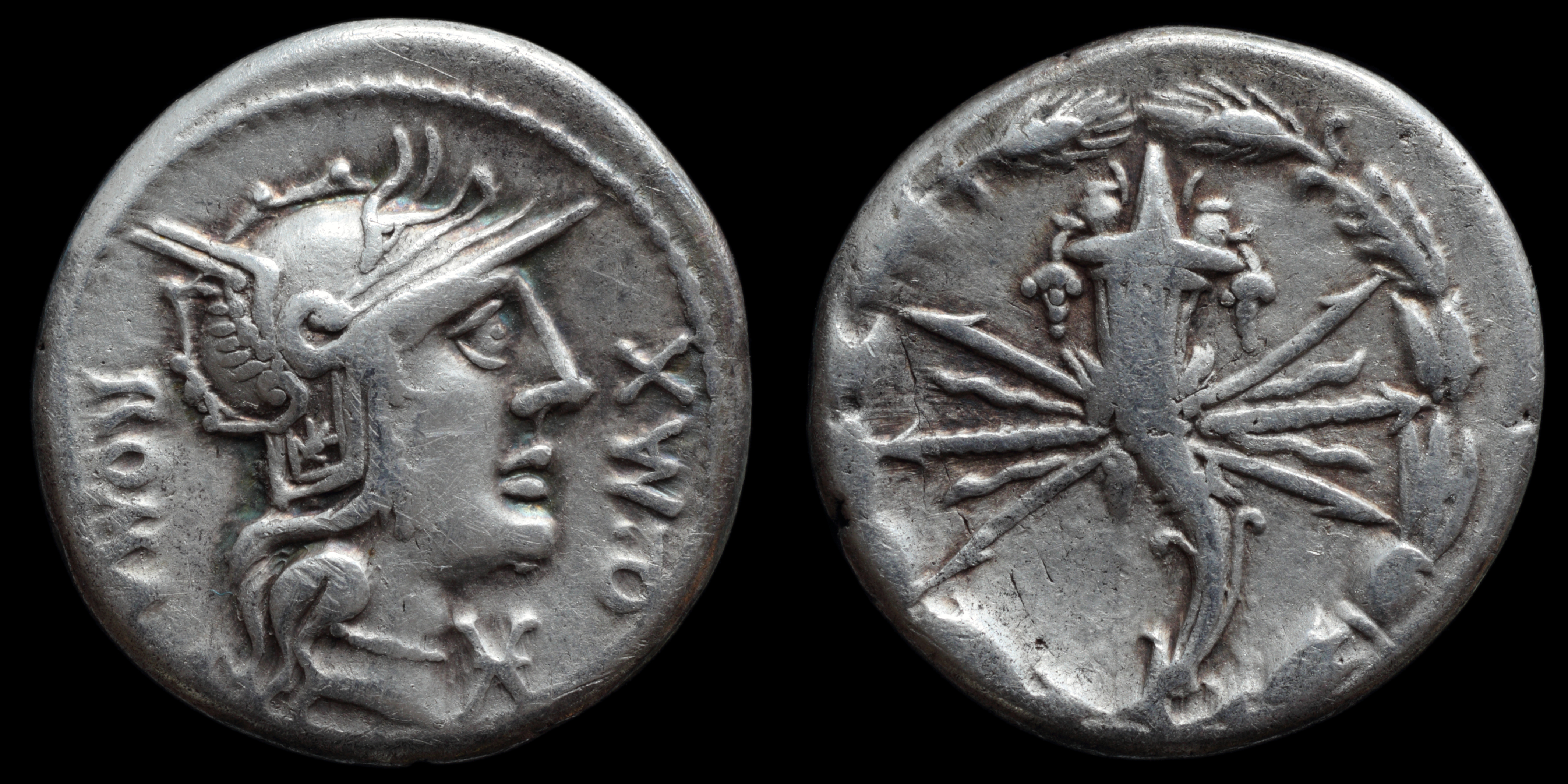
Reverse: Cornucopiae on thunderbolt within wreath of ear of barley and wheat with assorted fruits
Die Orientation: -
Weight: 3.9 g
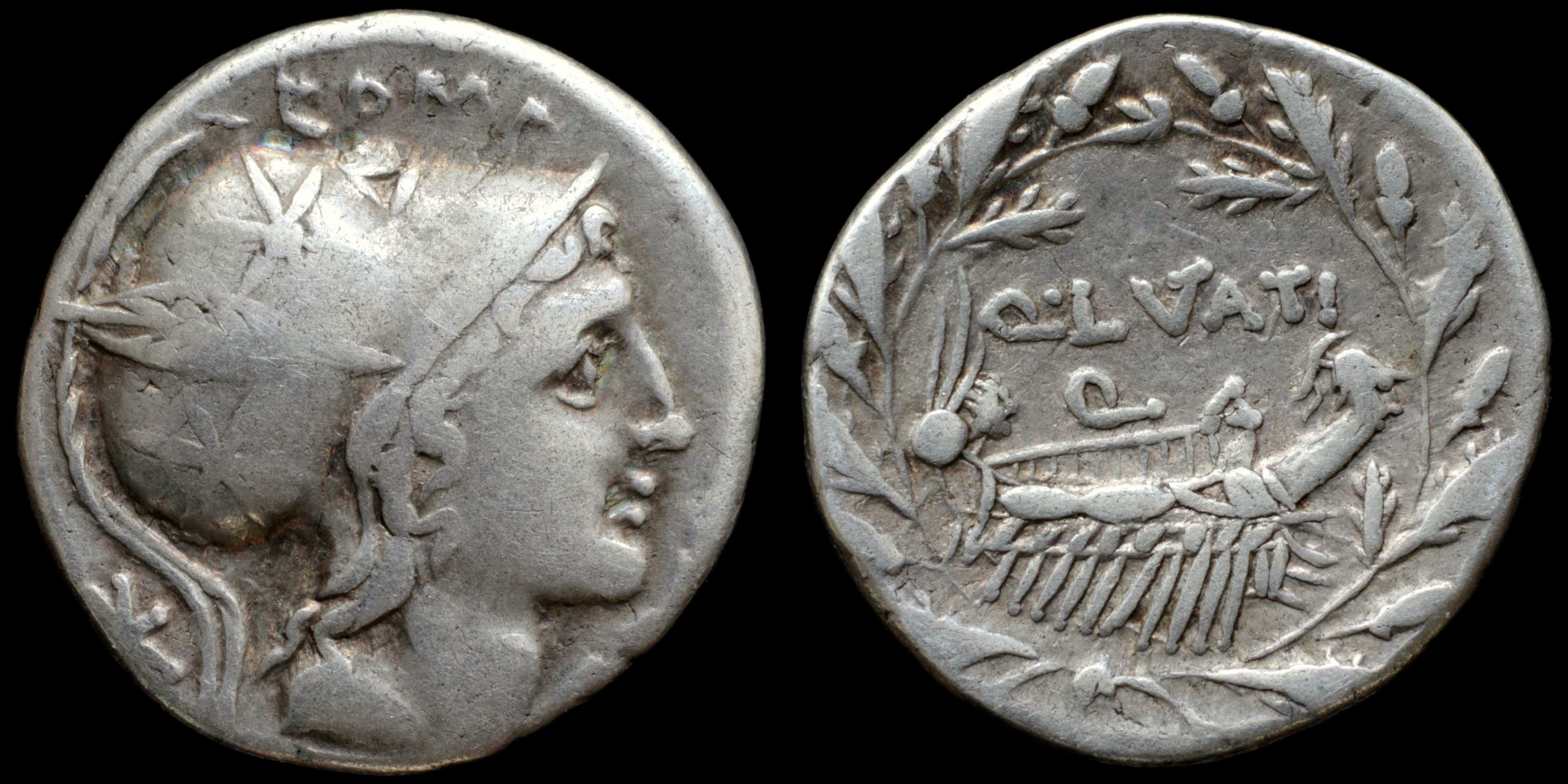
Reverse: war galley right, all within oak wreath; Q·L(VT)ATI / Q
Die Orientation: -
Weight: 3.8 g
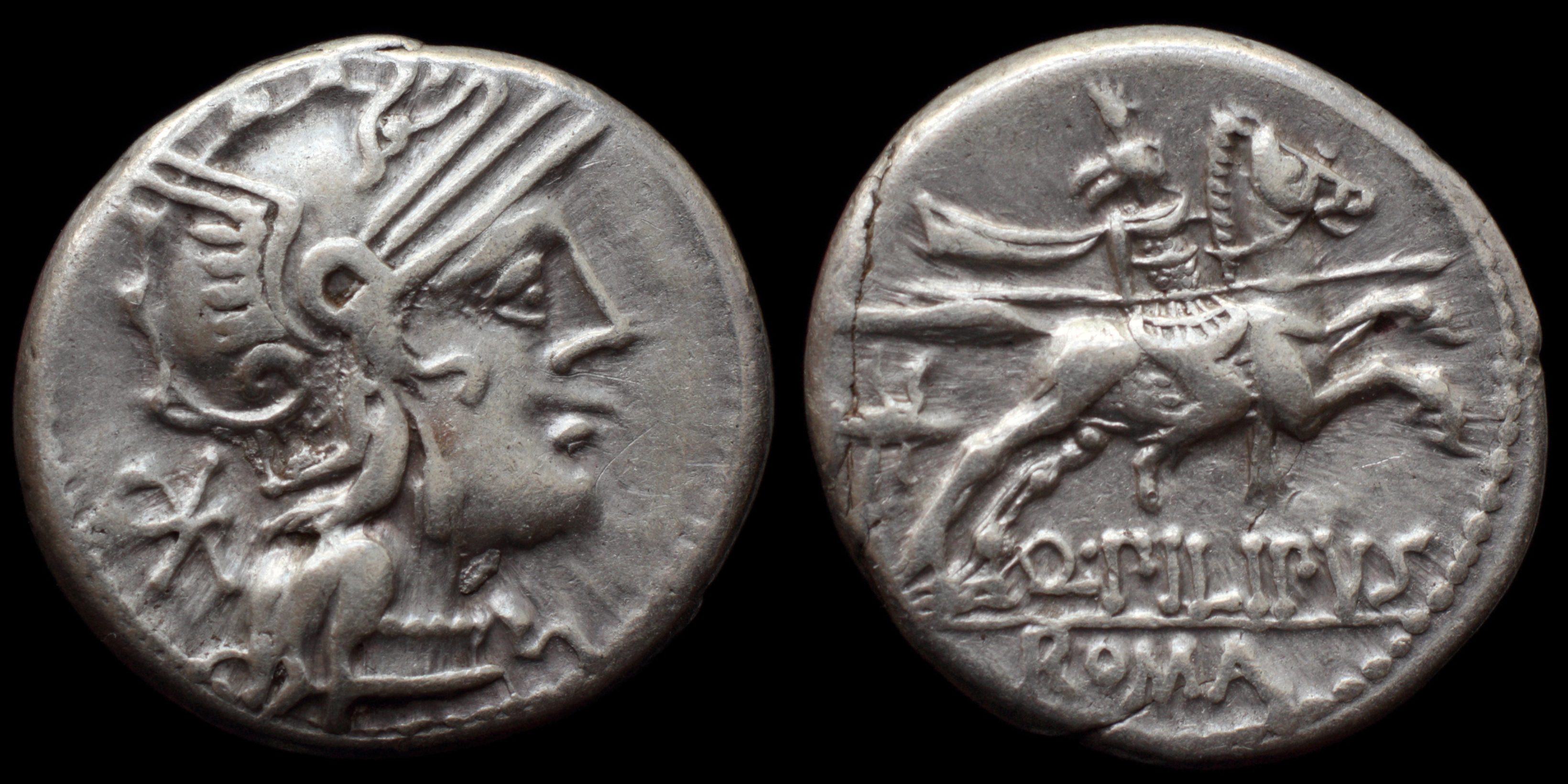
Reverse: Philip V galloping on horse right wearing Macedonian helmet with goat's horns; Q·PILIPVS / ROMA
Die Orientation: -
Weight: 3.8 g
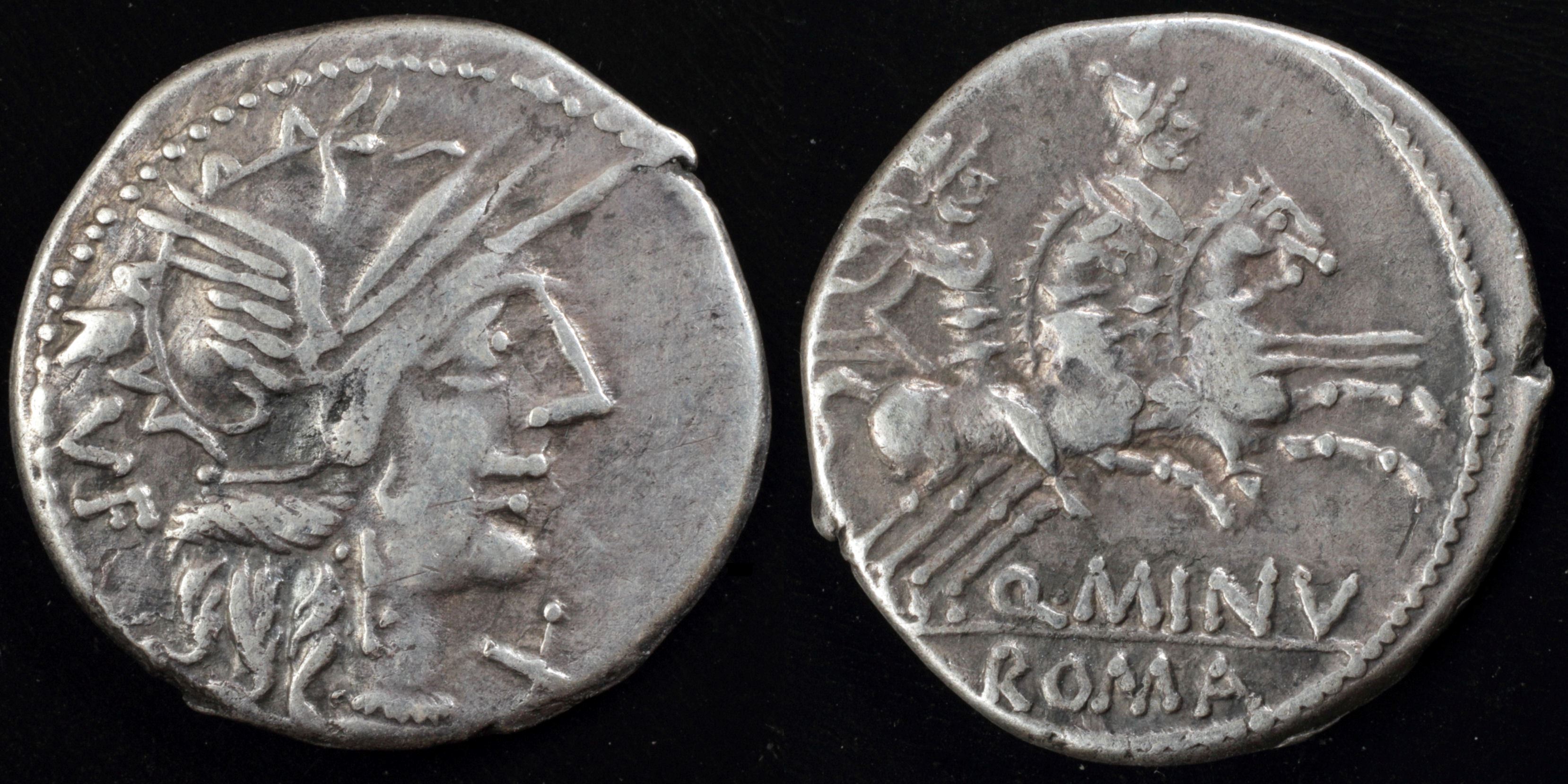
Reverse: Dioscuri riding on horses right, holding spear Q·MINV ROMA
Die Orientation: -
Weight: 2.9 g
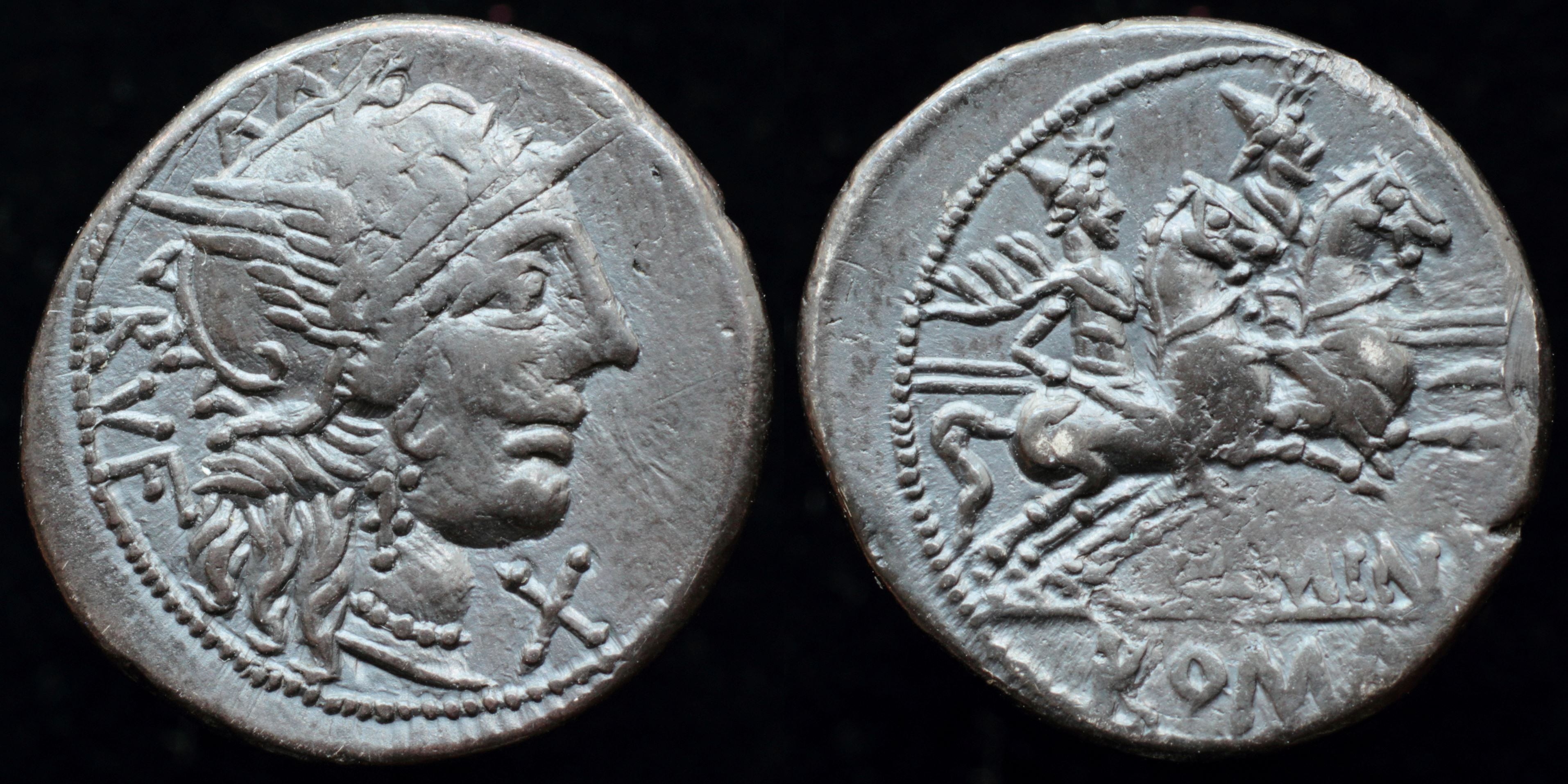
Reverse: Dioscuri riding on horses right, holding spear Q·MINV ROMA
Die Orientation: -
Weight: 3.9 g
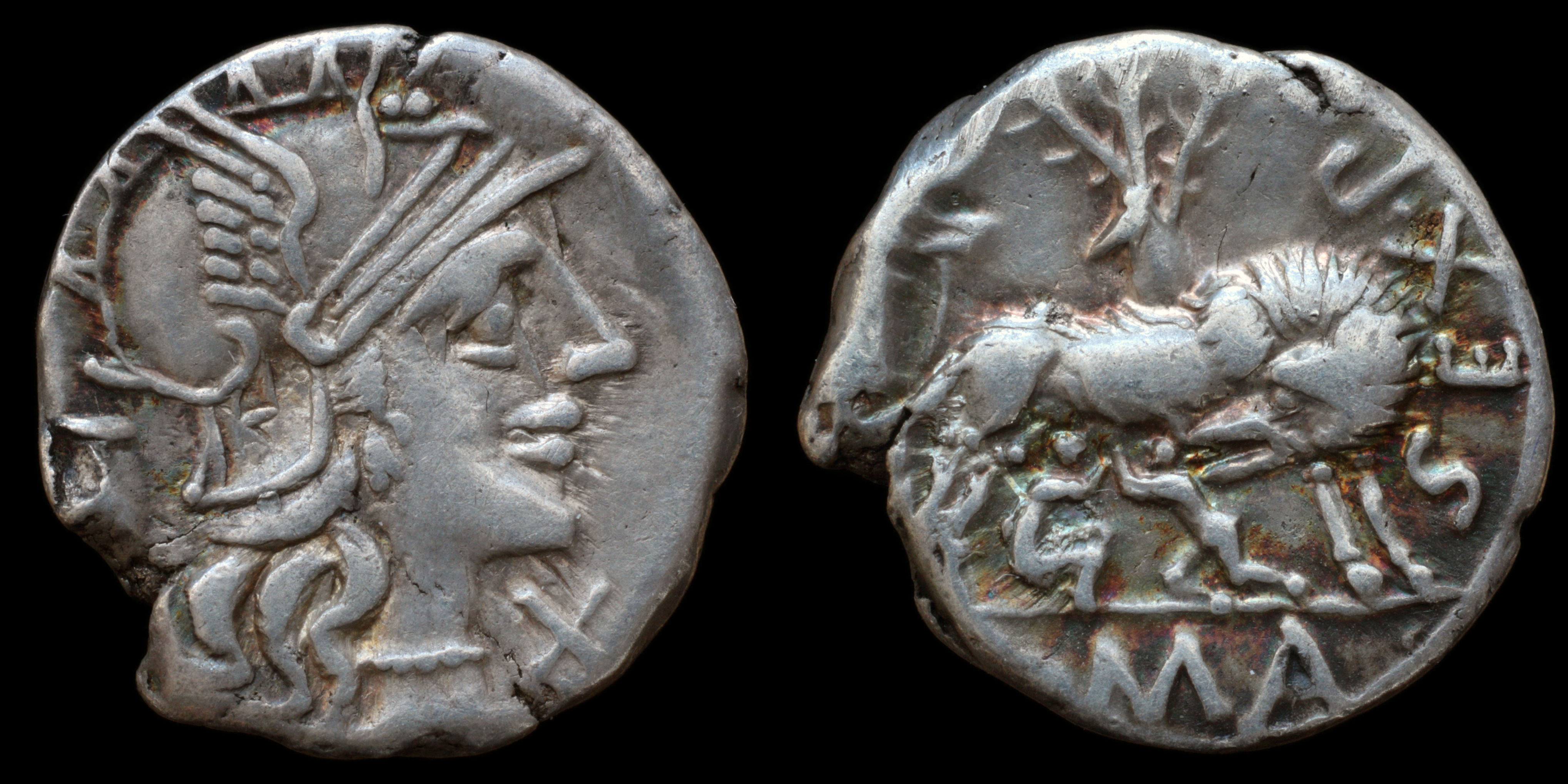
Reverse: she-wolf right, head turned back, breastfeeding Romulus and Remus; behind fig tree with bird on trunk and two on branches; shepherd Faustulus standing right; SEX PO__FOSTLVS / ROMA
Die Orientation: -
Weight: 3.9 g
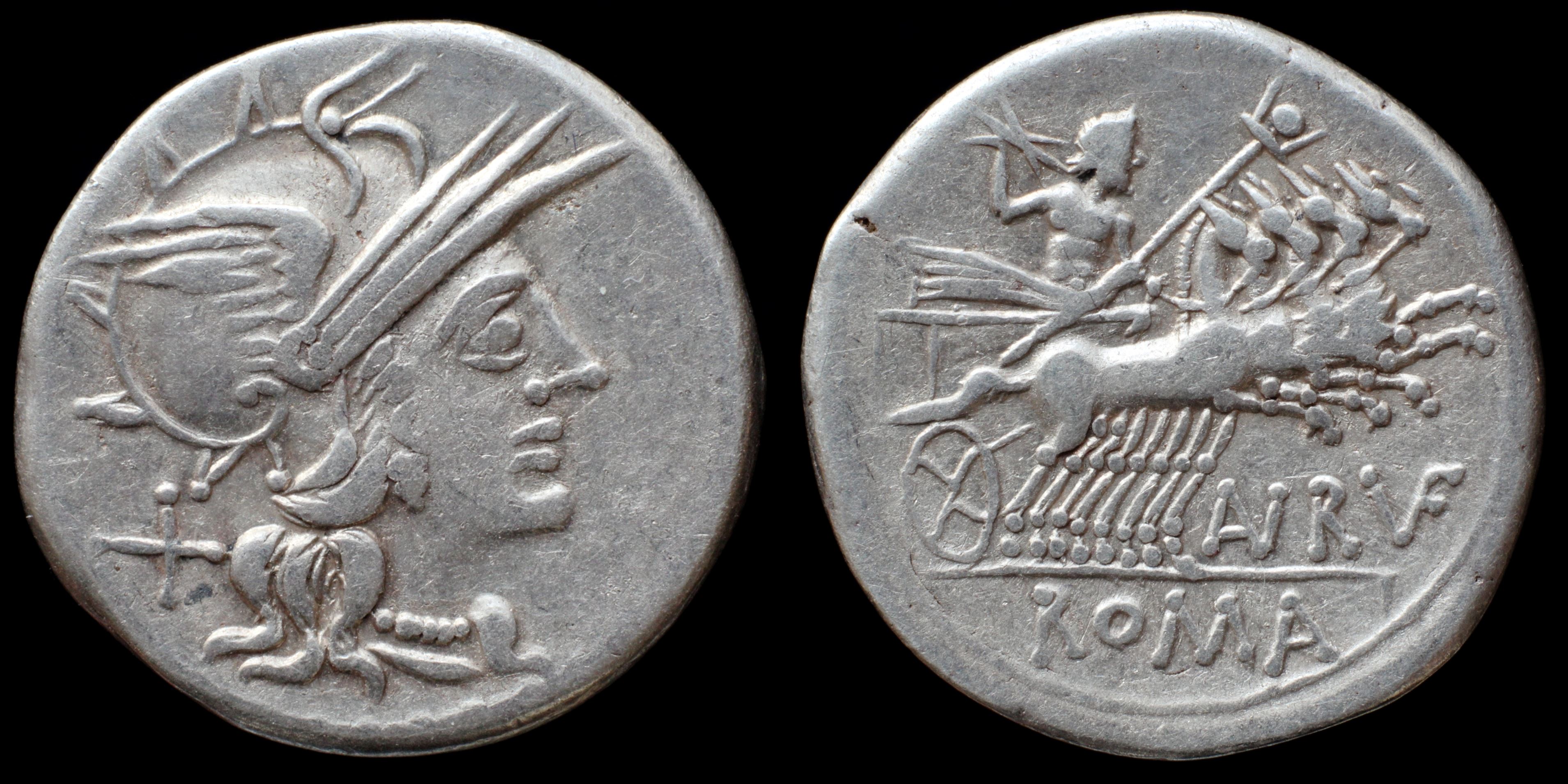
Reverse: Jupiter in quadriga right, hurling thunderbolt and holding reins and scepter; (AN) R(VF) / ROMA
Die Orientation: -
Weight: 3.9 g
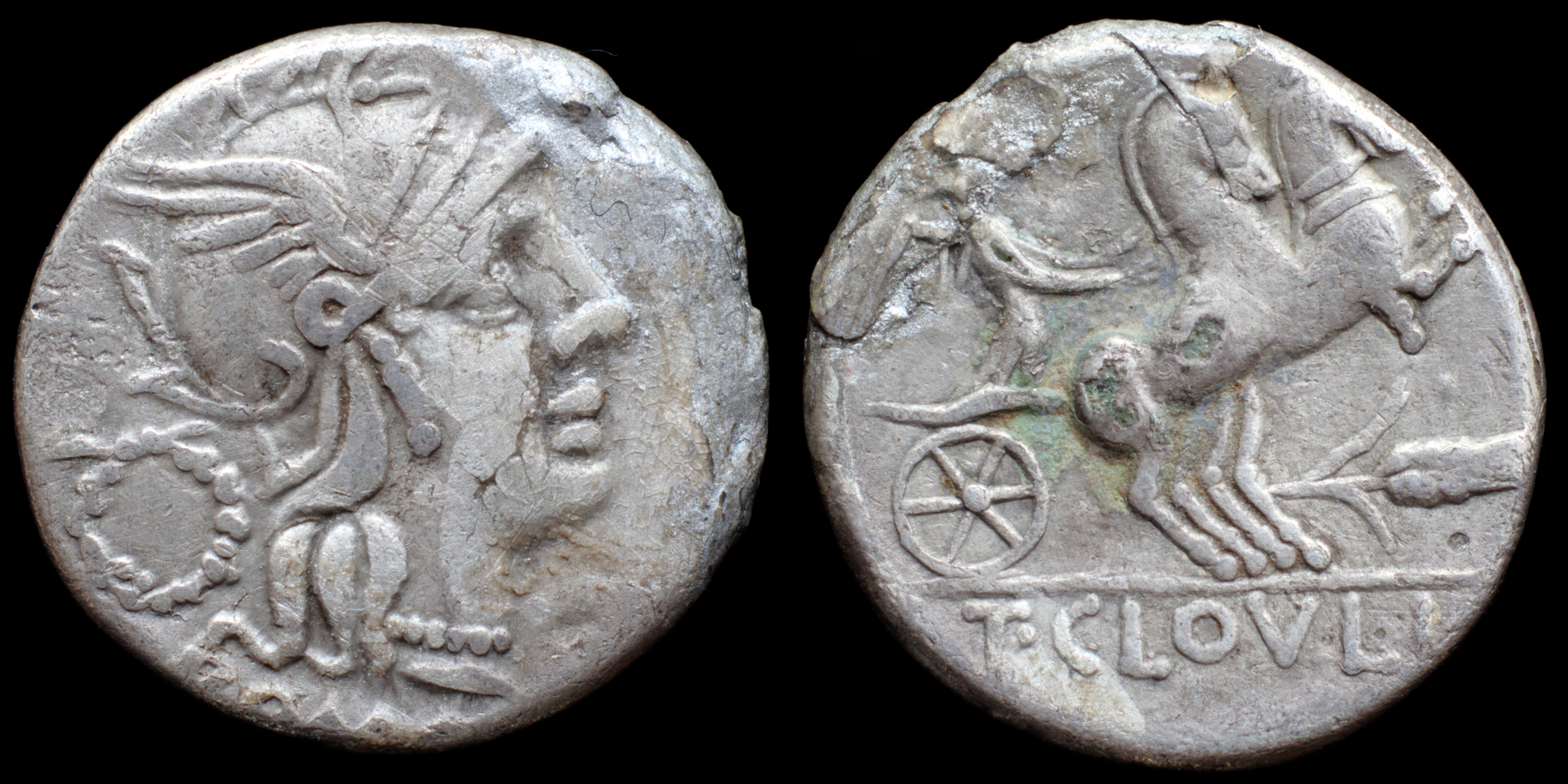
Reverse: Victory in biga right, horses rearing, grain ear below T·CLOVLI
Die Orientation: -
Weight: 2.7 g
unofficial issue - fouré denarius Absence of value mark is very unusual in this period (if it isn't hidden in wheel).
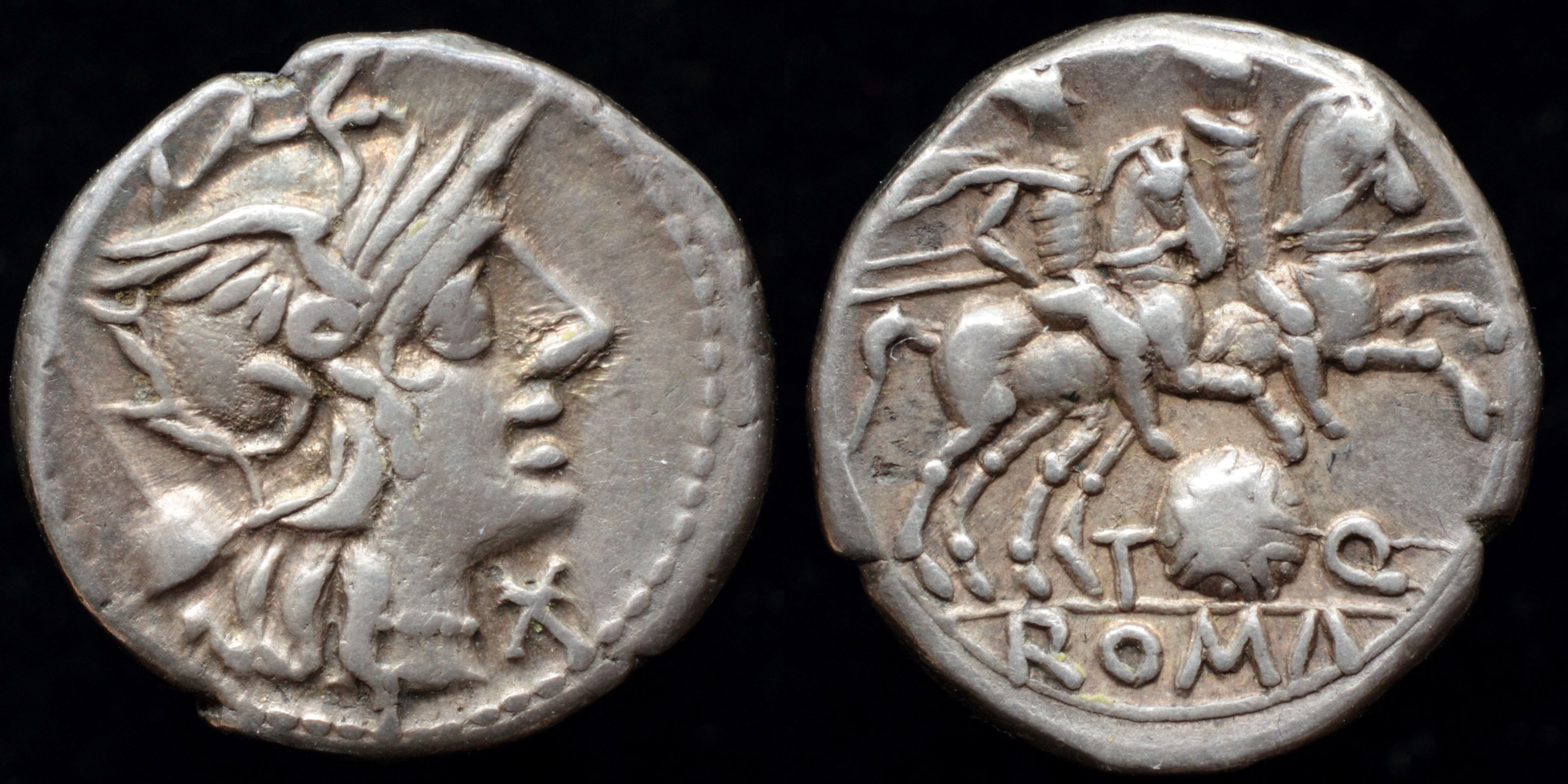
Reverse: Dioscuri right riding on horses, stars over pilei, each holding spear and reins; Macedonian shield below T_Q ROMA
Die Orientation: -
Weight: 3.9 g
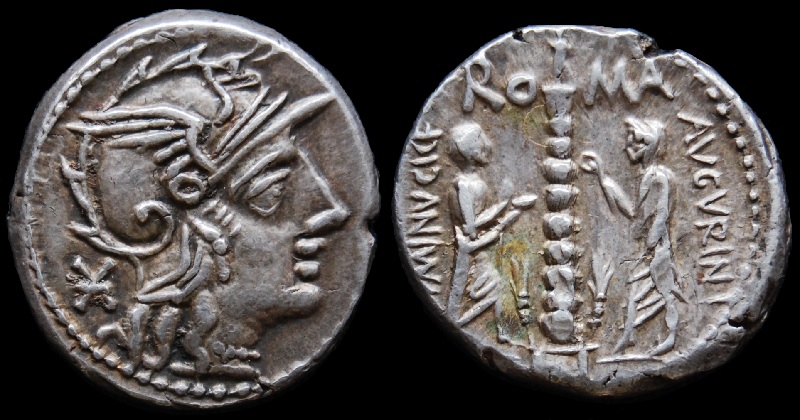
Reverse: Ionic column surmounted by statue; at base, two grain stalks; on left, L. Minucius Augurinus, holding patera, foot on modius; on right, M. Minucius Faesus , holding lituus; TI MINVCI CF upwards to left; AVGVRINI downwards to right. ROMA across fields.
Die Orientation: -
Weight: 3.97 g
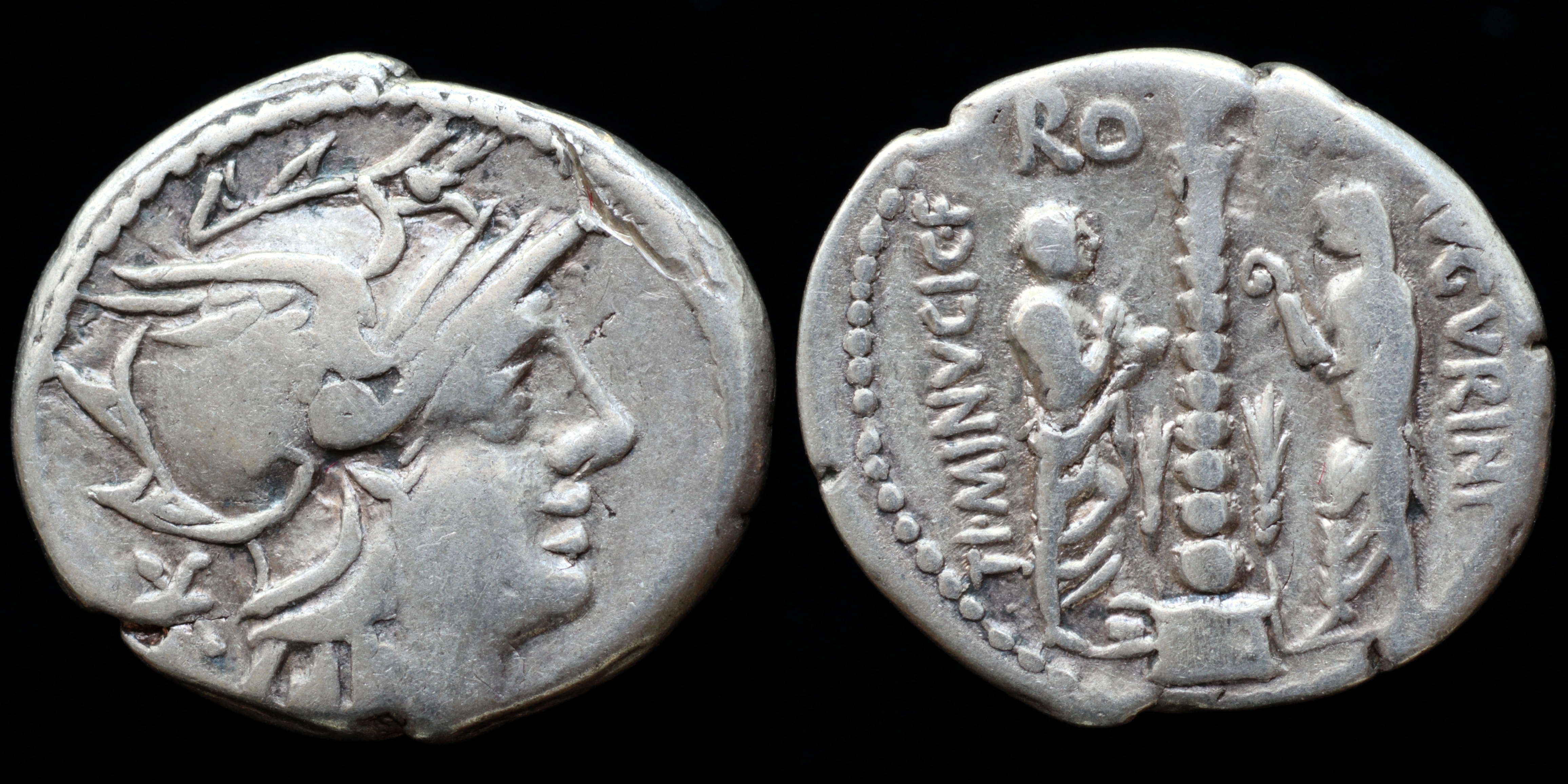
Reverse: Column surmounted by statue holding scepter, heads of grain around column; L. Minucius Augurinus standing right, wearing toga, foot on modius, holding patera; M. Minucius Faesus wearing toga, holding lituus; RO_MA / TI·MINVCI C·F__AVGVRINI
Die Orientation: -
Weight: 3.9 g
Column (Columna Minucia) surmounted by statue holding scepter, heads of grain around column; L. Minucius Augurinus (Praefectus Annonae 439 BC) standing right, wearing toga, foot on modius, holding patera; M. Minucius Faesus (Augur 300 BC) wearing toga, holding lituus
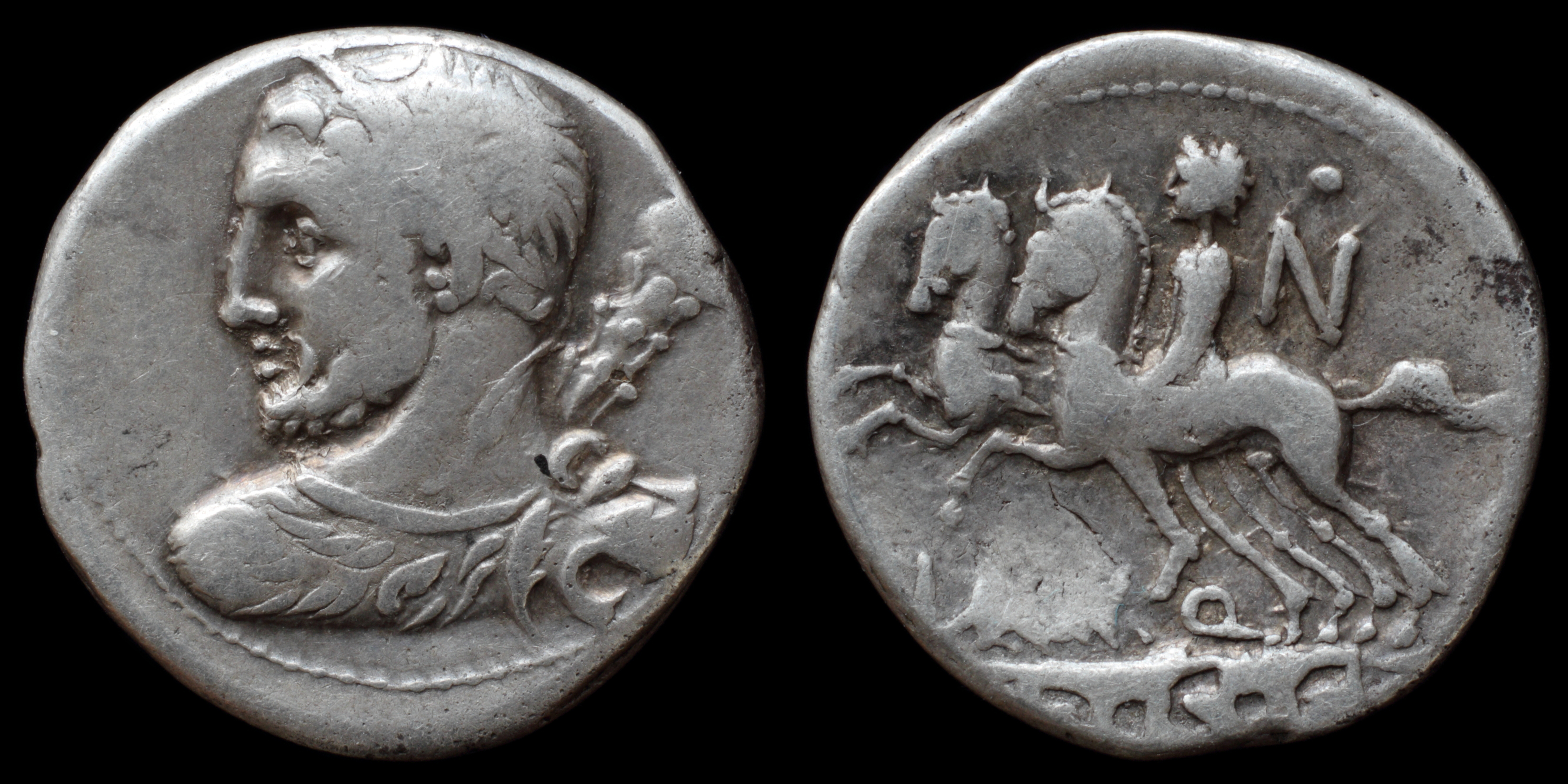
Reverse: Desultor galloping left, his second horse at his side; TI rat (control symbol) Q / • over N / D•S•S incuse on tablet
Die Orientation: -
Weight: 3.8 g
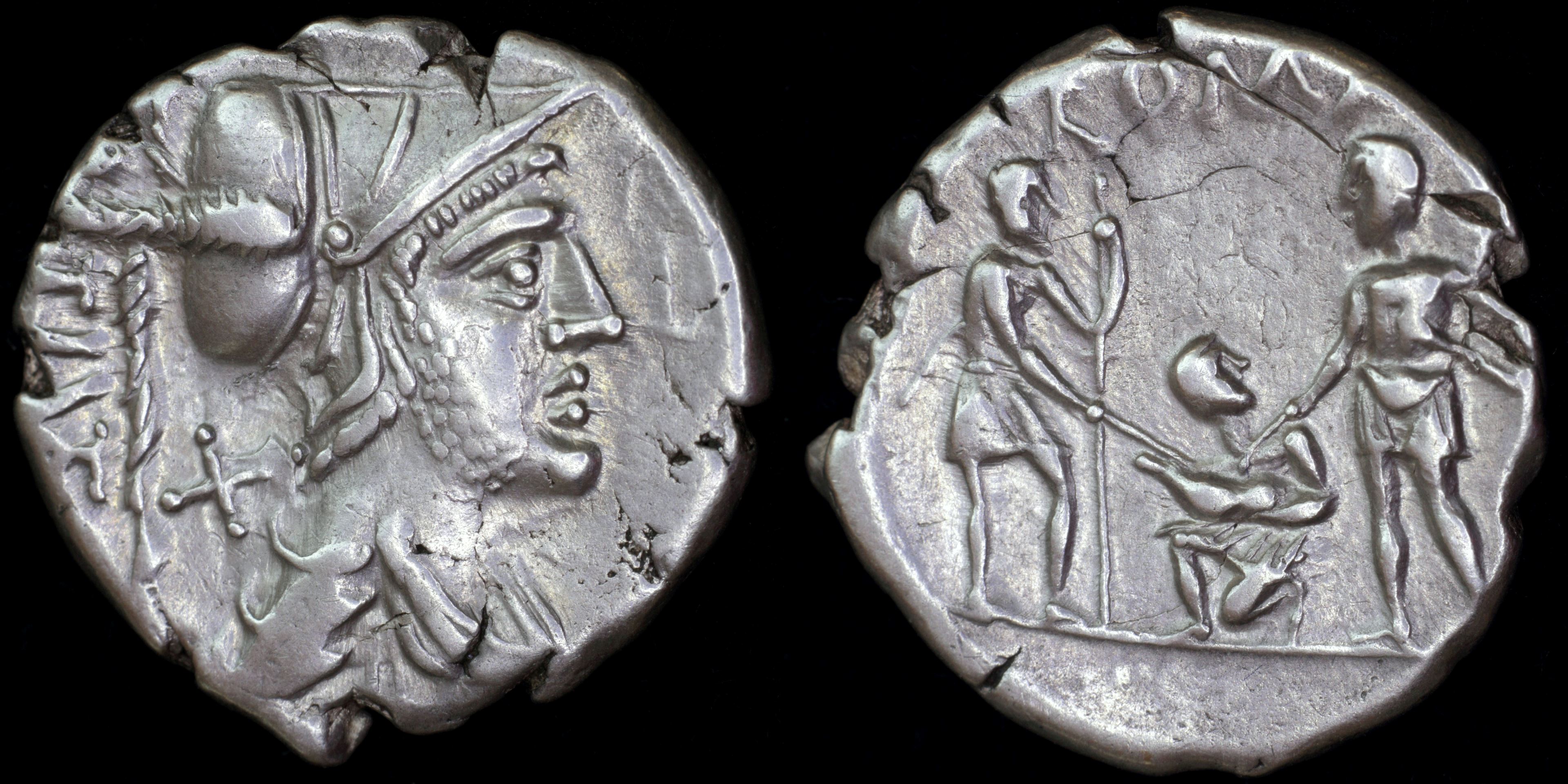
Reverse: Oath-taking scene*, two standing warriors holding spears and facing attendant kneeling in center, holding sacrificial pig. ROMA
Die Orientation: -
Weight: 3.9 g
